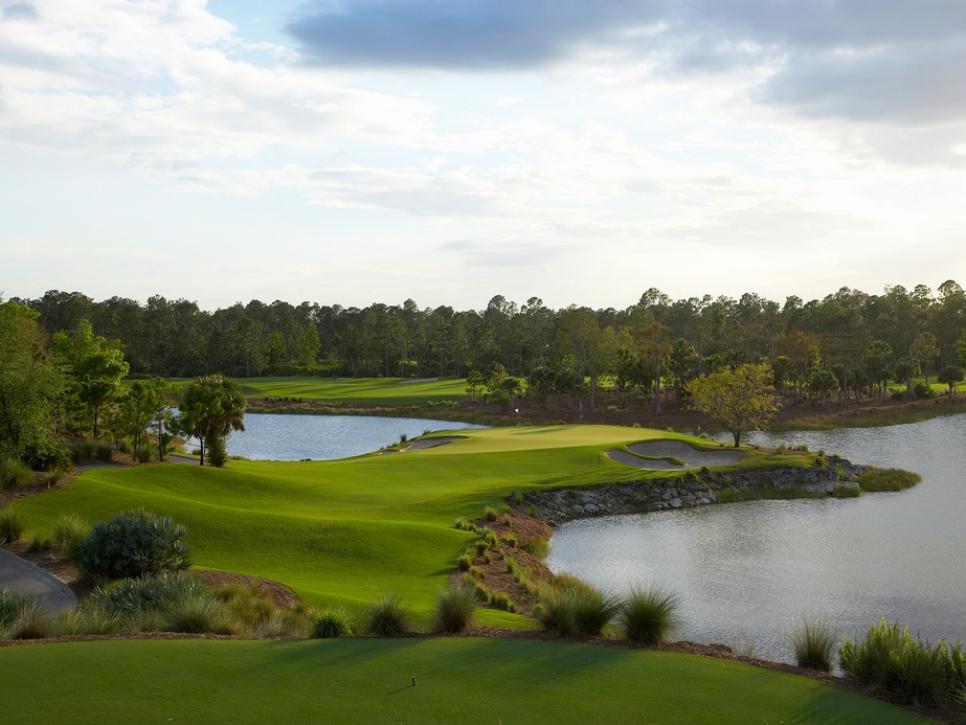Golf Digest has been ranking golf courses for more than half a century. In February 2018, we published a World 100 ranking that included the best courses outside the United States—as a way to celebrate golf in other countries. With so much course-design work now being overseas, our editors used this as an opportunity to highlight impressive and unique designs that some of our readers may not have heard about.
In reaction to the interest that followed, Golf Digest decided to create an additional international ranking that includes courses from both lists—our America's 100 Greatest and the World 100. We know golfers love comparing courses they play to others they may have only read about. Now, this new ranking gives you more conversation for the ultimate bucket list.
1 . PINE VALLEY G.C. | Pine Valley, N.J. | George Crump & H.S. Colt (1918) | 7,101 yards, par 70
A genuine original, its unique character forged from the sandy pine barrens of southwest Jersey. Founder George Crump had help from now-legendary architects H.S. Colt, A.W. Tillinghast, George C. Thomas Jr. and Walter Travis. Hugh Wilson (of Merion fame) and his brother Alan finished the job. Pine Valley blends all three schools of golf design—penal, heroic and strategic—throughout the course, often times on a single hole. New tree removal at selected spots have revealed some gorgeous views of the sandy landscape upon which the course is routed.
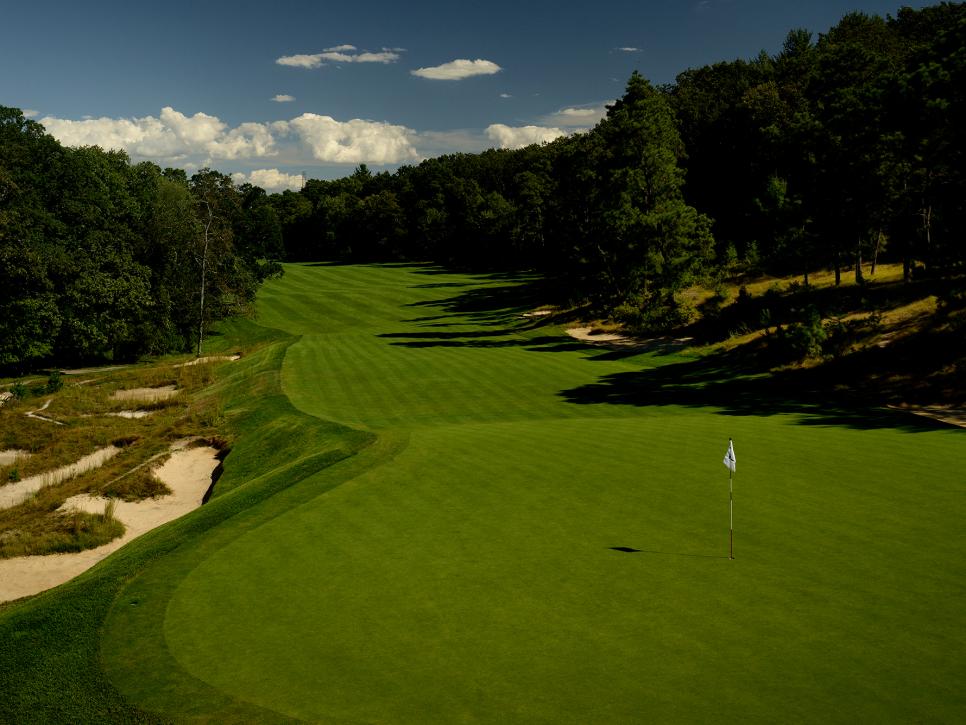
Dom Furore
2 . AUGUSTA NATIONAL G.C. | Augusta, Ga. | Alister MacKenzie & Bobby Jones (1933) | 7,435 yards, par 72
No club has tinkered with its golf course as often or as effectively over the decades as has Augusta National Golf Club, mainly to keep it competitive for the annual Masters Tournament, an event it has conducted since 1934, with time off during WWII. All that tinkering has resulted in an amalgamation of design ideas, with a routing by Alister Mackenzie and Bobby Jones, some Perry Maxwell greens, some Trent Jones water hazards, some Jack Nicklaus mounds and swales and, most recently, extensive rebunkering and tree planting by Tom Fazio. The tinkering may soon continue if the club, as reported, closes on a deal with adjacent Augusta Country Club to buy a portion of land that will allow the famed par-5 13th to be lengthened.
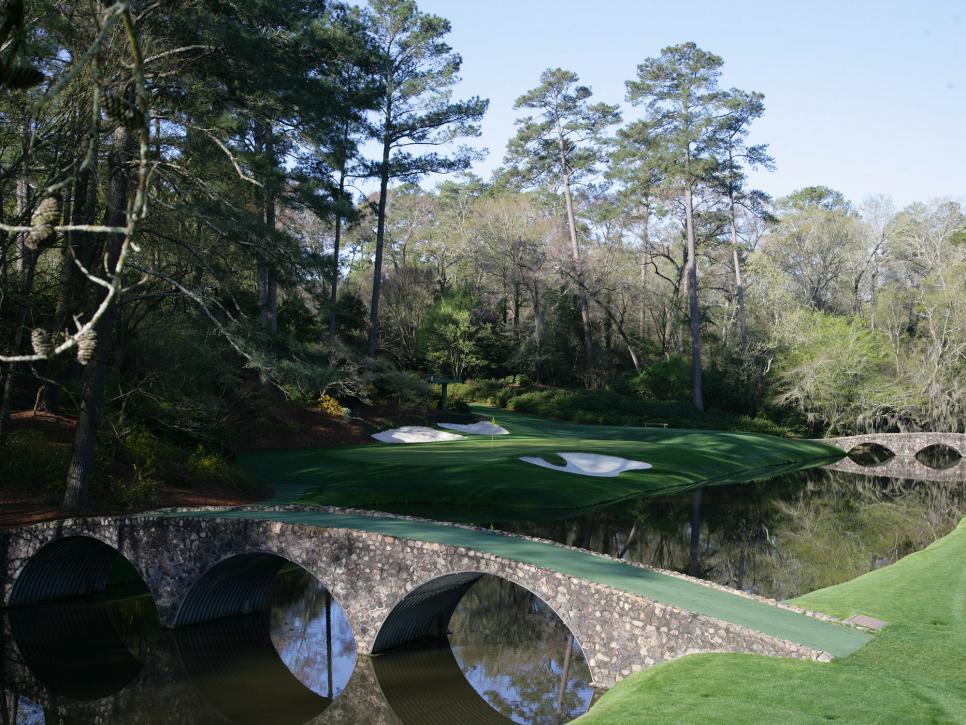
3 . ROYAL COUNTY DOWN G.C. (CHAMPIONSHIP) | Newcastle, Northern Ireland | Old Tom Morris (1889) | 7,186 yards, par 71
On a clear spring day, with Dundrum Bay to the east, the Mountains of Mourne to the south and gorse-covered dunes in golden bloom, there is no lovelier place in golf. The design is attributed to Old Tom Morris but was refined by half a dozen architects in the past 120 years, most recently by Donald Steel. Though the greens are surprisingly flat, as if to compensate for the rugged terrain and numerous blind shots, bunkers are a definite highlight, most with arched eyebrows of dense marram grasses and impenetrable clumps of heather.
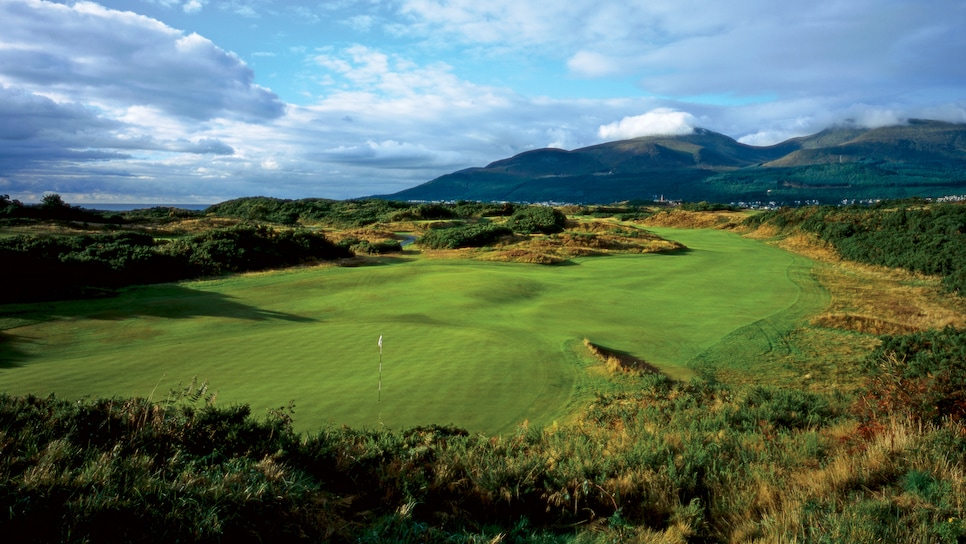
4 . ROYAL DORNOCH G.C. (CHAMPIONSHIP) | Scotland | Old Tom Morris, John Sutherland and George Duncan (1877) | 6,704 yards, par 70
Herbert Warren Wind called it the most natural course in the world. Tom Watson called it the most fun he'd had playing golf. Donald Ross called it his home, having been born in the village and learned the game on the links. Tucked in an arc of dunes along the North Sea shoreline, Dornoch's greens, some by Old Tom Morris, others by John Sutherland or 1920 Open champion George Duncan, sit mostly on plateaus and don't really favor bounce-and-run golf. That's the challenge: hitting those greens in a Dornoch wind.
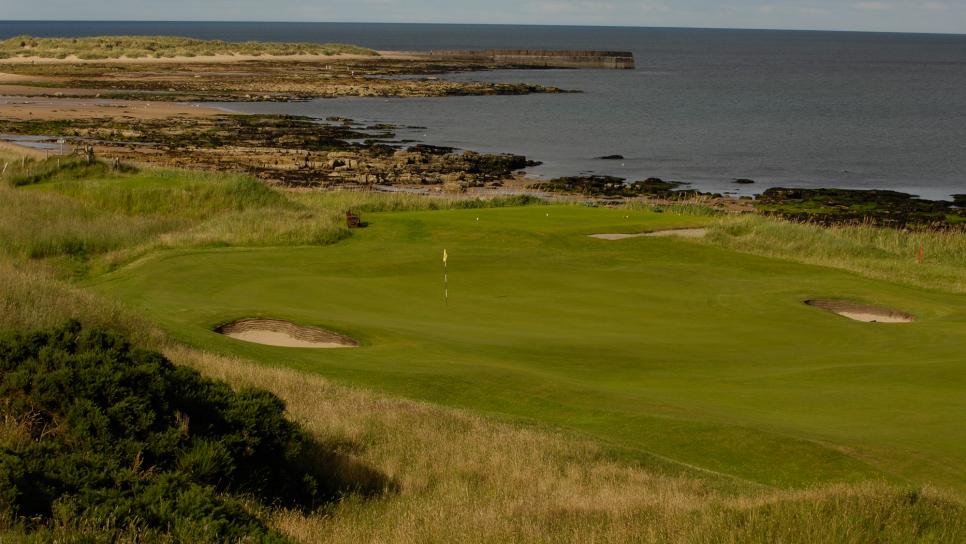
J.D. Cuban
5 . ROYAL MELBOURNE G.C. (WEST) | Black Rock, Australia | 6,645 yards, par 72
Alister MacKenzie's 1926 routing fits snuggly into the contours of the rolling sandbelt land. His greens are miniature versions of the surrounding topography. His crisp bunkering, with vertical edges, a foot or taller, chew into fairways and putting surfaces. Most holes are doglegs, so distance means nothing and angle into the pin is everything. For championships, holes 8 and 9 and 13 through 16 are skipped in favor of six from the East Course, which is ranked 28th. That "composite course" was once ranked among the best in the world by several publications.
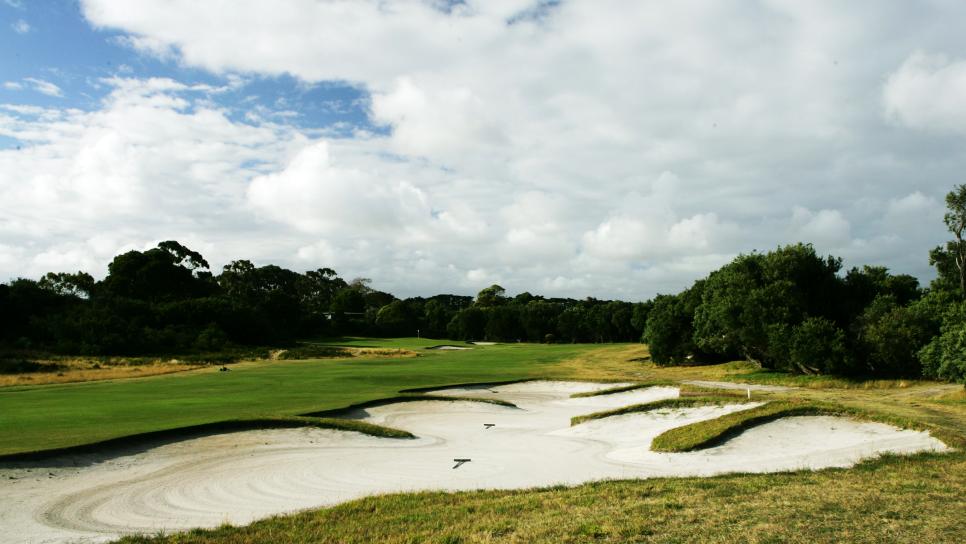
Getty Images
6 . CYPRESS POINT CLUB | Pebble Beach | Alister MacKenzie & Robert Hunter (1928) | 6,524 yards, par 72
Glamorous Cypress Point, Alister Mackenzie's masterpiece woven through cypress, sand dunes and jagged coastline, wasn't always the darling of America's 100 Greatest. Golf Digest demoted it to the Fifth Ten back in the early 1970s, saying, "It's not surprising that good players might find Cypress Point wanting: it has several easy holes and a weak finisher." Our panel has since changed its collective opinion. In the 2000s, member Sandy Tatum, the former USGA president who christened Cypress Point as the Sistine Chapel of golf, convinced the club not to combat technology by adding new back tees, but instead make a statement by celebrating its original architecture. So Cypress remains timeless, if short, its charm helped in part by superintendent Jeff Markow, who re-established Mackenzie's unique bunkering with the help of old photographs.
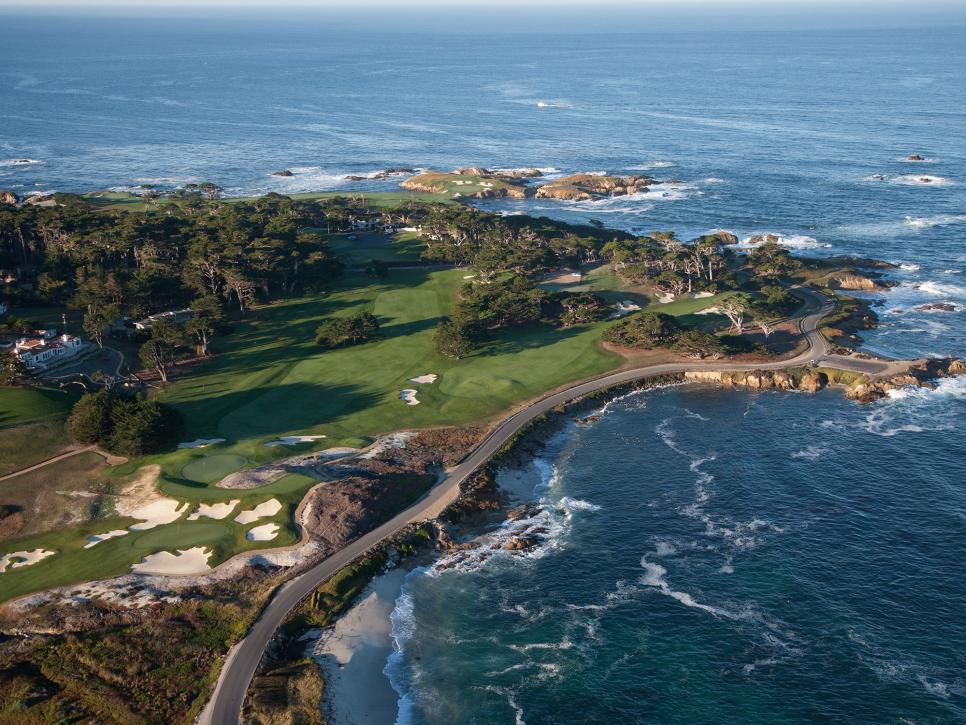
7 . MUIRFIELD | Gullane, Scotland | 7,245 yards, par 71
Muirfield is universally admired as a low-key, straightforward links with fairways seemingly containing a million traffic bumps. Except for a blind tee shot on the 11th, every shot is visible and well-defined. Greens are the correct size to fit the expected iron of approach. The routing changes direction on every hole to pose different wind conditions. The front runs clockwise, the back counterclockwise, but history mistakenly credits Old Tom Morris with Muirfield's returning nines. That was the result of H.S. Colt's 1925 redesign.

Photo by Stephen Szurlej
8 . SHINNECOCK HILLS G.C. | Southampton, N.Y. | William Flynn (1931) | 7,450 yards, par 70
Generally considered to be the earliest links in America, heavily remodeled twice by C.B. Macdonald, then replaced (except for three holes) by William S. Flynn in the early 1930s. It's so sublime that its architecture hasn't really been altered for nearly 50 years, until the team of Bill Coore and Ben Crenshaw made several changes in 2012, including restoration of a massive waste area on the sixth hole, to prepare Shinnecock for the 2018 U.S. Open. Shinnecock will also host the 2026 U.S. Open.
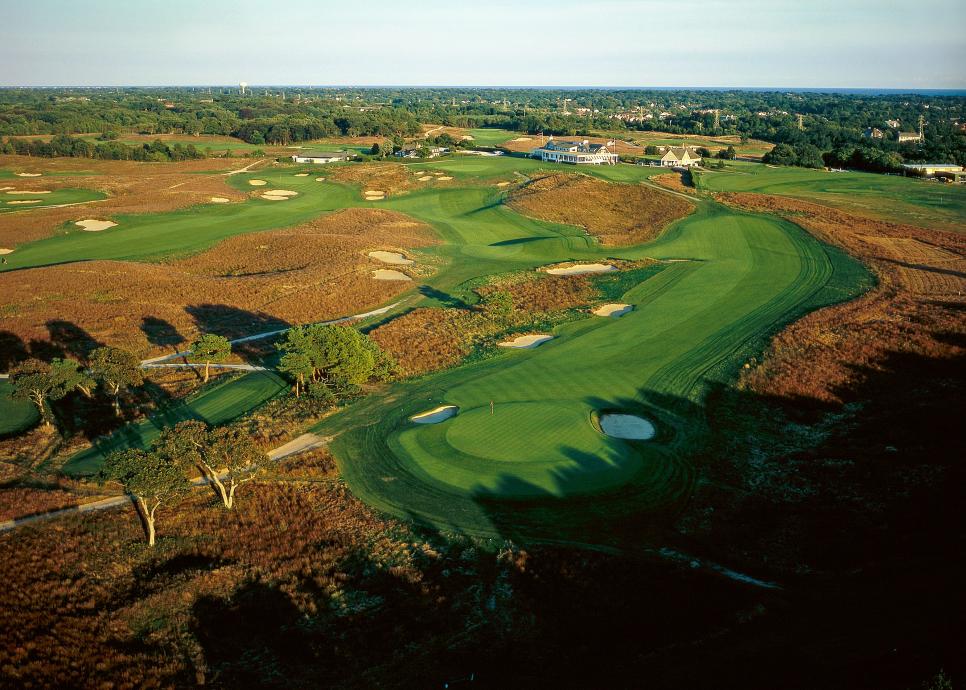
9 . THE OLD COURSE AT ST. ANDREWS | Fife, Scotland | 7,279 yards, par 72
The Old Course at St. Andrews is ground zero for all golf architecture. Every course designed since has either been in response to one or more of its features, or in reaction against it. Architects either favor the Old Course's blind shots or detest them, either embrace St. Andrews' enormous greens or consider them a waste of turf. Latest polarizing topic: Martin Hawtree's design changes in advance of the 2015 Open Championship, which many considered blasphemy beforehand. After Zach Johnson's dramatic overtime victory, few mentioned the alterations. For the first time ever, the Old Course will host the Senior Open Championship in 2018.
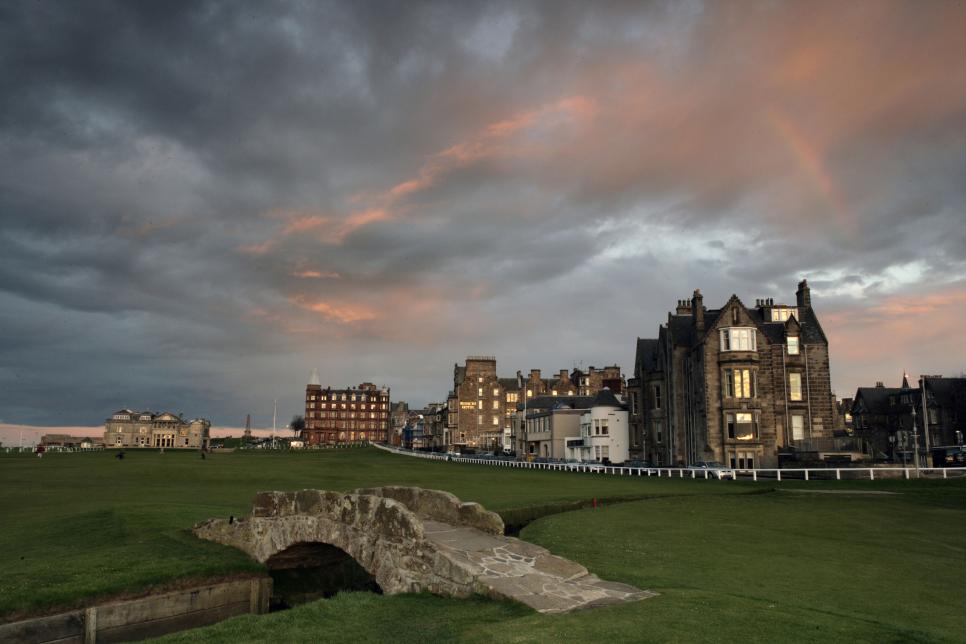
10 . OAKMONT C.C. | Oakmont, Pa. | Henry Fownes (1903) | 7,254 Yards, par 71
Once tens of thousands of trees (mostly planted in the 1960s) were removed, Oakmont's original penal design was re-established, with the game's nastiest, most notorious bunkers (founder-architect H.C. Fownes staked out bunkers whenever and wherever he saw a player hit an offline shot), deep drainage ditches and ankle-deep rough. Oakmont also has the game's swiftest putting surfaces, which were showcased during the U.S. Open in 2016, despite early rains that slowed them down a bit. The U.S.G.A. has already awarded the 2025 U.S. Open to Oakmont again, reinforcing its title as it the Host of the Most U.S. Opens ever.

11 . TARA ITI G.C. | Mangawhai, New Zealand | 6,840 yards, par 71
Built by American designer Tom Doak from what had been a pine-covered Sahara along the eastern coast of New Zealand's North Island, it's far more links-like than the country's other coastal courses, most of which are on rock. Doak and design associate Brian Slawnik spent more than two years gently resculpting the sandy soil into hummocks, punchbowls and sand dunes that look like they were formed by wind and vegetated by nature. There's lots of sand but no bunkers. Golfers may ground the club anywhere. With holes inspired by Cypress Point, Royal Dornoch and Royal St. George's, and views everywhere of the Hauraki Gulf, this may be New Zealand's answer to Pebble Beach's Carmel Bay. The greatest meeting of land and sea is clearly up for debate.

Photo by Ashley Mayo
12 . ROYAL PORTRUSH G.C. (DUNLUCE) | Northern Ireland | 7,317 yards, par 72
Portrush is still the only Irish course to host The Open. The Old Tom Morris design, reworked by H.S. Colt in the 1930s, was the Open site back in 1951, and will be again in 2019. In preparation, architect Martin Ebert added new sixth and seventh holes, fashioned from land on the club's Valley Course, to replace its weak 17th and 18th. That means the notorious Calamity Hole, an uphill 210-yard par 3, will now be the 16th instead of the 14th, and the old dogleg-right par-4 16th will now be the closing hole, with a new back tee. Ebert retained Colt's greens, considered one of the best set of putting surfaces in the world.

David Cannon/Getty Images
13 . MERION G.C. (EAST) | Ardmore, Pa. | Hugh Wilson (1912) | 6,592 Yards, par 70
What a delight it was to see Merion East, long considered the best course on the tightest acreage in America, host the U.S. Open in 2013. Today's generation of big hitters couldn't conquer the little old course, couldn't consistently hit its twisting fairways, which are edged by creeks, hodge-podge rough and OB stakes and couldn't consistently hit its canted greens edged by bunkers that stare back. It's a certainty that it won't take another 32 years for the U.S. Open to return to Merion.
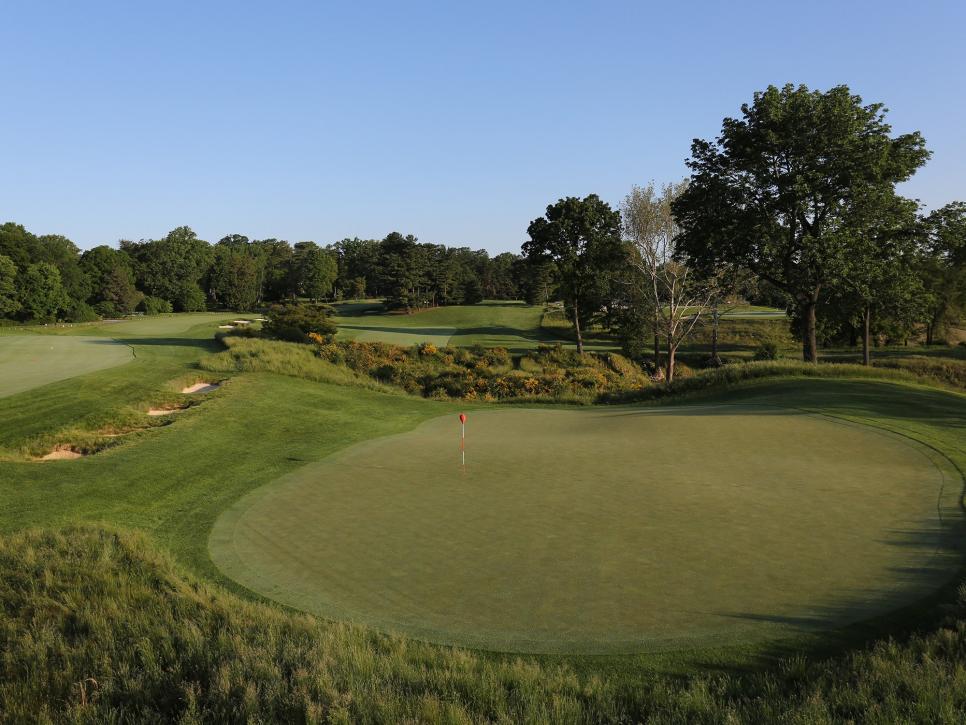
14 . SHANQIN BAY G.C. | Hainan Island, China | 6,894 yards, par 71
It has wide corridors flanked by jungle gunch, big intricate greens and eye-catching ragged-edge bunkering, yet Shanqin Bay is perhaps the most controversial design the highly regarded firm of Bill Coore and Ben Crenshaw has ever built. Partly because it was created on a site far more rugged than the duo normally tackle—land that housed a World War II Army barracks, complete with stone tunnels. Coore's routing manages to traverse the mountainous property, but only with the help of some blind shots, two holes around an artificial irrigation pond and a very unusual finish with two drivable par 4s among the last three holes. All its quirks are worth it, for its proximity along the South China Sea is outstanding.

Courtesy of Shanqin Bay G.C.
15 . PEBBLE BEACH G. LINKS | Pebble Beach | Jack Neville & Douglas Grant (1919) | 6,828 yards, par 72
Not just the greatest meeting of land and sea in American golf, but the most extensive one, too, with nine holes perched immediately above the crashing Pacific surf -- the fourth through 10th, plus the 17th and 18th. Pebble's sixth through eighth are golf's real Amen Corner, with a few Hail Marys thrown in over a ocean cove on eight from atop a 75-foot-high bluff. Pebble will host another U.S. Amateur in 2018, and its sixth U.S. Open in 2019. Recent improvements include the redesign of the once-treacherous 14th green and a reshaping of the par-3 17th green.
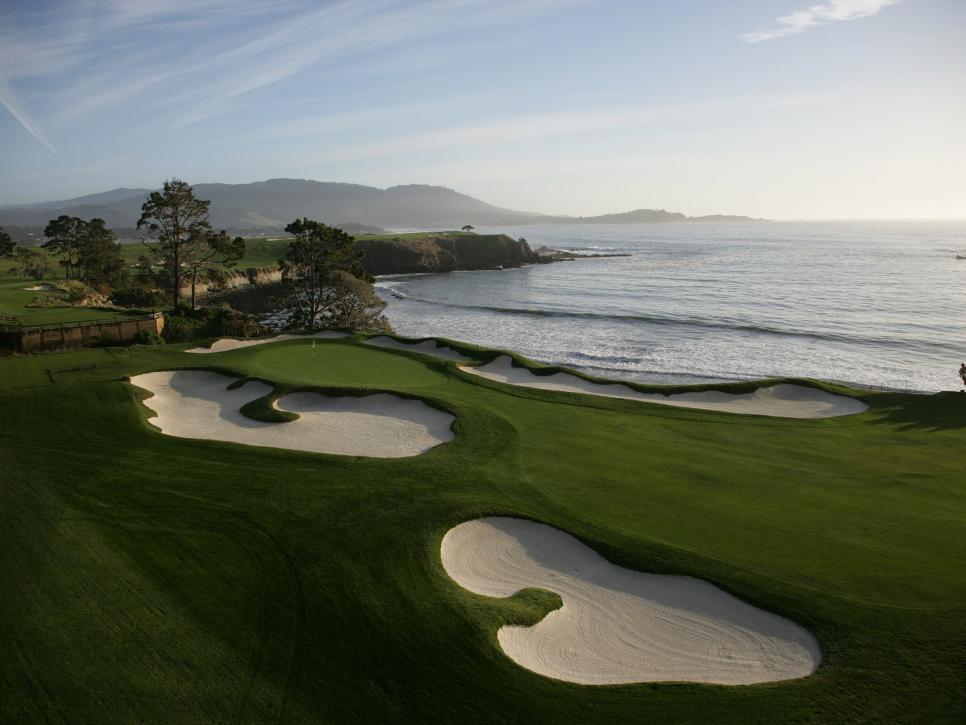
16 . NATIONAL G. LINKS OF AMERICA | Southampton, N.Y. | C.B. Macdonald (1911) | 6,957 Yards, par 72
This is where Seth Raynor got his start. A civil engineer by training, he surveyed holes for architect C.B. Macdonald, who scientifically designed National Golf Links as a fusion of his favorite features from grand old British golf holes. National Golf Links is a true links containing a marvelous collection of holes. As the 2013 Walker Cup reminded us, Macdonald's versions are actually superior in strategy to the originals, which is why National's design is still studied by golf architects today, its holes now replicated elsewhere. Hard to fathom that National Golf Links was not ranked in the 100 Greatest from 1969 until 1985.

17 . CABOT CLIFFS | Inverness, Nova Scotia, Canada | 6,765 yards, par 72
Another sensational Bill Coore and Ben Crenshaw design, Cabot Cliffs overflows with variety with its southernmost holes in Lahinch-like sand dunes, its northernmost atop Pebble Beach-type ocean cliffs and bits of pine-lined Scottish highlands in between. The course has six par 5s, including three in the space of four holes, and six par 3s, plus an additional one-shot bye-hole aside the fourth. Sporting the same fescue turf mix as nearby sister course Cabot Links (ranked No. 89th on this ranking), some tee shots seem to roll forever, but so do errant shots that miss greens. The cliff-edged par-3 16th is quickly becoming one of the game's most photographed holes.

John and Jeannine Henebry
18 . TRUMP TURNBERRY (AILSA) | Scotland | 7,489 yards, par 71
A legendary links ravaged by WWII, architect Philip Mackenzie Ross re-established it to its present quality, tearing away concrete landing strips to create a dramatic back nine and building a set of varied greens, some receptive, other not so much. After Donald Trump purchased the course, Martin Ebert of the firm of Mackenzie & Ebert made notable changes, creating new par 3s at Nos. 6 and 11, converting the old par-4 ninth into an ocean-edge par 3, and turning the fifth, 10th and 14th into par 5s and the 17th into a long par 4. New tees on 18 eliminate its old dogleg tee shot. To complete the new look, Ebert replaced revetted bunkers with ragged-edged ones.

Courtesy of Trump Turnberry
19 . BARNBOUGLE DUNES | Bridport, Australia | 6,724 yards, par 71
A 2004 collaboration of American superstar designer Tom Doak and Australian tour-pro-turned-architect Michael Clayton, Barnbougle Dunes is a tremendous 18 in a fantastic stretch of sand dunes along Bass Strait, the sea that separates Tasmania from Melbourne. What's most fascinating is that the back nine is completely reversed from how Doak originally routed it. So was the site so good that, once construction started, Doak and Clayton were able to find nine new green sites at the opposite ends of holes originally envisioned? Or did they create those "natural" green sites?
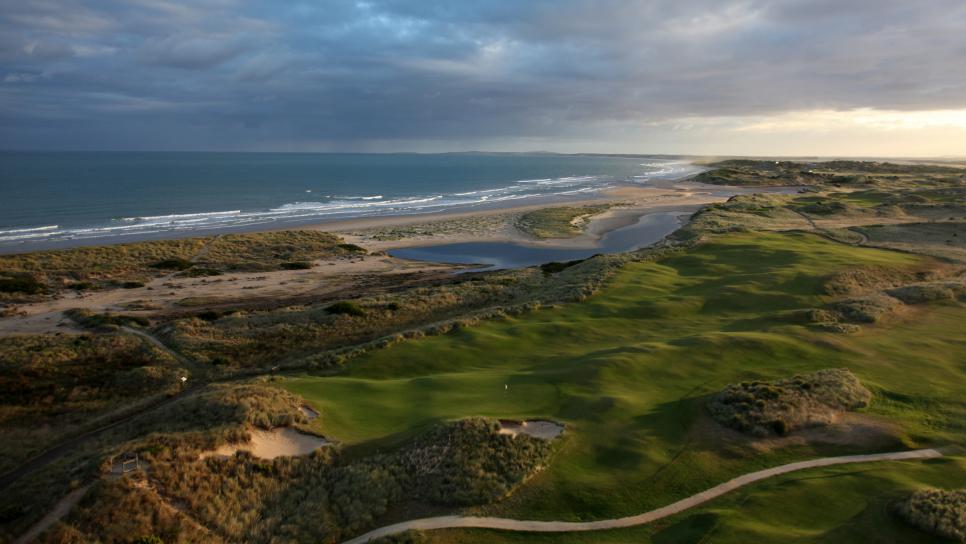
Photo by Stephen Szurlej
20 . SUNNINGDALE G.C. (OLD) | England | 6,627 yards, par 70
A Willie Park Jr. design that dates from 1901, it's perhaps the most advanced of its day. Chopped from a pine forest but routed like a links, with the ninth at the far end of the property, it plays like a links, too, for there's a sand base beneath the turf. The Old has big greens, as Park put a premium on approach putting, and artful bunkers, with both angled cross-bunkers and necklaces of sand hampering direct routes to some greens. To American visitors, the look of Sunningdale brings to mind Pine Valley or Pinehurst.
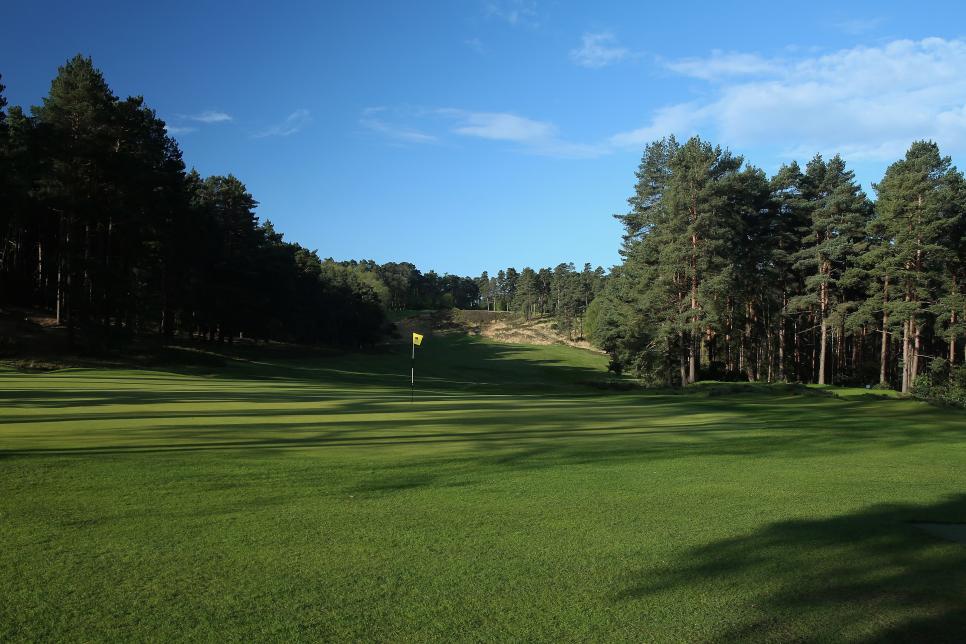
Photo by Andrew Redington /Getty Images
21 . KINGSTON HEATH G.C. | Heatherton, Australia | 7,102 yards, par 72
Considered an Alister MacKenzie design, but in fact Australian golf professional Des Soutar designed the course in 1925. MacKenzie made a brief visit the following year and suggested the bunkering, which was constructed by greenkeeper Mick Morcom before he built Royal Melbourne's two courses. The bunkers are long, sinewy, shaggy, gnarly, windswept and, of course, strategically placed. Some say MacKenzie's tee-to-green stretch of bunkers on the par-3 15th set the standard for all Sandbelt layouts.
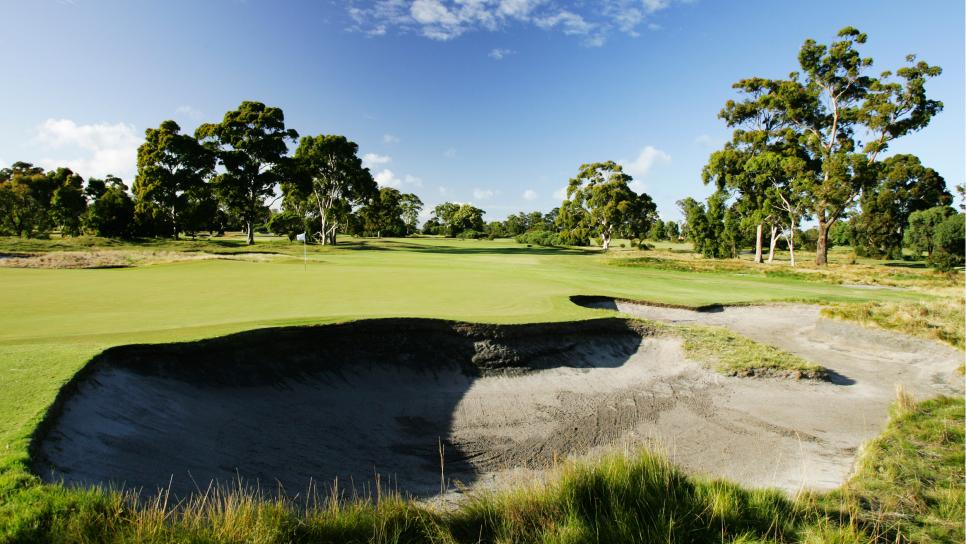
David Cannon/Getty Images
22 . MORFONTAINE G.C. | France | 6,584 yards, par 70
A timeless 1927 design north of Paris by British architect Tom Simpson, Morfontaine looks suspiciously like a heathland course around London, with windswept Scotch pines and clumps of heather atop a base of sand. But it's tighter than Sunningdale or St. George's Hill, and the forest surrounding holes is far denser. Thirteen years ago, American architect Kyle Phillips updated the layout, adding a new 12th green to extend the par 5 by 60 yards. It fits in perfectly.

23 . ROYAL BIRKDALE G.C. | Southport, England | 7,156 yards, par 70
Site of Jordan Spieth's remarkable Open victory in 2017, Royal Birkdale has also been the venue for past Women's British Opens, Ryder Cups, Walker and Curtis Cups. Three generations of the Hawtree design firm, oldest in the world, are responsible for Royal Birkdale. Patriarch Frederic G. did the present design, with its surprisingly flat fairways and docile greens between towering dunes, in 1931. Thirty years later, son Fred W. remodeled it, adding the now-classic par-3 12th. Forty years after that, grandson Martin revised the course for its ninth Open Championship, the one Spieth tried to throw away on the 13th before quickly rallying, going birdie-eagle on the next two holes to ultimately win by three.

Photo by Stephen Szurlej
24 . SAND HILLS G.C. | Mullen, Neb. | Bill Coore & Ben Crenshaw (1994) | 7,089 Yards, Par 71
The golf course wasn't so much designed as discovered. Bill Coore and Ben Crenshaw trudged back and forth over a thousand acres of rolling sand hills in central Nebraska, flagging out naturally-occurring fairways and greens. By moving just 4,000 cubic yards of earth, and letting the winds shape (and reshape) the bunkers, the duo created what is undoubtedly the most natural golf course in America. Although minor adjustments are made each year, the course design seems timeless and unchanged.

25 . WINGED FOOT G.C. (WEST) | Mamaroneck, N.Y. | A.W. Tillinghast (1923) | 7,258 Yards, par 72
Gone are all the Norway Spruce that once squeezed every fairway of Winged Foot West. It's now gloriously open and playable, at least until one reaches the putting surfaces, perhaps the finest set of green contours the versatile architect A.W. Tillinghast ever did, soon to be restored to original parameters by architect Gil Hanse. The greens look like giant mushrooms, curled and slumped around the edges, proving that as a course architect, Tillinghast was not a fun guy. Winged Foot West will host the 2020 U.S. Open.

26 . FISHERS ISLAND CLUB | Fishers Island, N.Y. | Seth Raynor & Charles Banks (1926) | 6,615 Yards, par 70
Probably the consummate design of architect Seth Raynor, who died in early 1926, before the course had opened. His steeply-banked bunkers and geometric greens harmonize perfectly with the linear panoramas of the Atlantic Ocean and Long Island Sound. The quality of the holes is also superb, with all of Raynor's usual suspects, including not one but two Redan greens, one on a par 4.

27 . BALLYBUNION G.C. (OLD) | Ireland | 6,802 yards, par 71
Ballybunion has always been great, but it wasn't until they relocated the clubhouse in 1971 to the southern end that it became thrilling. The move turned the old finish of anticlimactic back-to-back par 5s, into the fourth and fifth holes, and shifted the new closing holes to ones in spectacular dunes just north of the intersection of the Shannon River and the Atlantic Ocean. Honorary member Tom Watson suggested modest design changes in the 1990s. Five years ago, Martin Hawtree added new tees atop dunes on several holes.
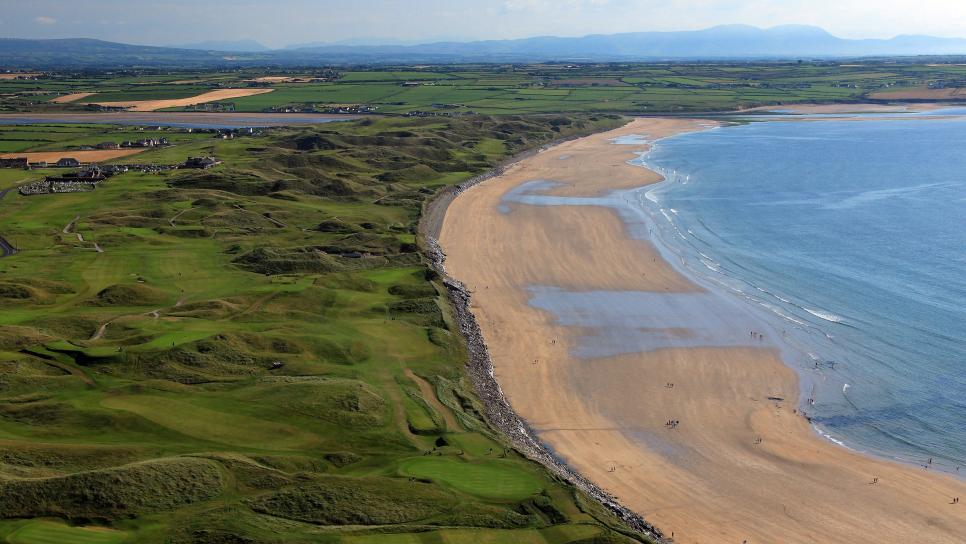
Photo by David Cannon/Getty Images
28 . CAPE KIDNAPPERS G. CSE. | Hawke's Bay, New Zealand | 7,143 yards, par 71
Not a links, more like a stratospheric Pebble Beach, high atop a windswept plateau some 500 feet above the sea. The 2004 design truly demonstrates the lay-of-the-land philosophy of American architect Tom Doak, who ran holes out and back along a series of ridges perpendicular with the coastline, most framed by deep canyons. The fairways are wide, but Doak rewards bold tee shots that flirt with ravines and sets strategies using some of the deepest bunkers he has ever built. Cape Kidnappers was also the International winner of a 2012 Environmental Leaders in Golf Award, co-sponsored by Golf Digest.
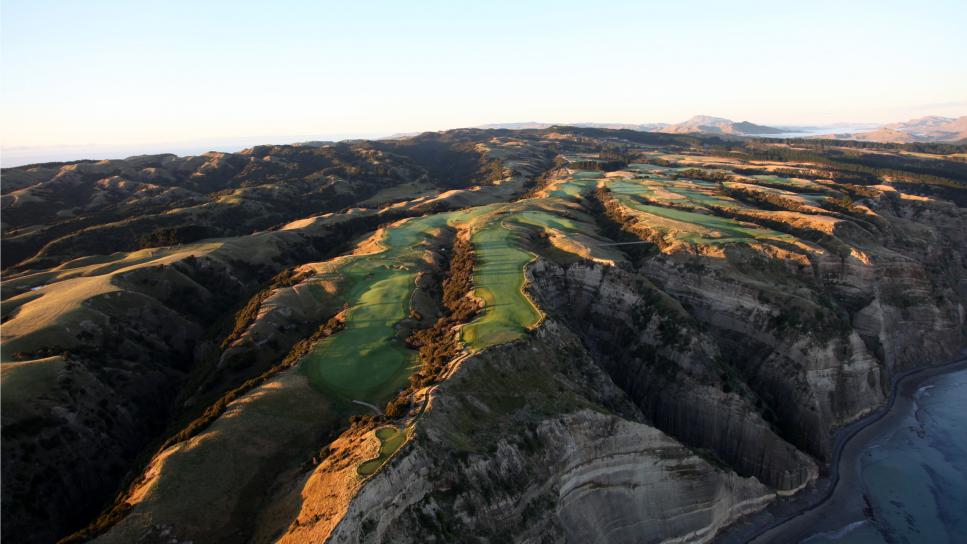
29 . CRYSTAL DOWNS C.C. | Frankfort, Mich. | Alister MacKenzie & Perry Maxwell (1931) | 6,518 Yards, par 70
Perry Maxwell, the Midwest associate of architect Alister MacKenzie, lived on site while constructing the course to MacKenzie's plans, but there's evidence Maxwell exercised considerable artistic license on some holes. Whomever did it, Crystal Downs has fairways that zigzag and rumble over the landscape and greens that have doglegs in them. One drawback is that the putting surfaces are so old-fashioned that they're too steep for today's green speeds. The club keeps a running tally on how many putts end up off the putting surface.
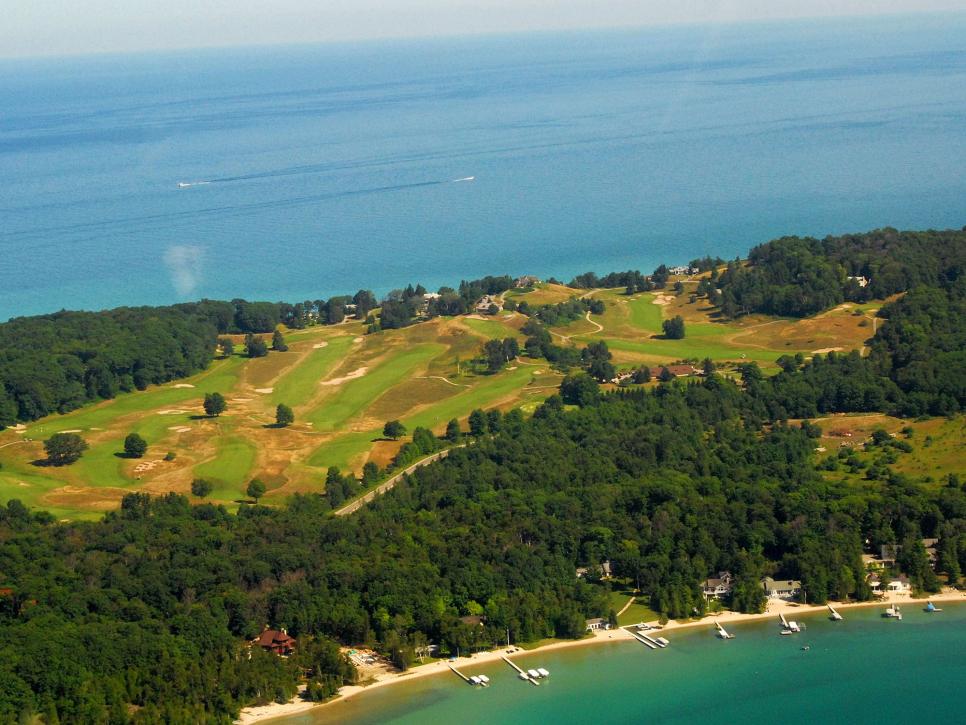
30 . SEMINOLE G.C. | Juno Beach, Fla. | Donald Ross (1929) | 6,836 Yards, par 72
A majestic Donald Ross design with a clever routing on a rectangular site, each hole at Seminole encounters a new wind direction. The greens are no longer Ross, replaced 50 years ago in a regrassing effort that showed little appreciation for the original rolling contours. The bunkers aren't Ross either. Dick Wilson replaced them in 1947, his own version meant to the imitate crests of waves on the adjacent Atlantic. In the past year, Bill Coore & Ben Crenshaw redesigned the bunkers again, along with exposing some sandy expanses in the rough. Seminole has long been one of America's most exclusive clubs, which is why it's exciting that it will host the 2021 Walker Cup.

31 . CHICAGO G.C. | Wheaton, Ill. | C.B. Macdonald (1894) / Seth Raynor (1923) | 6,846 Yards, par 70
There is an ongoing debate as to whether or not this is America's first 18-hole golf course. Some claim the first was another C.B. Macdonald creation, also bearing the name Chicago Golf Club, which opened near Downers Grove, Ill. in 1893. But historical records are unclear whether that club had 18 holes or just nine. We do know when Chicago Golf Club moved to Wheaton in 1896, Macdonald laid out what he called, "a really first-class 18-hole course of 6,200 yards." It was remodeled into its present configuration, emulating famous holes, in 1923 by Macdonald's longtime assistant Seth Raynor. One thing Raynor retained was Macdonald's routing, with all the out-of-bounds on the left. C.B., you see, was a slicer.
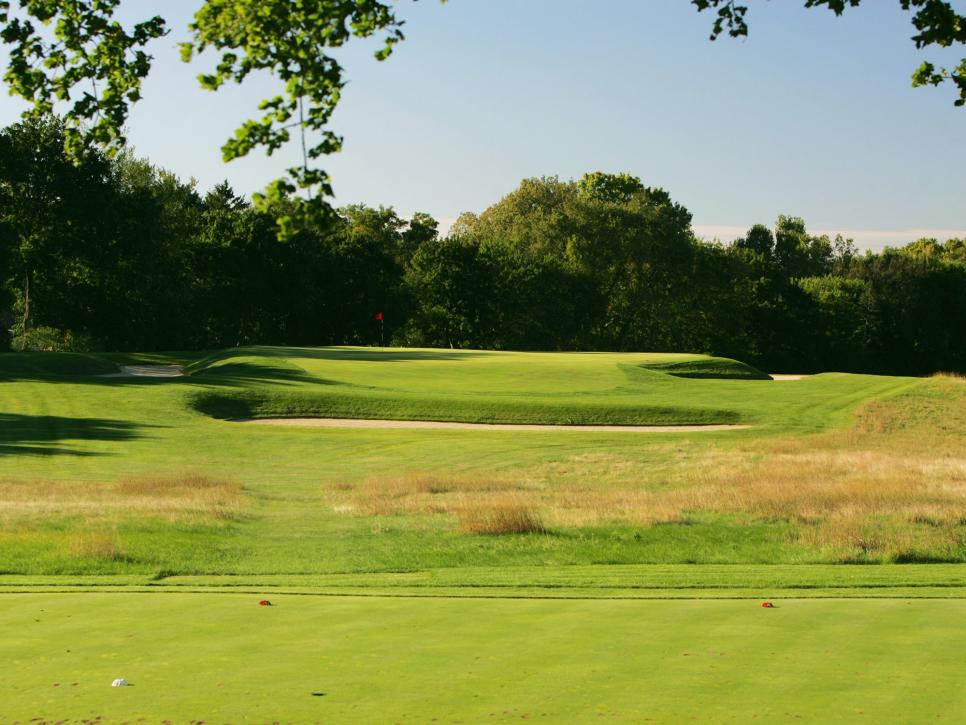
32 . NEW SOUTH WALES G.C. | Le Perouse, Australia | 6,829 yards, par 72
On the dramatic rugged seacoast of Botany Bay near Sydney, on the spot where Captain Cook first stepped onto Australia in 1770, La Perouse is renown for its ocean views and high winds. On his brief but productive 1926 trip, Alister MacKenzie prepared a routing for the course, but it was radically altered during a 1936 remodeling by Eric Apperly and by neglect during WWII. A succession of post-war architects has slowly re-established the integrity of the design, most recently Greg Norman.

Photo by David Cannon/Getty Images
33 . ROYAL MELBOURNE G.C. (EAST) | Black Rock, Australia | 6,579 yards, par 71
Former Australian Open champion Alex Russell and greenkeeper Mick Morcom built the West Course to plans of Alister MacKenzie, then added the East in 1931, on somewhat less inspiring land, flatter and more wooded. But the bunkering and green contours are very similar to the West. (Mackenzie had routed a nine-hole East Course that was never built. Russell incorporated a few of those holes.) A slight flaw may be that all four par 3s play in the same northerly direction. For composite tournament play, East's holes 1-3 and 16-18 are used along with 12 of the West holes.

David Cannon/Getty Images
34 . MUIRFIELD VILLAGE G.C. | Dublin, Ohio | Jack Nicklaus & Desmond Muirhead (1974) | 7,392 Yards, par 72
This is the course that Jack built, and rebuilt, and rebuilt again and again. Since its opening in 1974, Jack Nicklaus has remodeled every hole at Muirfield Village, some more than once, using play at the PGA Tour's annual Memorial Tournament for some guidance. In the past six years, he totally changed the par-3 16th and par-4 17th holes. Just before Presidents Cup in October 2013, he added a new back tee to the par-4 18th, extending it from 444 yards to 484. That's how a championship course remains competitive.
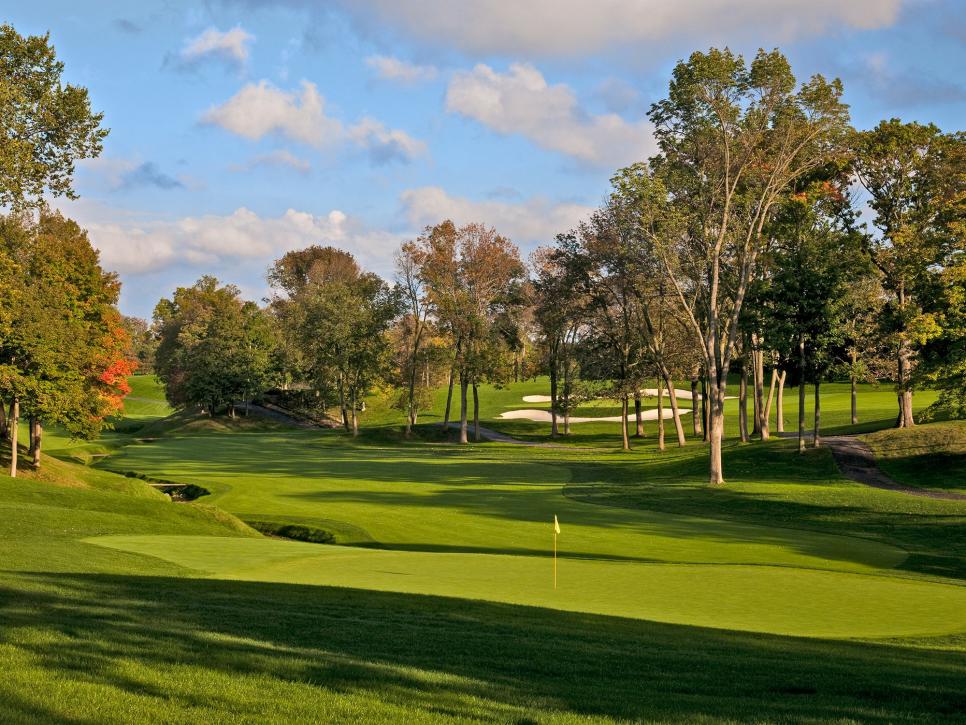
35 . ST. GEORGE'S G. AND C.C. | Etobicoke, Ontario, Canada | 7,014 yards, par 71
An outstanding Stanley Thompson design, it's routed through forest-covered glacial land, with meandering fairways that diagonally traverse valleys to greens perched on domes. The putting surfaces are tightly bunkered and full of hidden undulations. These are considered some of Thompson's best bunkering, thanks in part to American architect Tom Doak and Canadian architect Ian Andrew, who recently collaborated to restore the bunkering, highlighting their sweeping lines and graceful movements.
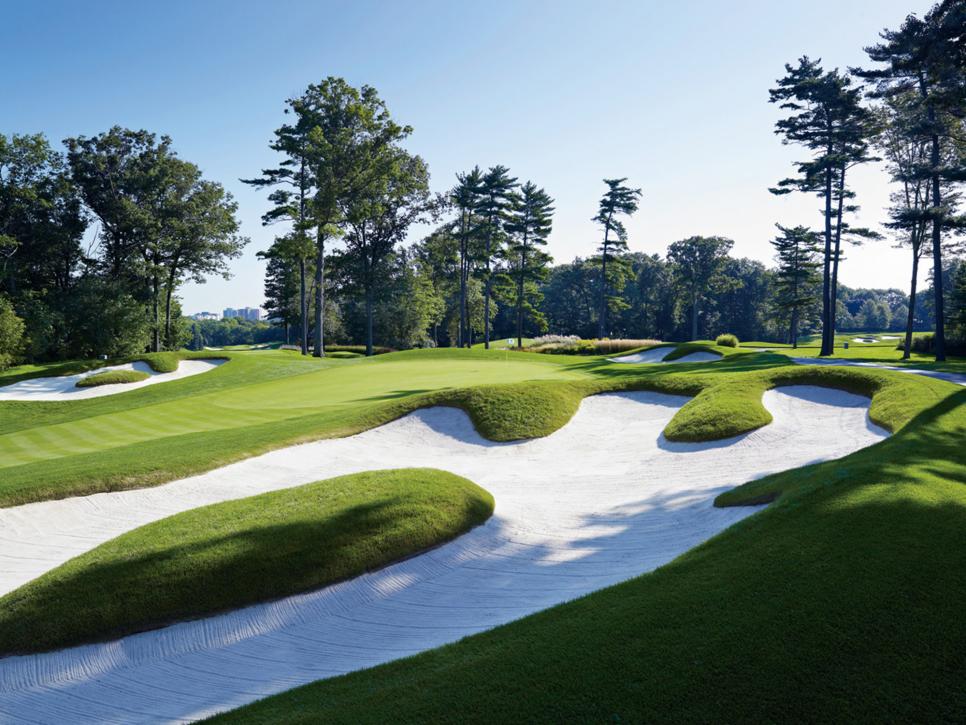
36 . THE COUNTRY CLUB (Clyde/Squirrel) | Chestnut Hill, Mass. | Willie Campbell (1895) / Alex Campbell (1902) | 7,350 Yards, par 70
The Country Club's 18 holes that were the scene of the 1963 and 1988 U.S. Opens is not the 18 holes ranked by Golf Digest. Those events were played on a composite course, utilizing a few holes from the club's third Primrose nine. We rank the Clyde & Squirrel combination, clearly good enough to be one of the top courses in the world. Gil Hanse performed some course restoration prior to the 2013 U.S. Amateur at The Country Club.
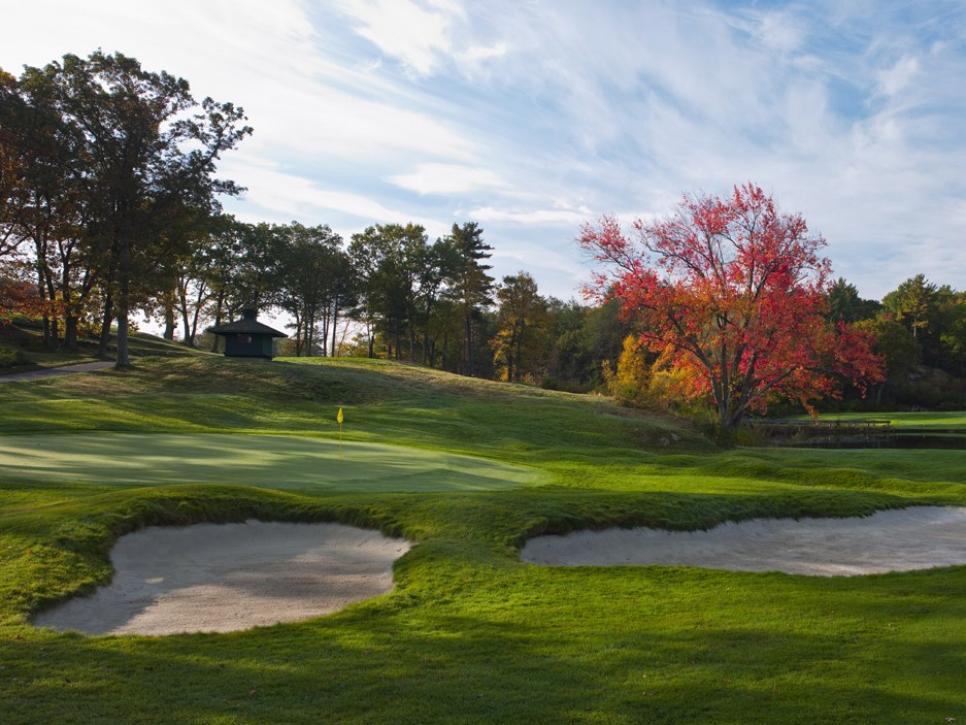
37 . OAKLAND HILLS C.C. (South) | Bloomfield Hills, Mich. | Donald Ross (1918) | 7,445 Yards, par 70
Donald Ross felt his 1918 design was out-of-date for the 1951 U.S. Open and was prepared to remodel it. Sadly, he died in 1948, so Robert Trent Jones got the job. His rebunkering was overshadowed by ankle-deep rough, and after Ben Hogan closed with a 67, one of only two rounds under par 70 all week, to win his second consecutive Open, he complained that Jones had created a Frankenstein. Sixty plus years later, Oakland Hills is even longer, but its bite wasn't severe when it hosted the 2016 U.S. Amateur.
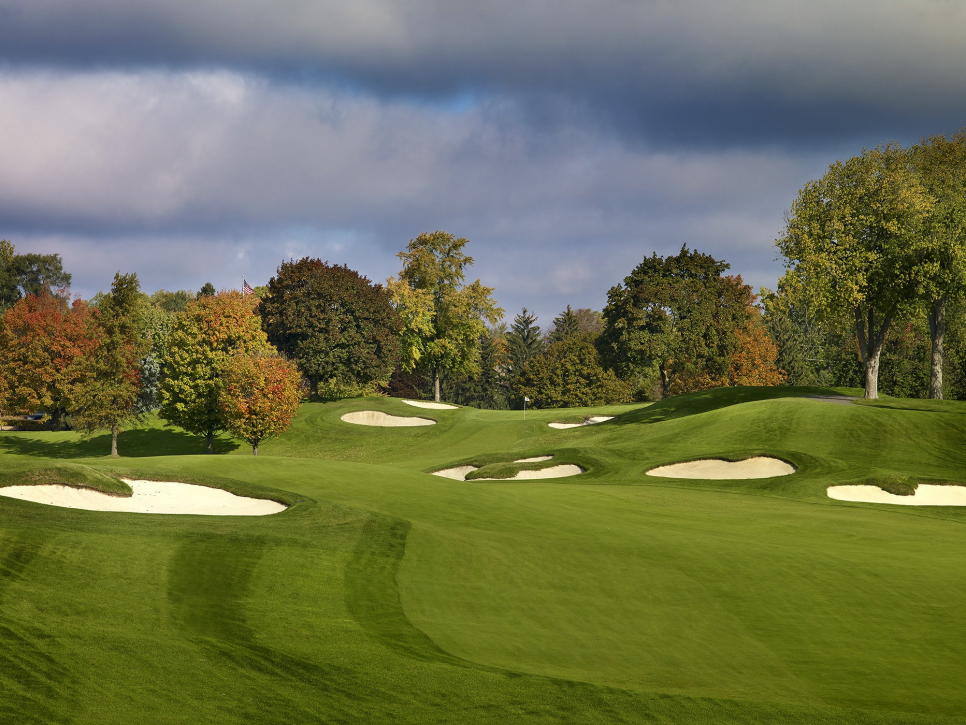
38 . CARNOUSTIE G. LINKS (CHAMPIONSHIP) | Scotland | 7,421 yards, par 71
Perhaps the homeliest, certainly the longest and toughest of Open venues, Carnoustie is a no-holds-barred layout intended to test the best. James Braid is usually credited with the present design, but it was green chairman James Wright who in 1931 created the stirring last three holes, with 17 and 18 harassed by twisting, turning Barry Burn. In the 1968 Open, Jack Nicklaus complained that a knob in the middle of the ninth fairway kicked his drives into the rough. When he returned for the 1975 Open, he found it had been converted to a pot bunker.

Stephen Szurlej
39 . ROYAL ST. GEORGE'S G.C. | Sandwich, England | 7,204 yards, par 70
Royal St. George's, in dunes along the English Channel, is what writer Adam Lawrence calls the ideal mix of championship golf and gentle quirks. Its quirks include a duo of massive bunkers that howl at tee shots on the par-5 fourth. Once as tall as a six story building, they've eroded over the years, and have been stabilized the past 20 years by the addition of 93 railroad ties along their top edges. A longtime member of the Open rota, Royal St. George's was the site of Darren Clarke's surprise victory in 2011.

Photo by Stephen Szurlej
40 . PACIFIC DUNES | Bandon, Ore. | Tom Doak (2001) | 6,633 yards, par 71
This was the second course built at Bandon Dunes Resort and the highest ranked among the resort's four 18s (soon to become five 18s). To best utilize ocean frontage, Tom Doak came up with an unorthodox routing that includes four par 3s on the back nine. Holes seem to emerge from the landscape rather than being superimposed onto it, with rolling greens and rumpled fairways framed by rugged sand dunes and marvelously grotesque bunkers. The secret is Doak moved a lot of earth to make it look like he moved very little.
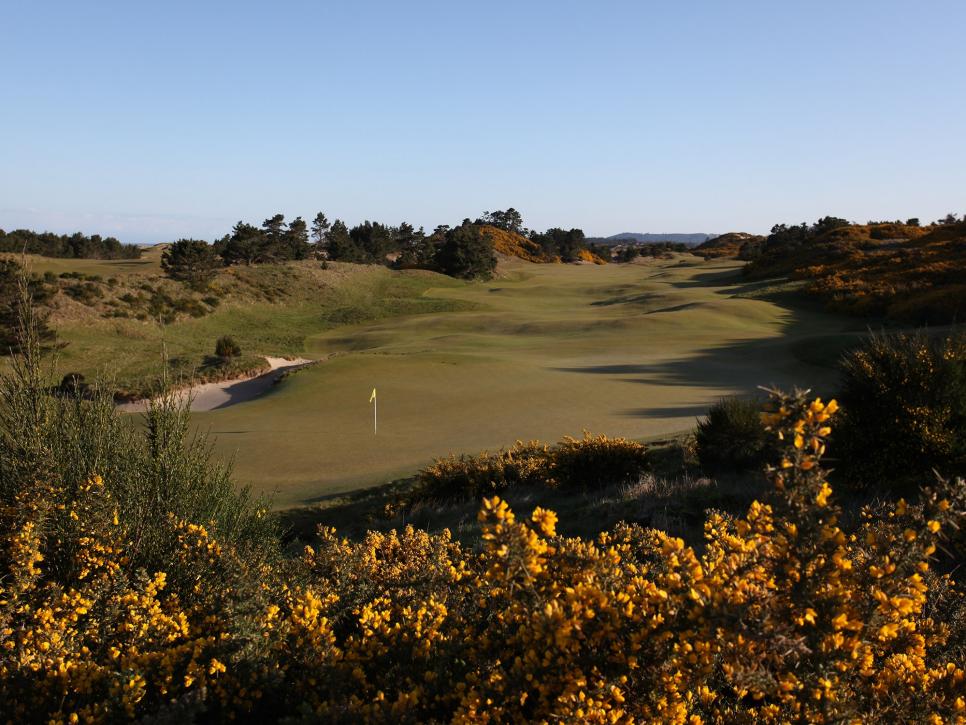
41 . FRIAR'S HEAD G.C. | Baiting Hollow, N.Y. | Bill Coore & Ben Crenshaw (2002) | 7,049 Yards, par 71
The challenge for architects Bill Coore and Ben Crenshaw at Friar's Head was to design some holes in breathtaking sand dunes perched 200 feet above Long Island Sound, and other holes on an ordinary potato field to the south. Said Crenshaw, "Our job was to marry the two distinct elements. We didn't want one nine up in the dunes and the other down on the flat." The solution was to move the routing back and forth and to artfully reshape the farm fields into gentle links-like land. They pulled it off so impressively that Friar's Head has moved steadily up the rankings, from No. 34 in its 2011 debut to No. 19 on our current America's 100 Greatest.
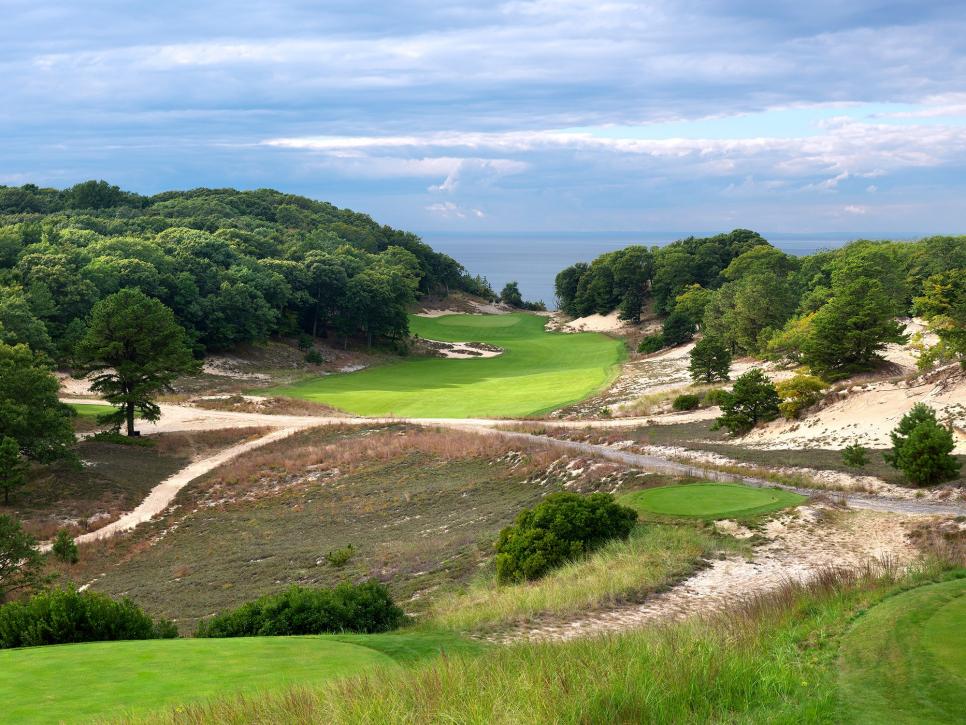
42 . OAK HILL C.C. (East) | Rochester, N.Y. | Donald Ross (1925) | 7,152 Yards, Par 70
Back in 1979, George Fazio and nephew Tom were roundly criticized by Donald Ross fans for removing a classic Ross par 4 on Oak Hill East and replacing it with two new holes, including the bowl-shaped par-3 sixth, which would later become the scene of four aces in two hours during the second round of the 1989 U.S. Open. They also built a pond on another par 3 and relocated the green on the par-4 18th. There is talk that the club may remodel those holes, to bring them more in line with Donald Ross' original style. One or more Ross holes may even be re-established. If it happens, it will likely occur before Oak Hill hosts the 2023 PGA Championship.
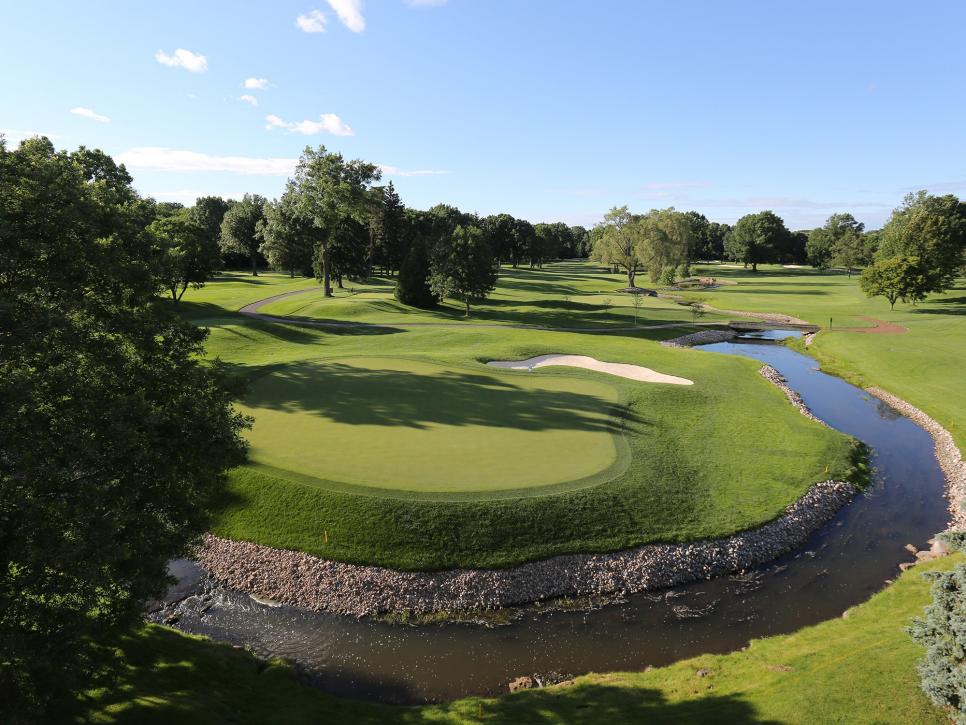
43 . THE OCEAN COURSE | Kiawah Island, S.C. | Pete Dye (1991) | 7,356 yards, par 72
The first course designed for a specific event -- the 1991 Ryder Cup -- this manufactured linksland-meets-lagoons layout might well be Pete Dye's most diabolical creation. Every hole is edged by sawgrass, every green has tricky slopes, every bunker merges into bordering sand dunes. Strung along nearly three miles of ocean coast, Dye took his wife's advice and perched fairways and greens so golfers can actually view the Atlantic surf. That also exposes shots and putts to ever-present and sometimes fierce coastal winds.
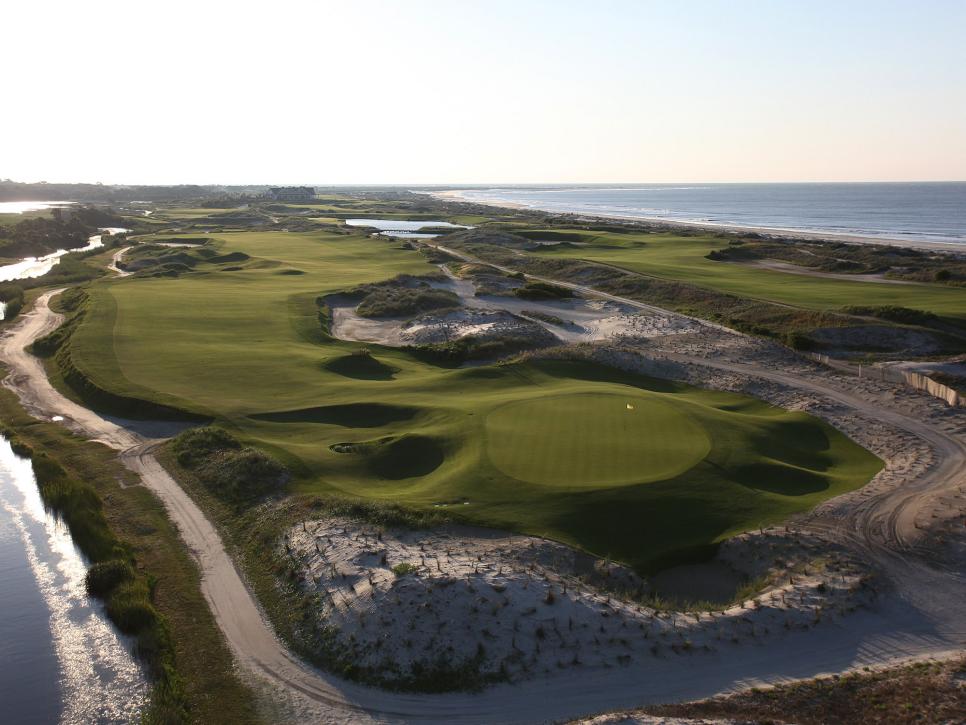
44 . WHISTLING STRAITS (Straits) | Haven, Wis. | Pete Dye (1998) | 7,790 Yards, par 72
Pete Dye transformed a dead flat abandoned army air base along a two-mile stretch of Lake Michigan into an imitation Ballybunion at Whistling Straits, peppering his rugged fairways and windswept greens with 1,012 (at last count) bunkers. There are no rakes at Whistling Straits, in keeping with the notion that this is a transplanted Irish links. It has too much rub-of-the-green for the comfort levels of many tour pros, two dozen of whom will tackle the Straits again in the 2020 Ryder Cup.
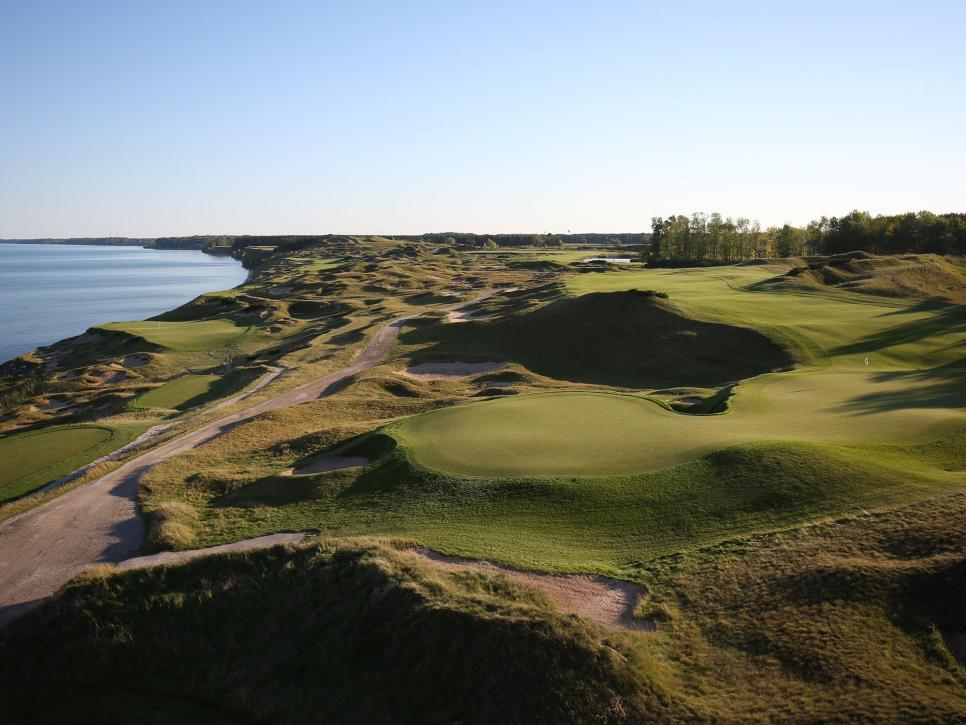
45 . THE CLUB AT NINE BRIDGES | Jeju Island, South Korea | 7,196 yards, par 72
Our Korean affiliates call The Club at Nine Bridges the Taj Mahal of Golf. After all, architects Ronald Fream and David Dale spent an estimated $40 million in the early 2000s creating it. (The entire project, including land, clubhouse, condos and spa, cost $100 million.) The site was volcanic rock, capped with 150,000 cubic yards of sand as a base for bent-grass fairways and greens. The site had natural streams edged with massive Japanese Maples and 20-foot-tall Korean Azaleas, but they also transplanted 300 mature evergreens like Kryptomeria and cedars for additional color. With lakes connected by cascading weirs and a par-5 18th finishing on an island green, the course hosted the 2017 CJ Cup @ Nine Bridges, the first official American PGA Tour event held in Korea.

46 . CAPE WICKHAM LINKS | King Island, Australia | 6,725 yards, par 72
American Mike DeVries and Australian golf writer Darius Oliver collaborated on a breathtaking site along Bass Strait, a notorious stretch of Australian seacoast that once shipwrecked many voyages. The routing on this glorious collection of holes is heart-pounding, starting along rocks and crashing surf, moving inland but not out of the wind, returning to ocean edge at the downhill 10th, pitch-shot 11th and drivable par-4 12th. It then wanders into dunes before a crescendo closing hole curving along Victoria Cove beach, which is in play at low tides.

©2015 LC Lambrecht
47 . LOS ANGELES C.C. (North) | Los Angeles | George C. Thomas Jr. (1921) | 7,236 Yards, par 71
It's on the edge of Tinsel Town, but the architecture of the North Course at Los Angeles Country Club has been solid gold ever since its 2010 restoration by architect Gil Hanse, his associate Jim Wagner and their colleague Geoff Shackelford. It matters not that Hanse's team didn't replicate the bunkering style of original architect George C. Thomas, but rather the more visually exciting style of Thomas's associate, William P. Bell. The hole strategies will play sensationally when LA North hosts the 2017 Walker Cup and the 2023 U.S. Open.
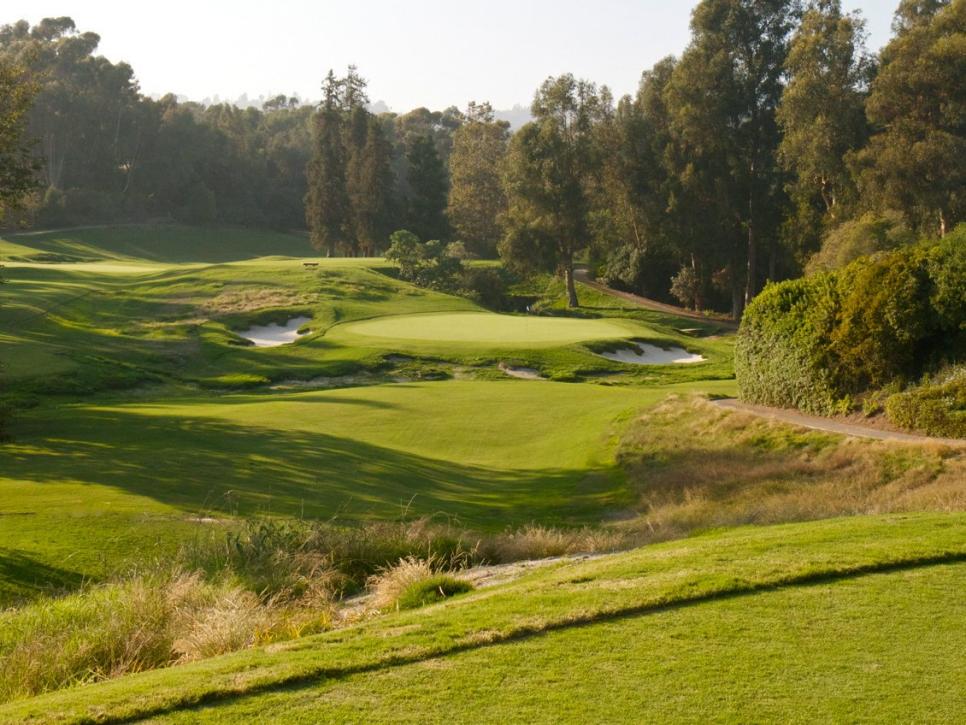
48 . RIVIERA C.C. | Pacific Palisades, Calif. | George C. Thomas Jr. & W.P. Bell (1926) | 7,040 Yards, par 71
A compact but clever design by George C. Thomas Jr. and associate William P. Bell, Riviera features everything from a long Redan par 3 to a bunker in the middle of a green to an alternate-fairway par 4. With its 18th green at the base of a natural amphitheater, Riviera seems tailor-made as a tournament venue. It's hosted an annual PGA Tour event, but no U.S. Open since 1948. It will be the site of the 2017 U.S. Amateur. Will that be a harbinger of a bigger USGA event to come? With the Open rewarded elsewhere through 2026, it doesn't appear so.

49 . NORTH BERWICK G.C. | East Lothian, Scotland | 6,458 yards, par 71
North Berwick must be played with good humor. To do otherwise is to not properly appreciate its outrageous topography (some terrain is like an elephant cemetery) and outlandish holes, like the sunken 13th green beyond a stone wall, the renown Redan par-3 15th, blind from the tee, and the long, narrow 16th green with a gulch separating front and back plateaus, surely the model for the infamous Biarritz green, although purists say otherwise.
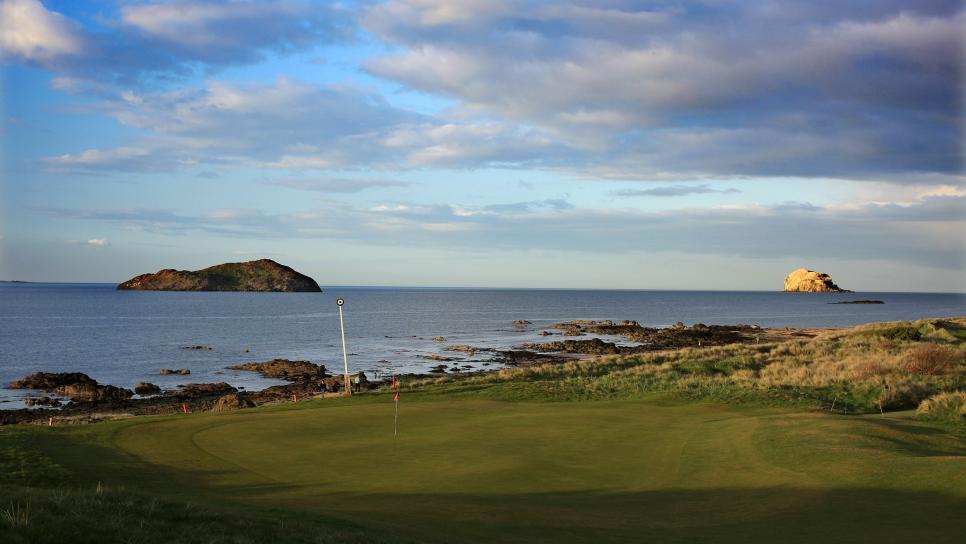
David Cannon/Getty Images
50 . WADE HAMPTON G.C. Cashiers, N.C. | Tom Fazio (1987) | 7,302 Yards, par 72
Built during the period when Tom Fazio was still working with the existing landscape rather than ignoring it, Wade Hampton is an exercise in restraint. The fairways flow through a natural valley between flanking mountain peaks. Some holes are guarded by gurgling brooks, but Fazio piped several streams underground to make the course more playable and walkable. Selected as Golf Digest's Best New Private Course of 1987, it has never been out of the Top 40 since it joined America's 100 Greatest.
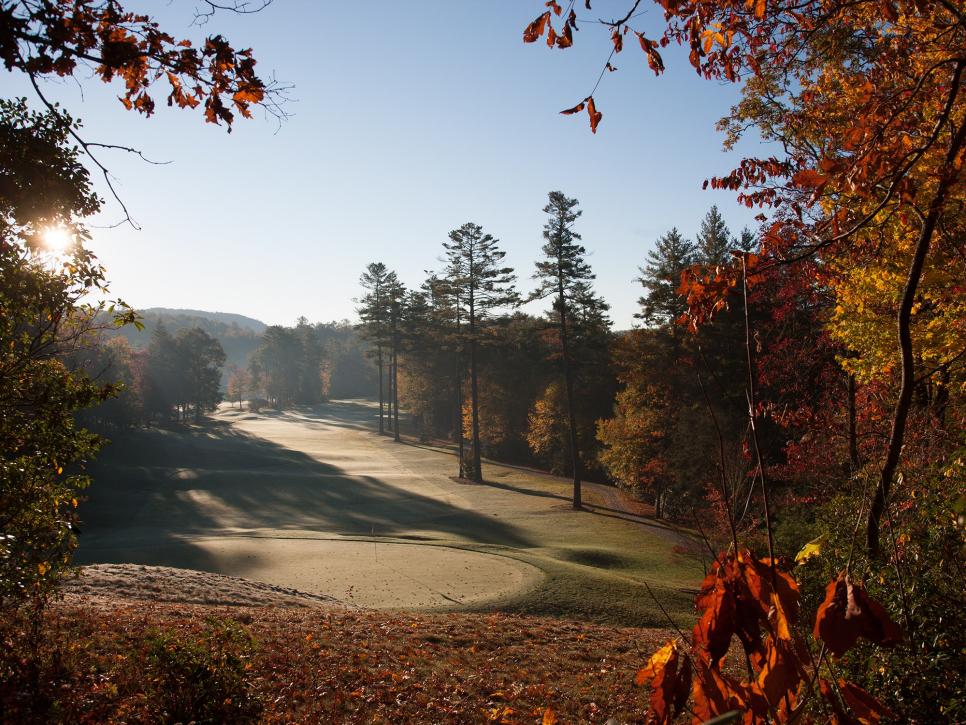
51 . BARNBOUGLE LOST FARM | Bridport, Australia | 6,849 yards, par 72
On a site just across the river from sister Barnbougle Dunes, with taller dunes but fewer of them, Lost Farm has not 18, but 20 holes, counting its two short pitch-shot bye holes. The design is dramatic and unusual, particularly the par-4 fifth, a dogleg right along the river, whose blind tee shot brings to mind the 17th at St. Andrews. Instead of old black sheds, a high dune blocks view of the fairway from the tee. Billed as a Coore and Crenshaw design, schedule conflicts kept Ben Crenshaw from participating. Bill Coore used the usual C&C construction team, though.
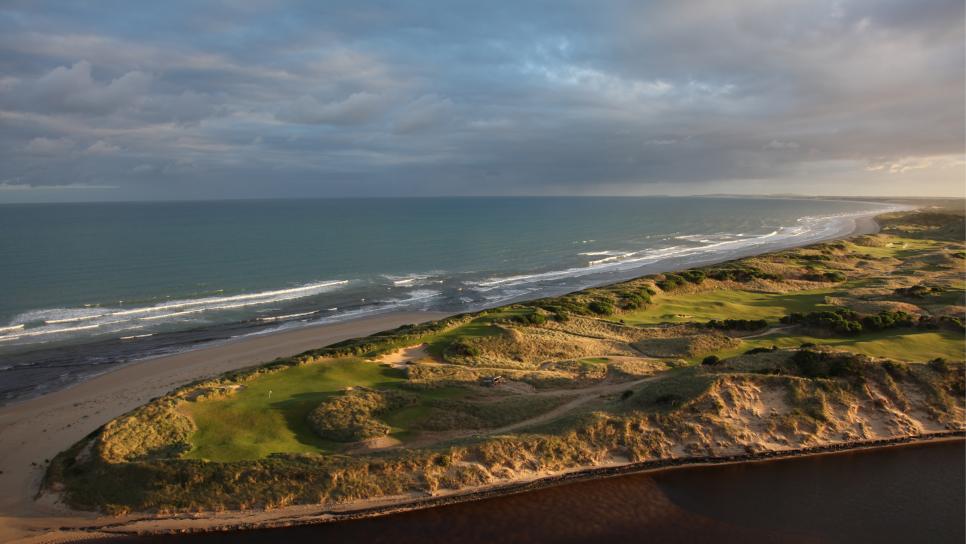
Photo by Stephen Szurlej
52 . CASA DE CAMPO (TEETH OF THE DOG) | La Romana, Dominican Republic | 7,471 yards, par 72
The Dominican Republic is now a major golf destination. Teeth of the Dog started it all back in 1971. Pete Dye has been periodically rebuilding and updating his earliest international masterpiece following repeated hurricane damage. The routing is stunning, a clockwise front nine, counterclockwise back nine, with seven holes hunkered down on the ocean, no more than 20 feet above the surf. The sea is on the left on holes five through eight, on the right on holes 15 through 17. Every hole is unique and scenic.
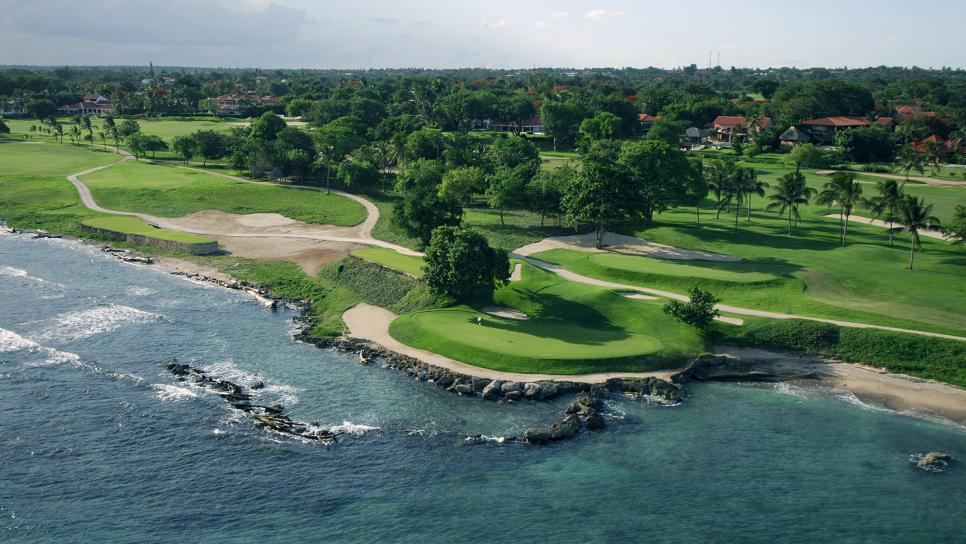
Tony Arruza/Courtesy of Casa de Campo/The Leading Hotels of the World
53 . JACK NICKLAUS G.C. KOREA | Incheon City, South Korea | 7,470 yards, par 72
Lying in the shadow of skyscrapers in the Songdo International Business District, this is an impressive Nicklaus design, one that transformed a flat, dull site into a surprisingly rolling, pine-dotted layout with water on 11 holes, equitably distributed with six hazards to the left and five to the right. Despite the site being inland, artificial rocks edging most of the lakes leave the impression of a jagged coastline. Jack Nicklaus Golf Club Korea hosted the 2015 Presidents Cup, won by the U.S. team captained by Jay Haas over the International side headed by Nick Price. It was the first Presidents Cup contested in Asia.
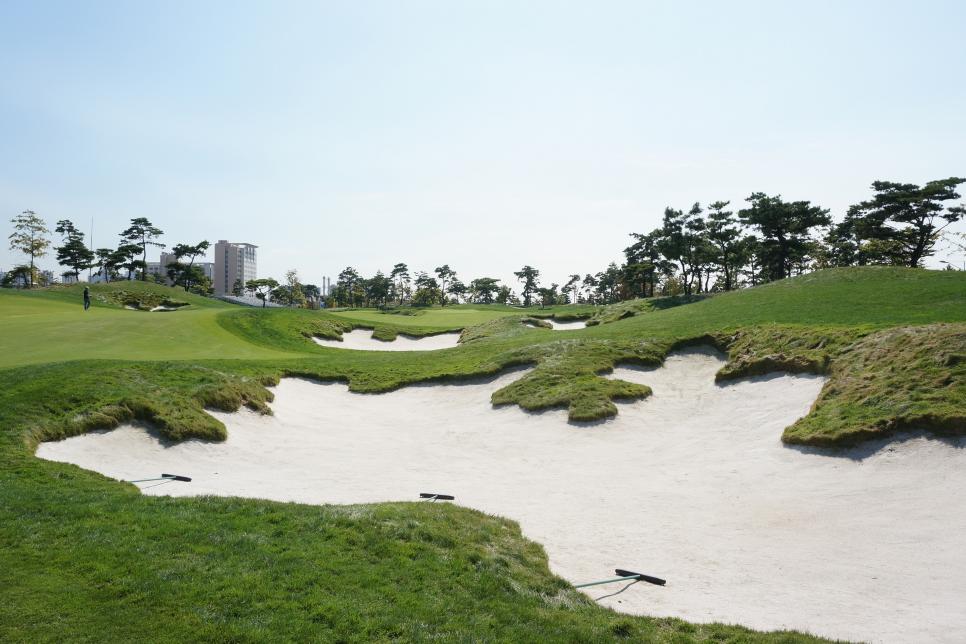
54 . SHADOW CREEK | North Las Vegas, Nev. | Tom Fazio (1990) | 7,560 Yards, par 72
Forty-seven million dollars to build a golf course? Tom Fazio said that budget was necessary at Shadow Creek to perform what he now calls "total site manipulation," creating an environment where none existed, by carving rolling hills and canyons from the flat desert floor north of Las Vegas and pumping in plenty of water. Original owner Steve Wynn spent that much money because that's what casino hotel owners do, create fantasies like Vermont in Vegas. Alas, this once-in-a-lifetime dream design has been too successful, triggering many equally expensive, but inferior, imitations.

55 . THE ALOTIAN CLUB | Roland, Ark. | Tom Fazio (2004) | 7,480 Yards, par 72
The Alotian Club gives us a hint of what Augusta National would have looked like had Bobby Jones established his dream course on even hillier terrain than Augusta. The first tee shot drops 70 feet to a fairway below, with the approach playing back uphill. The tee on the 205-yard par-3 sixth sits 85 feet above the green. Alotian, founded by Warren Stephens, son of former Masters chairman Jackson Stephens, is the first (and still only) course in Arkansas ever to make America's 100 Greatest. The Alotian name comes from the annual golf trips Stephens once took with his buddies. He called it America's Lights Out Tour, and they were the Alotians.

56 . GOZZER RANCH G. & LAKE C. | Harrison, Idaho | Tom Fazio (2007) | 7,317 Yards, par 72
When it won in 2008, Gozzer Ranch was the 13th Best New Course triumph for architect Tom Fazio. Gozzer won in part because of its gorgeous views of Lake Coeur d'Alene to the north and west and the panoramic farm valley to the east. Little details elevate the architecture of Gozzer Ranch: a slight false right front edge on the first green, the backboard slope behind the sixth green, the fairway contouring on the dual-fairway drivable par-4 12th that kicks even a short drive to the base of the putting surface. Its shaggy-edged bunkers are more than mere set decorations. Some define targets off the tee; other pose options and challenges.

57 . HAESLEY NINE BRIDGES | Yeoju County, South Korea | 7,256 yards, par 72
Don't confuse this course with No. 45 Club at Nine Bridges, designed by Ronald Fream and then-partner David Dale. Both have the same owner, but this one Dale alone designed. Nine Bridges is on Jeju Island; Haesley is close to Seoul. Nine Bridges has revetted bunkers; Haesley has big, bold flashed-sand ones. Nine Bridges has an island green on 18; Haesley has a par 4 with an island fairway and an island green, and a mountainside waterfall on another hole that would make Donald Trump jealous. Haesley Nine Bridges opened in 2009 and has held the CJ Invitational on the Korean Golf Tour in 2011 through 2013, won twice by tournament host K.J. Choi. In 2017, the CJ became a U.S. PGA Tour event and was played at—you guessed it—the other Nine Bridges.

58 . PRAIRIE DUNES C.C | Hutchinson, Kan. | Perry Maxwell (1937) / Press Maxwell (1957) | 6,940 Yards, par 70
Prairie Dunes was the top nine-hole course in America for 20 years. By the time the club found funds to expand it to 18, original architect Perry Maxwell had passed away, but his son Press was able to add nine more holes seamlessly, putting three on the front nine and six on the back. He also replicated his father's great greens. Prairie Dunes reflects all that is Kansas: sand dunes, prairie grasses, yucca plants, cottonwoods and constant wind.

59 . KINGSBARNS G. LINKS | St. Andrews, Scotland | 7,224 yards, par 72
Just down the coastline from the links at St. Andrews, Kingsbarns looks absolutely natural in its links setting. It's a tribute to owner Mark Parsinen and architect Kyle Phillips (both Californians), who collaborated on transforming a lifeless farm field into a course that fools even the most discerning eye. The routing is ingenious, crescent-shaped along the Fife coast, with holes on three separate levels (130 feet of elevation change in all) to provide ocean views from every fairway. Six holes play right on the shoreline, and every hole offer genuine alternate angles of attack.
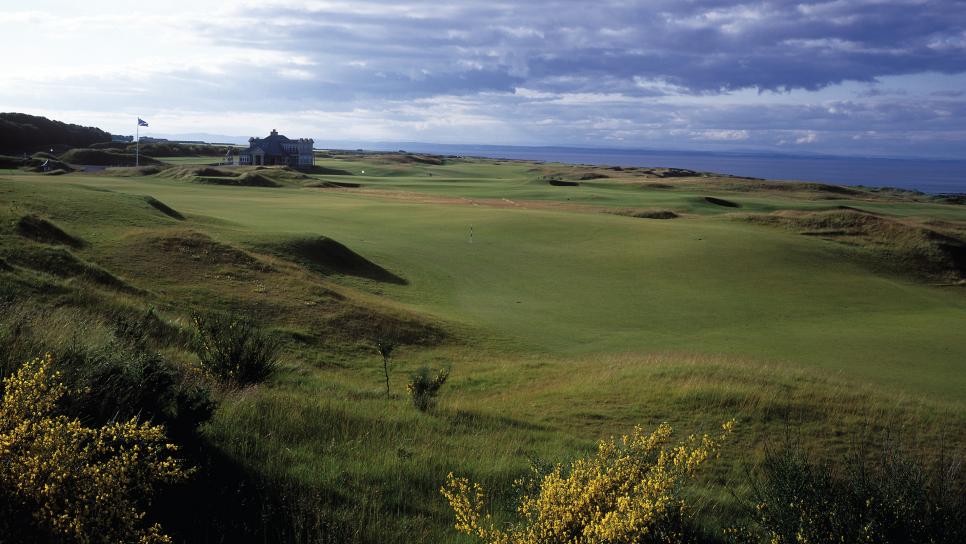
60 . PINEHURST RESORT (No. 2) | Pinehurst, N.C. | Donald Ross (1935) | 7,588 Yards, par 72
In 2010, a team lead by Bill Coore and Ben Crenshaw killed and ripped out all the Bermudagrass rough on Pinehurst No. 2 that had been foolishly planted in the 1970s. Between fairways and tree lines, they established vast bands of native hardpan sand dotted with clumps of wiregrass and scattered pine needles. They reduced the irrigation to mere single rows in fairways to prevent grass from ever returning to the new sandy wastelands. Playing firm and fast, it was wildly successful as the site of the 2014 men's and women's U.S. Opens, played on consecutive weeks. Because of its water reduction, the course was awarded a Green Star environmental award by Golf Digest that year.
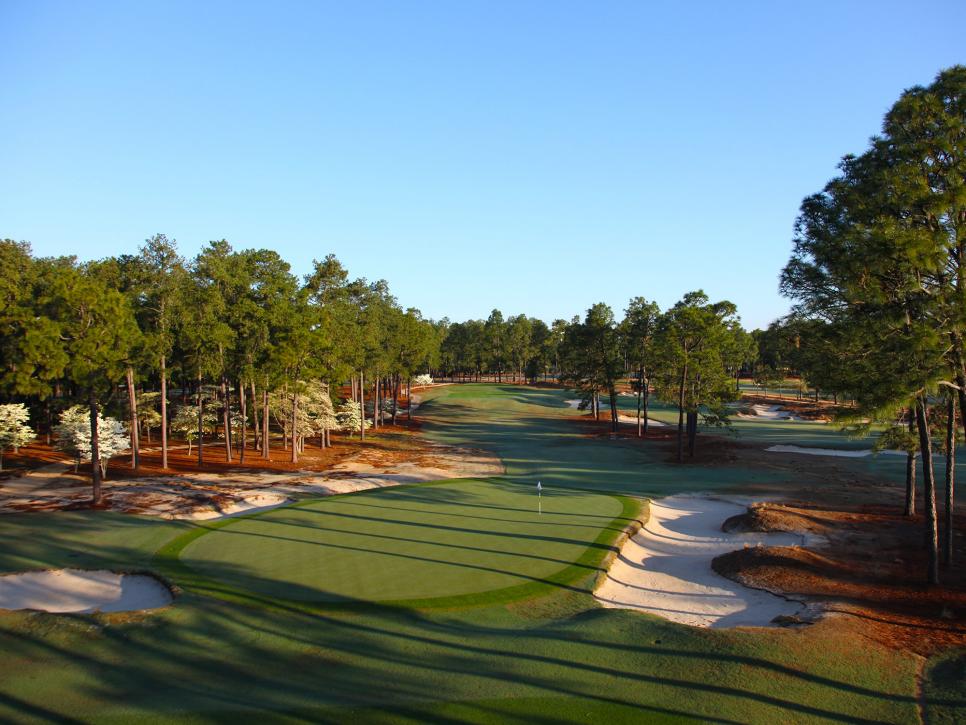
61 . THE OLYMPIC CLUB (Lake) | San Francisco | Sam Whiting (1924) | 6,934 Yards, par 71
It seems fitting that, in a town where every house is a cliffhanger, every U.S. Open played at Olympic has been one, too. For decades, the Lake was a severe test of golf. Once it was a heavily-forested course with canted fairways hampered by just a single fairway bunker. Today the forest has been considerably cleared away, leaving only the occasional bowlegged cypress with knobby knees. The layout also has a new par-3 eighth as well as several new bunkers. Still, the 2012 U.S. Open stuck to the script: a ball was stuck in tree, slow-play warnings were given, a leader snap-hooked on 16 in the final round, and a guy name Simpson won. Next up for Olympic Lake, the 2021 U.S. Women's Open.
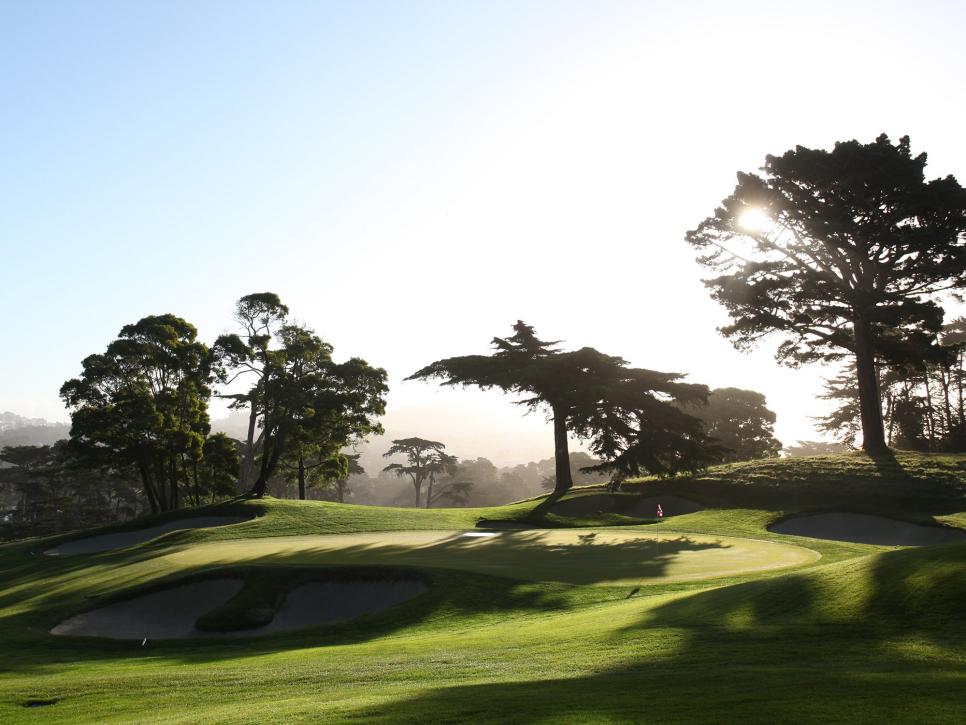
62 . ELLERSTON G.C. | Hunter Valley, Australia | 7,312 yards, par 72
No other course on the World Top 100 is so brutally honest about its intention to be a ball buster. The late media mogul Kerry Packer commissioned Greg Norman to build him the nation's toughest course, and Norman complied. Routed on slopes and in a valley on Packer's estate, it has water in play on half the holes. A superb aerial game is needed to clear deep bunkers and reach greens perched perilously close to the Pages Creek. After its opening, Norman said, "We had no need to consider forward tees, resort traffic or weaker hitters. We were able to create a course that a golfer of my caliber would love to play everyday."

63 . ST. GEORGE'S HILL G.C. | Weybridge, England | 6,526 yards, par 70
In his classic 1925 book, The Links, Robert Hunter raved about H.S. Colt's "bold hazards, well designed" at St. George's Hill. And while, 93 years later, some are now tamer, with less ragged, jagged edges, their placements are still ideal. Towering fir trees and patches of heather add additional challenge and charm to what many consider to be Colt's finest heathland design, more stirring even than Swinley Forest (77th on this ranking). St. George's Hill's main 18, now the Blue & Red 9s, opened in 1913 as one of the first residential golf projects in the world.
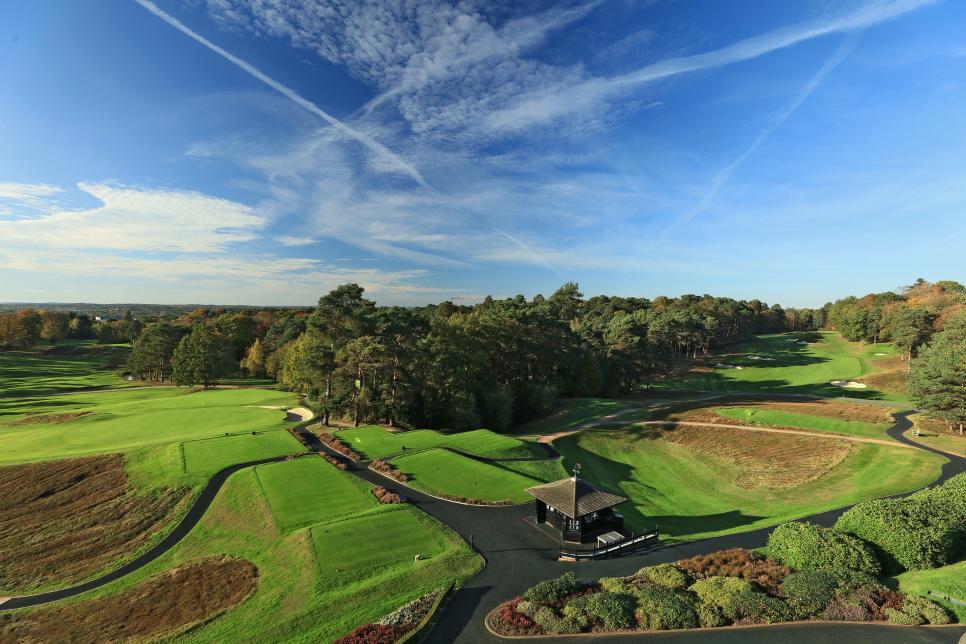
Photo by David Cannon/Getty Images
64 . THE HONORS COURSE | Ooltewah, Tenn. | Pete Dye (1983) | 7,450 Yards, par 72
Considered radical in the early 1980s because of its acres of tall, native-grass rough, durable Zoysiagrass fairways and terrifying greens perched atop bulkheads of rock, today The Honors Course is considered a well-preserved example of Pete Dye's death-or-glory architecture. Other than reducing the contours in a couple of greens (particularly the 18th) in the late 1990s, and adjusting the bunkering in 2008, Dye has left the course alone. Georgia architect Bill Bergin did create a new practice facility at the club in 2015.
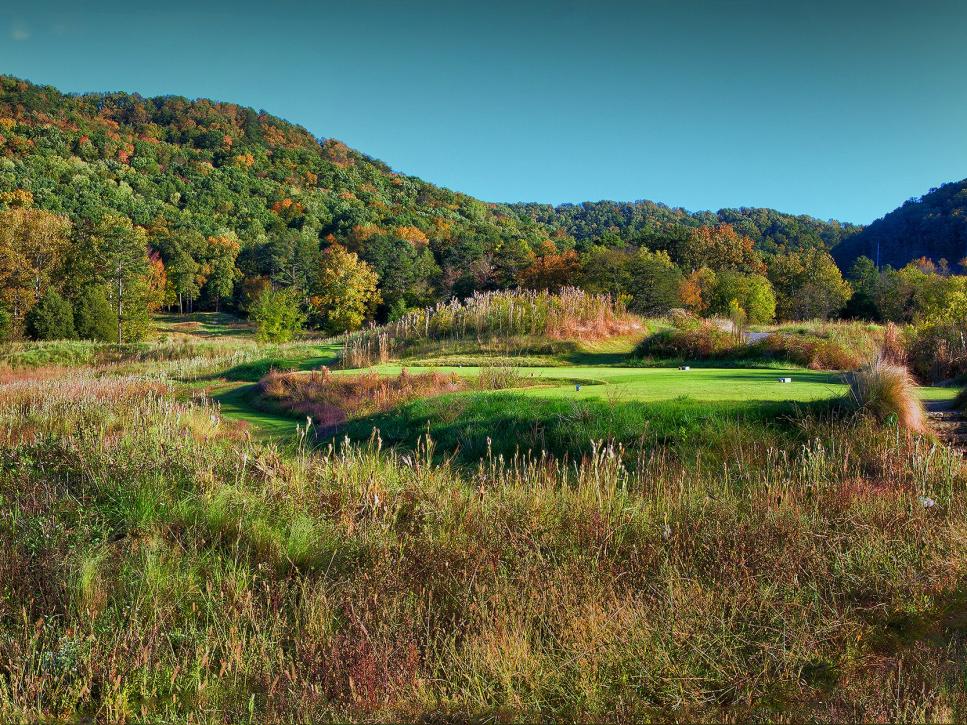
65 . PEACHTREE G.C. | Atlanta | Robert Trent Jones & Bobby Jones (1947) | 7,414 Yards, par 72
The design collaboration by amateur star Bobby Jones and golf architect Robert Trent Jones (no relation) was meant to recapture the magic that the Grand Slam winner had experienced when he teamed with Alister Mackenzie in the design of Augusta National. But Trent was an even more forceful personality than the flamboyant Mackenzie, so Peachtree reflects far more of Trent's notions of golf than Bobby's, particularly in designing for future equipment advances. When it opened, Peachtree measured in excess of 7,200 yards, extremely long for that era. It boasted the longest set of tees in America (to provide flexibility on holes) and the country's most enormous greens (to spread out wear and tear). As it turns out, Trent was a visionary, and decades later others subsequently followed his lead.
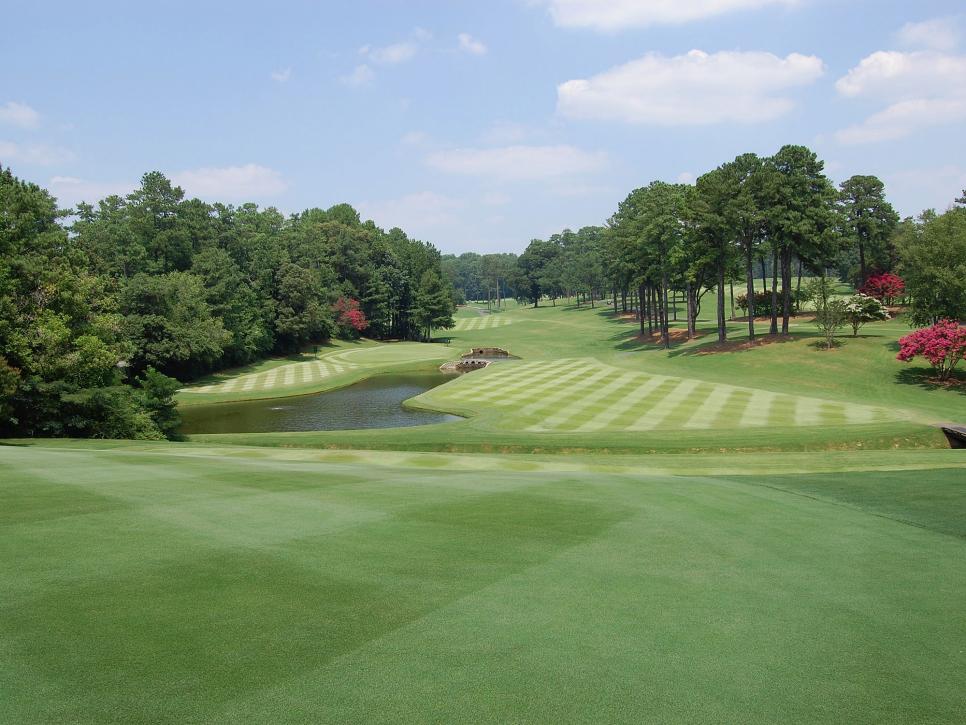
66 . SUNNINGDALE G.C. (NEW) | England | 6,729 yards, par 70
H.S. Colt, who was the club's secretary from 1901 to 1913, laid out the New Course in 1923, well after he'd established his reputation as a grand golf architect. It's considered by most to be tougher than Sunningdale Old (No. 20 on this ranking), mainly because Colt's greens are smaller, with subtle contours that nudge balls toward bunkers hard along the collars. It's a toss-up as to which course is prettier. Both have fields of heather, gorse, Scotch broom and clusters of pine, oak and silver birch.

Photo by David Cannon/Getty Images
67 . THE GOLF CLUB | New Albany, Ohio | Pete Dye (1967) | 7,439 Yards, par 72
The Golf Club, built in 1966, may be the most authentic of Pete Dye's transition period of design, when he first chose to buck convention and start building lay-of-the-land layouts like those he'd seen during a 1963 tour of Scotland. In doing so, Dye re-introduced deception, misdirection and railroad ties into American golf architecture. Its construction attracted the attention of local boy Jack Nicklaus, who visited several times and made some astute suggestions. That led to a five-year Dye-Nicklaus design partnership. The Golf Club remained untouched for 45 years, until 2013, when Dye rebuilt every hole, modestly adjusting some of his original architecture.
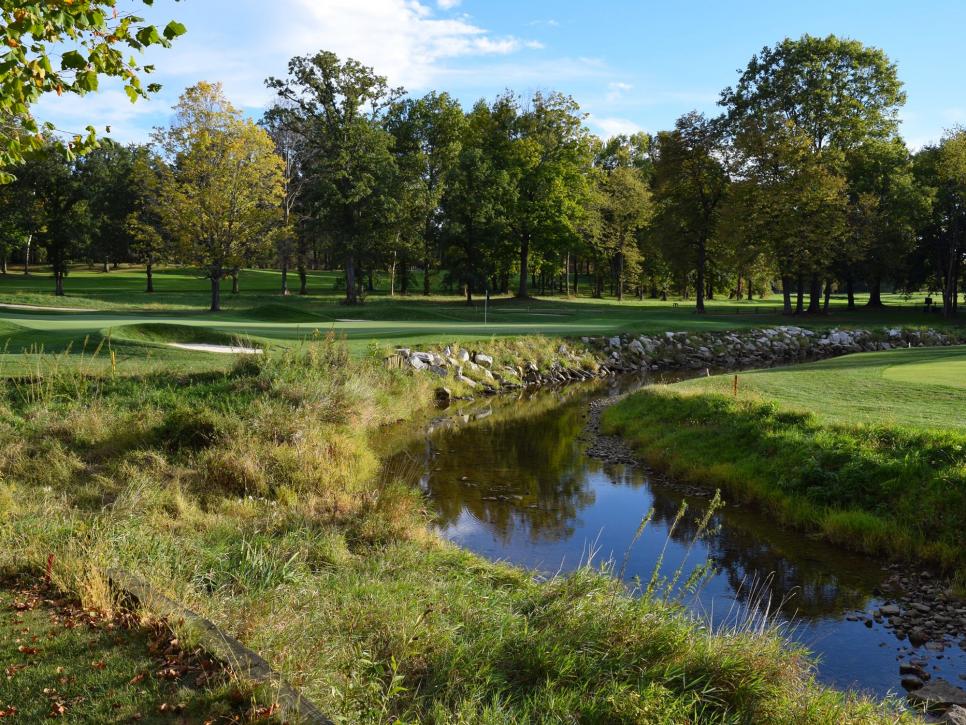
68 . LAHINCH G.C. (OLD) | Ireland | 6,950 yards, par 72
Considered by some to be the St. Andrews of Ireland, the splendid links at Lahinch reflects evolution in golf architecture. After Alister MacKenzie remodeled it in the 1920s, only a few of Old Tom Morris' original holes, like the Klondyke par-5 fourth, and Dell par-3 fifth, both with hidden greens, remained. In the 1980s, Donald Steel altered some of MacKenzie's holes and in the 2000s Martin Hawtree rebuilt everything and added four new holes. One classic MacKenzie par 3, the old 13th, is now a bye hole.

Photo by Stephen Szurlej
69 . SOUTHERN HILLS C.C. | Tulsa, Okla. | Perry Maxwell (1936) | 7,184 Yards, par 71
A product of the Great Depression, funded by Phillips Petroleum money and constructed by hundreds of workers who stood at the gate each morning hoping for a 25-cents-per-hour job that day, Southern Hills is architect Perry Maxwell's great achievement. Nearly every hole bends left or right, posing critical tee shots that must risk something. The putting surfaces have the classic "Maxwell Rolls" and most are guarded by simple yet effective bunkers. By the way, Maxwell, a former banker, negotiated his design fee on a sliding scale. He finished the job $17,500 under the anticipated $90,000 construction budget, and earned $12,500. In an age of hard times, it was a most lucrative deal in golf design.

70 . BANDON DUNES | Bandon, Ore. | David McLay Kidd (1999) | 6,732 Yards, par 72
Chicago recycled products mogul Mike Keiser took a gamble when he chose tenderfoot architect David McLay Kidd to design a destination daily-fee on the remote southwestern coastline of Oregon. But the design Kidd produced, faithful to the links-golf tenets of his native Scotland, proved so popular that today Keiser has a multiple-course resort at Bandon Dunes that rivals Pinehurst and the Monterey Peninsula. Exceeds them, perhaps. None of that would have happened if David Kidd hadn't produced a great first design.

71 . THE BLUFFS HO TRAM STRIP | Ho Tram, Vietnam | 6,855 yards, par 71
This is a 2014 design by Greg Norman, an Australian who now lives in Florida, so it's no surprise that Bluffs Ho Tram is very reminiscent of a Florida golf course, Jupiter Hills. Like Jupiter, it's separated from the ocean by a highway, but plays through dramatic sand dunes covered in tropical vegetation, has joint fairways and even a pair of par 3s playing from a common dunes-top tee box complex to greens in opposite directions. As the name suggests, The Bluffs has some dramatic elevations, with the long par-3 15th green at the highest point, 165 feet above the South China Sea.
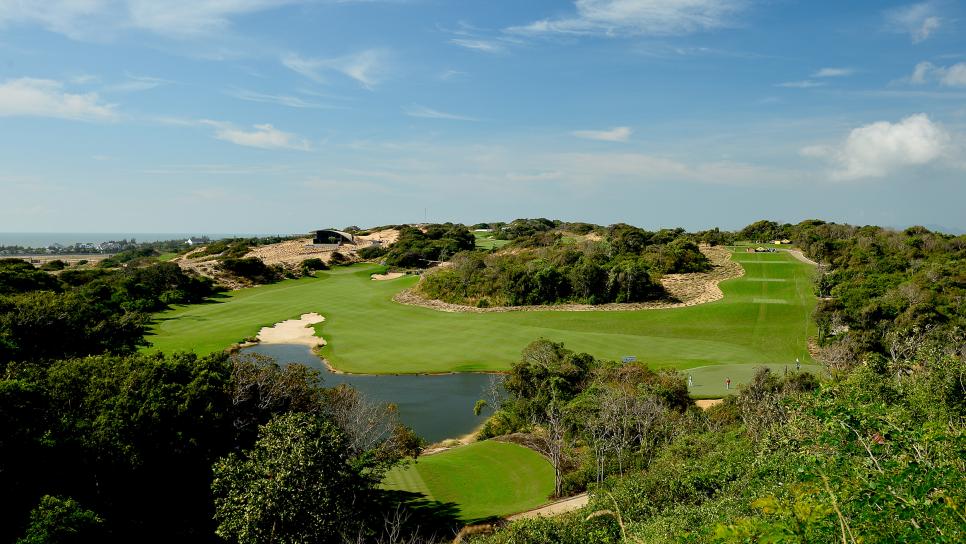
2015 Khalid Redza/Asian Tour/Getty Images
72 . SAN FRANCISCO G.C. | San Francisco | A.W. Tillinghast (1924) | 6,830 Yards, par 71
San Francisco Golf Club's clever routing was done mostly by a trio of club members, who first staked out the course in 1918. A.W. Tillinghast remodeled the course in 1923, establishing its signature greens and bunkering. He also added the par-3 seventh, called the "Duel Hole" because its location marks the spot of the last legal duel in America. Three holes were replaced in 1950 in anticipation of a street widening project that never happened. In 2006, the original holes were re-established by Tom Doak and his then-associate, Jim Urbina.
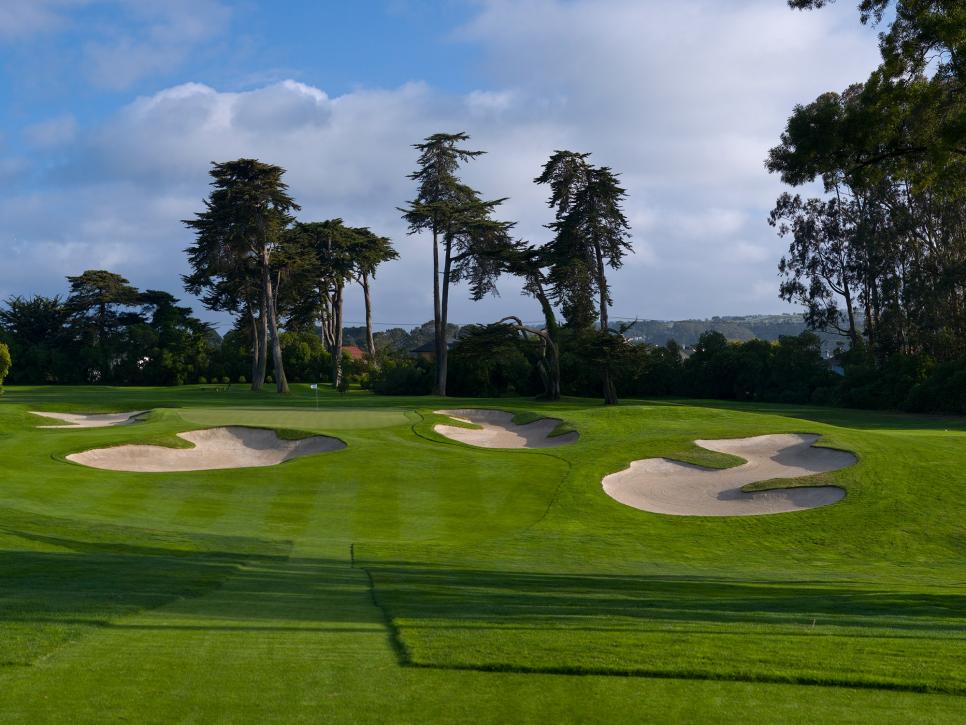
73 . NATIONAL G.C. OF CANADA | Woodbridge, Ontario, Canada | 7,235 yards, par 72
George Fazio once lost a U.S. Open in a playoff to Ben Hogan and his architecture reflected the sort of discipline needed to win that championship: tight well-guarded fairways, big, well-bunkered, fast-paced greens and polished conditions. National G.C. of Canada reflects that and more, with gambling water hazards and double doglegs. In 2005, Tom Fazio, who helped his uncle with the original 1974 design, rebunkered some holes and created a new par-4 16th.

Photo by Popperfoto/Getty Images
74 . BETHPAGE STATE PARK (Black)
Farmingdale, N.Y. / Joseph H. Burbeck & A.W. Tillinghast (1936) 7,468 Yards, par 71
Sprawling Bethpage Black, designed in the mid-1930s to be "the public Pine Valley," became the darling of the U.S.G.A. in the early 2000s, when it played both its 2002 and 2009 U.S. Opens on it. Then it became a darling of the PGA Tour as host of the 2011 and 2016 Barclays. Now the PGA of America has embraced The Black, awarding it the 2019 PGA Championship and 2024 Ryder Cup. Heady stuff for a layout that was once a scruffy state park haunt where one often needs to sleep in the parking lot in order to get a tee time.
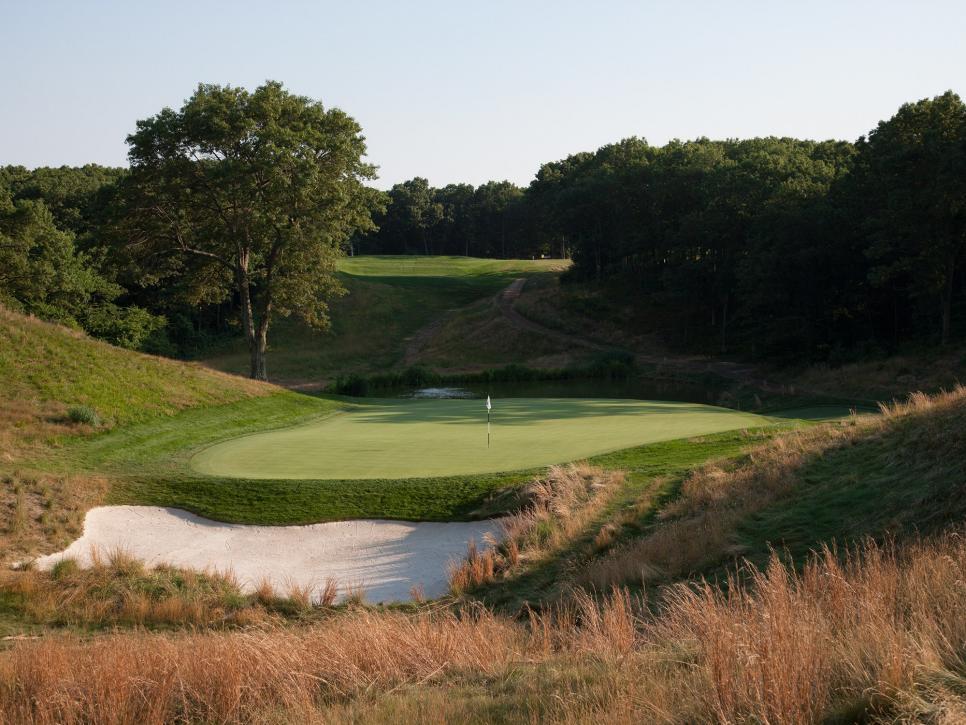
75 . KAURI CLIFFS | Matauri Bay, New Zealand | 7,151 yards, par 72
Like Cape Kidnappers 400 miles to the southeast, Kauri Cliffs occupies an old sheep ranch atop an ocean-front plateau laced with canyons. Unlike Kidnappers, the 2000 layout by design-and-build guy Dave Harman of Orlando, has hills of native rough, stands of fern and more forced carries over gorges. The topography allowed Harman to string the seventh and eighth and 14th through 17th holes parallel to the edge of the Pacific, although several hundred feet above it. Sadly, Harman died in 2004 of tongue cancer. Kauri Cliffs was his finest achievement.
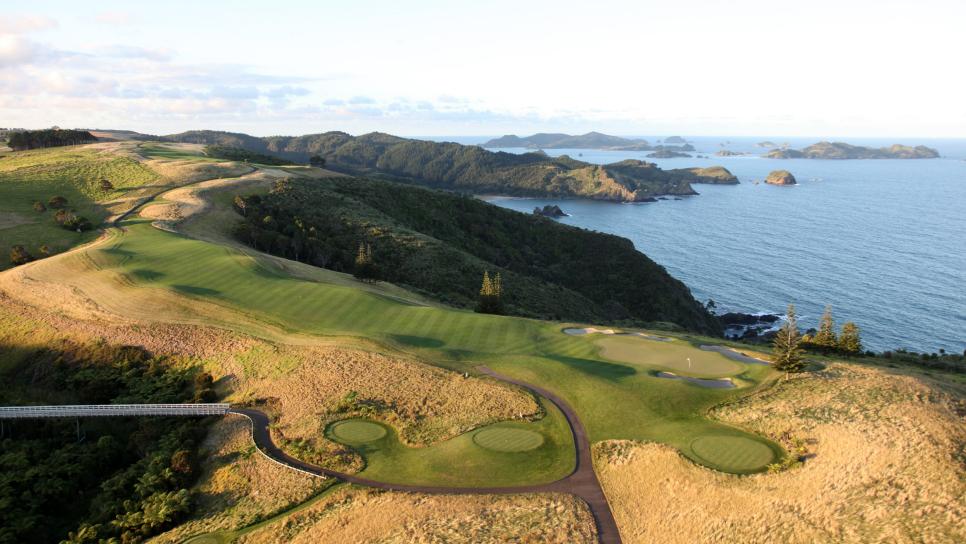
76 . FANCOURT (LINKS) | George, South Africa | 7,578 yards, par 73
Created by Gary Player and then-associate Phil Jacobs from a dead flat airfield, over 760,000 cubic yards of earth were churned and piled to create the first faux links in South Africa. (Player later added the similarly-themed Bramble Hill G.C. next door.) They used cool-season grasses to promote bounce-and-roll on their topsy-turvy fairways. Greens, mostly long and thin or wide and shallow, are guarded by revetted pot bunkers. The Links hosted the 2003 Presidents Cup as well as the 2005 South African Open and 2012 Volvo on the European Tour.

Photo by David Cannon/Getty Images
77 . SWINLEY FOREST G.C. | Ascot, England | 6,045 yards, par 69
Due west of Sunningdale G.C. in London's heathland is Swinley Forest, which H.S. Colt described as the "least bad course" he ever designed. Much of its reputation is built around its five par 3s, each with its own personality and challenge. Colt supposedly located them first, then built around them, using an ideal balance of short and long par 4s on each nine. The par-3s are indeed outstanding; the 17th looks like it might have been the role model for A.W. Tillinghast's 10th at Winged Foot's West course.

David Alexander/Getty Images
78 . BALTUSROL G.C. (Lower) | Springfield, N.J. | A.W. Tillinghast (1922) | 7,400 Yards, par 72
Jack Nicklaus won two U.S. Opens on Lower Baltusrol, setting a tournament record each time. Phil Mickelson and Jimmy Walker won PGAs on it. But Baltusrol Lower's most historic event was the ace by architect Robert Trent Jones in 1954 on the par-3 fourth, instantly squelching complaints of critical club members who felt Trent's redesign made it too hard. Trent's younger son Rees has been Baltusrol's consulting architect in recent decades. An avowed A.W. Tillinghast fan, he lightly retouched the Lower's design for its latest major, the 2016 PGA Championship.

79 . PIKEWOOD NATIONAL G.C. | Morgantown, W. Va. | J. Robert Gwynne & John Raese (2009) | 7,588 Yards, par 72
Fifteen years ago, mining company officers John Raese and Bob Gwynne started building a golf course on a newly-acquired parcel of forest that their firm will eventually – a hundred years from now - mine for high quality limestone. Using company engineers and construction equipment, and guidance by veteran tour pros Johnny Pott and Dow Finsterwald, they spent a decade creating Pikewood National. A natural waterfall became the backdrop for their par-3 fifth hole and the linchpin of their routing, which plays along bluffs, through forest and over rapids.
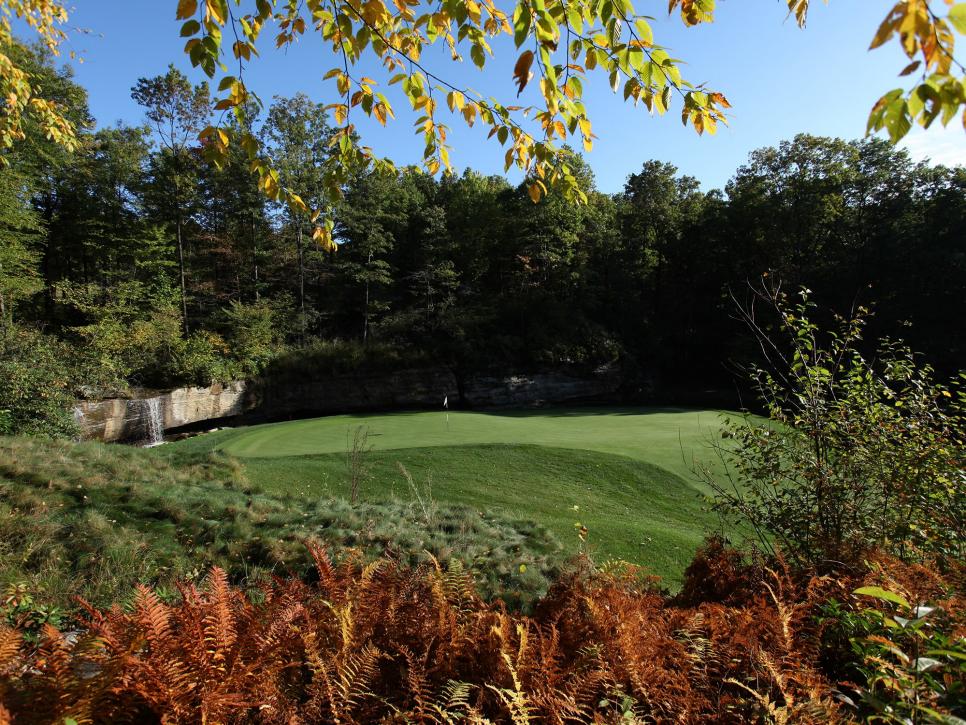
80 . SEBONACK G.C. | Southampton, N.Y. | Jack Nicklaus & Tom Doak (2006) | 7,534 Yards, par 72
Not since Augusta National had the nation's greatest golfer teamed with one of the most highly-regarded course architects on a design project. But the joint venture by Jack Nicklaus with Tom Doak at Sebonack was complicated by the fact that golfer Nicklaus was also an esteemed course architect in his own right, and the project sat right beside two American icons, Shinnecock Hills and National Golf Links. Some pundits have reduced Sebonack to "Tom's bunkers, Jack's greens," but in truth it's just the opposite. Doak convinced Nicklaus to go with small greens of sweeping contours and little imperfections the likes of which Jack would never have considered on his own. Meanwhile, Jack insisted that Tom tone down his usual ragged, jagged bunker faces to make them palatable to high-handicap club members. Sebonack hosted the 2013 U.S. Women's Open to great success.

81 . ROYAL TROON G.C. (OLD) | Scotland | 7,202 yards, par 71
Looks are deceiving at Royal Troon. It looks straightforward, almost docile, until the wind blows. Then, if play out to the ninth hole is downwind, as it usually is, the homeward nine becomes a long march into a stiff breeze, if not an ocean gale. Troon dates from 1878, was given its Royal title 100 years later. Few know its famed 123-yard 8th, the Postage Stamp, the shortest in British Open golf, was originally a blind par 3; the present green wasn't built until 1910. In 2016, Royal Troon was the site of one of the most dramatic duels in Open history, with Henrik Stenson prevailing over Phil Mickelson to win his first major title.

Photo by David Cannon/Getty Images
82 . CASTLE PINES G.C. | Castle Rock, Colo. | Jack Nicklaus (1981) | 7,696 Yards, par 72
When Golf Digest began its annual Best New Course awards in 1983, the review panel selected Castle Pines as the Private Course winner, but Bill Davis, co-founder of Golf Digest and founding father of all its course rankings, didn't care for the course and vetoed its inclusion. So no private course was honored that year. Davis soon recognized his error, and in 1987—its first year of eligibility—Castle Pines joined America's 100 Greatest and has remained there ever since. Club founder Jack Vickers, a Midwest oilman, had urged architect Jack Nicklaus to produce a mountain-venue design worthy of a major championship. Jack did, but when a championship never resulted, Vickers established his own, The International, which for years was the only PGA Tour event played under a unique Stableford format. It's a pity that The International is no longer on the Tour's schedule.
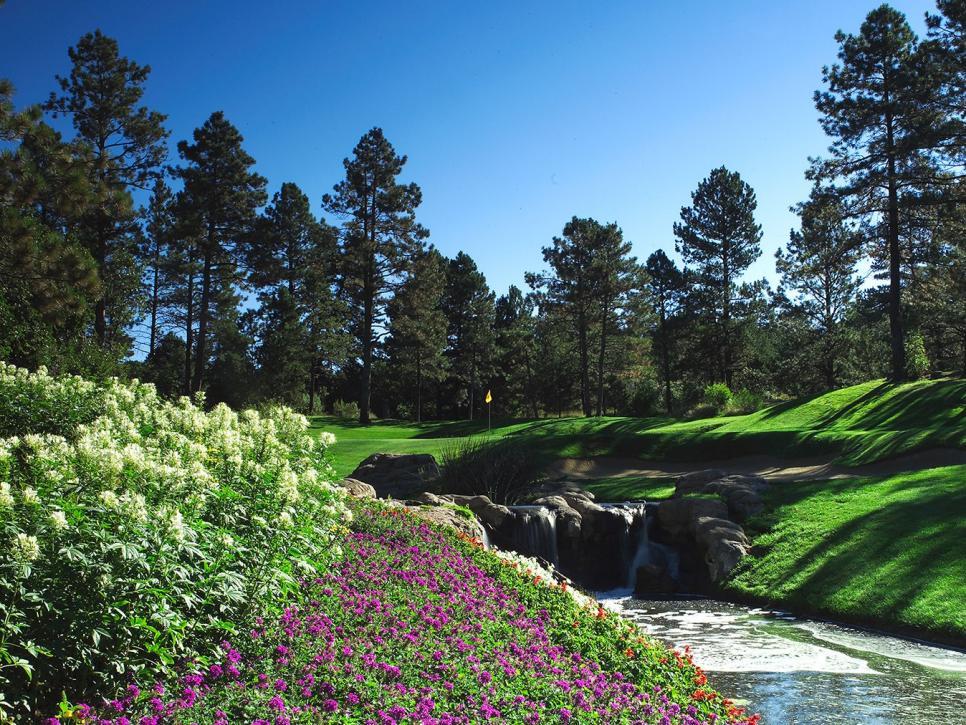
83 . VICTORIA NATIONAL G.C. | Newburgh, Ind. | Tom Fazio (1998) | 7,239 Yards, par 72
Built atop Peabody Coal Company's long-abandoned Victoria strip mine in southern Indiana, Victoria National was a simple routing for Tom Fazio. He just followed the corridors (the perfect width for fairways) that existed between mining spoil mounds (long since overgrown with trees) and some 40 acres of fingery lagoons that had formed as steam shovels carving out coal deposits hit the water table. Chosen as Best New Private Course of 1999, Victoria National stunned most panelists. One gushed it was, "the most unusual, unpolished and unpretentious Fazio design ever." Another called it, "probably the hardest Fazio course I've played. More penal than Pine Valley." Fazio concurred with that assessment. "It's U.S. Open-quality now," he said soon after it opened. "If the wind blew, it'd be too hard."

84 . ERIN HILLS G. CSE. | Erin, Wis. | Michael Hurdzan, Dana Fry & Ron Whitten (2006) | 7,812 yards, par 72
Despite a rumor spread by many, Erin Hills wasn't designed specifically to host a U.S. Open. Its original concept was to be a simple, affordable, lay-of-the-land layout, to prove Mother Nature is indeed the best golf architect. The concept changed -- some greens moved, one blind par-3 eliminated -- as the quest for a U.S. Open grew. The dream has come true. After trial runs hosting the 2008 U.S. Women's Publinks and the 2011 U.S. Amateur, Erin Hills hosts the U.S. Open in 2017, the first time the event has ever been in Wisconsin.
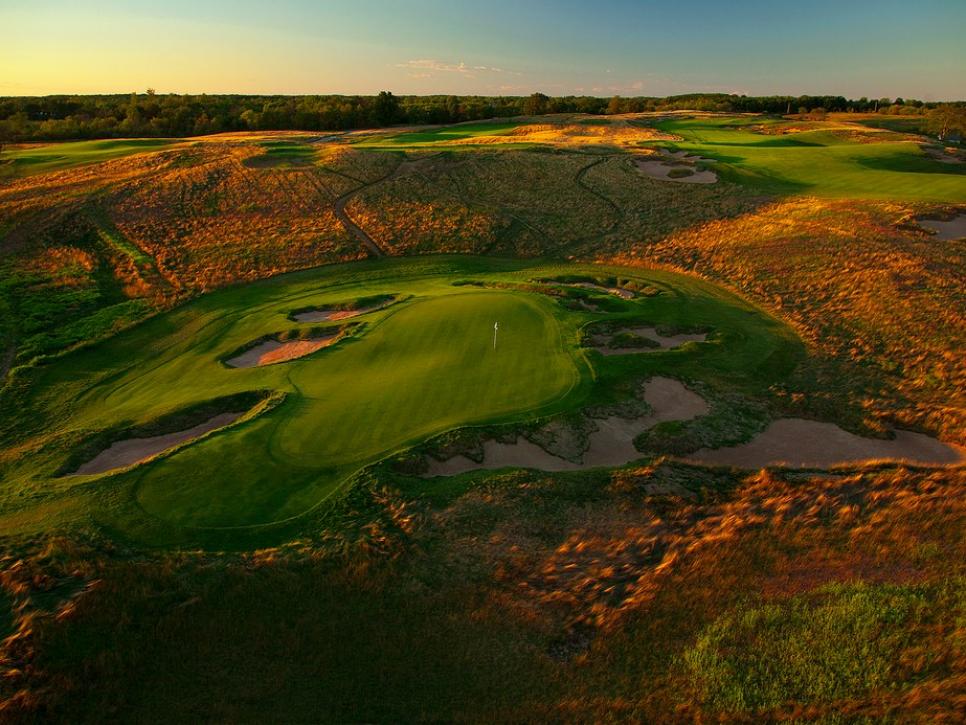
85 . ROYAL PORTHCAWL G.C. | Wales | 7,065 yards, par 72
Considered a seaside venue but not a true links, Royal Porthcawl, situated on the south coast of Wales, doesn't have returning nines, but it's not an out-and-back routing either. Instead, the front nine moves in a clockwise crescent-shaped manner, with the back nine running counterclockwise inside the crescent. Only the first three holes play adjacent to Bristol Channel, but there are ocean views and ocean winds on all the inland holes too, which are on higher ground. The 2017 Senior Open was contested at Royal Porthcawl, with Bernhard Langer winning a record 10th senior major.

86 . VALDERRAMA G.C. | Sotogrande, Spain | 6,990 yards, par 71
Best known as the site of the 1997 Ryder Cup, won by Europe in a squeaker, Valderrama was a favorite design of the late architect Robert Trent Jones. His tight, twisting fairways, pinched at every turn by squat olive trees, led to surprisingly small putting surfaces protected by Trent's trademark splashy bunkers. Valderrama contains one of the more controversial holes in golf: the par-5 17th guarded by water in front, which European captain Seve Ballesteros toughened for that Ryder Cup. It influenced the outcome then, and was a game changer again in 2017, when Sergio Garcia won his own foundation's tournament, the European Tour's Andalucia Valderrama Classic. His birdie on 17 in the final round was the margin of victory.
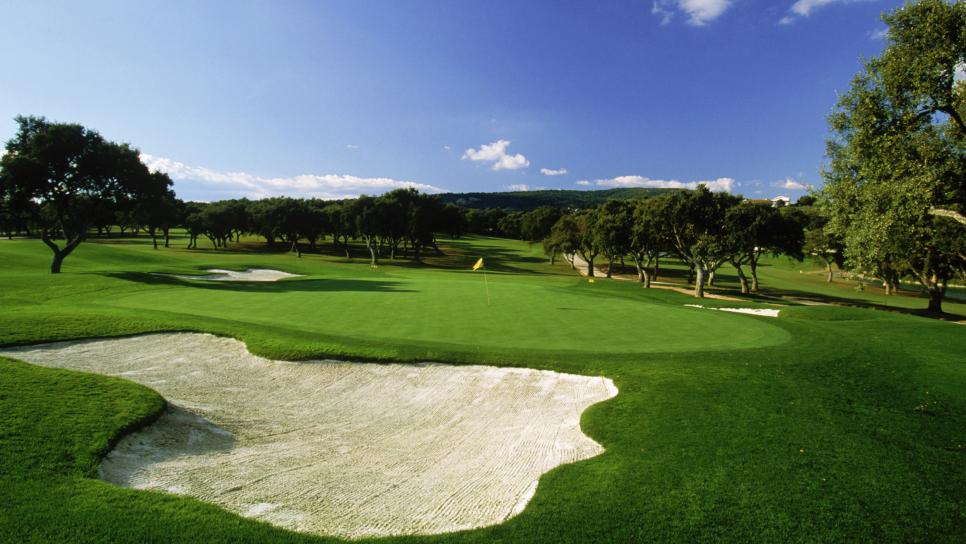
Getty Images
87 . BUTLER NATIONAL G.C. | Oak Brook, Ill. | George Fazio & Tom Fazio (1974) | 7,523 yards, par 71
Butler National was former tour player George Fazio's ideal of a championship course, with 10 carries over water in 18 holes. Even before it opened, it was signed to serve as permanent site of the Western Open. Problem was, when it opened, it was the last cool-weather venue on the PGA Tour to utilize bluegrass rather than bent-grass for its fairway, and several prominent golfers declined to play Butler National because of potential flyer-lies from those fairways. Eventually the turf was converted, but then the Shoal Creek scandal occurred. Rather than change its restricted men's-only policy, the club relinquished its role of Western Open host after the 1990 event. So why include a club on America's 100 Greatest that won't allow female panelists a chance to evaluate it? Because we rank golf courses, not club policies.
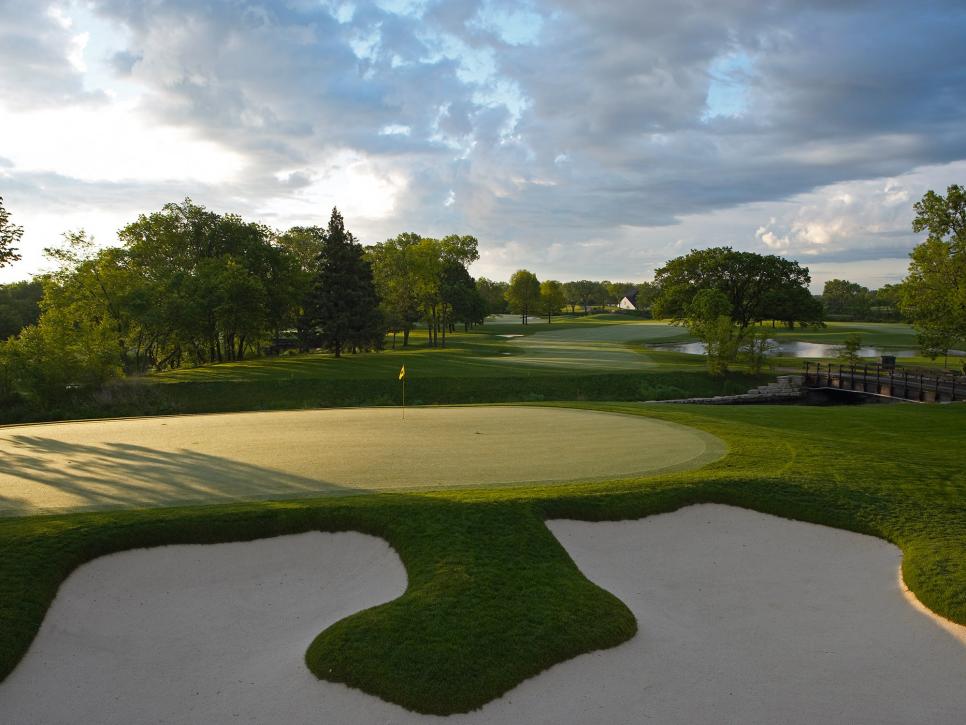
88 . GARDEN CITY G.C. | Garden City, N.Y. | Devereux Emmet (1899) | 6,922 yards, par 73
Minimalist in its design (you can still see the faint traces of old roadbeds over which the course was routed) and natural in its upkeep, Garden City G.C. is one of the great early tournament venues in the U.S. Before the 1908 U.S. Amateur, Walter Travis remodeled the course into what it is today, its strategies dictated by many deep pot bunkers. Travis installed them to promote "thinking golf," but one player soon dubbed Garden City the home of the "God-fearing approach shot."

89 . CABOT LINKS | Inverness, Nova Scotia, Canada | 6,854 yards, par 70
The older sister to Cabot Cliffs is not a natural links, though it looks and plays like it. Cabot Links was man-made by designer-shaper Rod Whitman on a coastal coal mine staging area that serviced mines beneath the sea. Bump-and-run on firm fescue turf is the game on this understated layout, with muted dunes, austere bunkering and gentle, generous greens. Call it Canada's Portmarnock, though Ireland has no match for Cabot's postcard par-4 11th, a dogleg-left around a tidal yacht basin. In early routings, that was going to be the closing hole.

Evan Schiller
90 . OLD MACDONALD | Bandon, Ore. | Tom Doak & Jim Urbina (2010) | 6,944 yards, par 71
Old Mike Keiser had a course. Name of Bandon Dunes. Hugged the cliffs of Oregon gorse. It made golfers swoon. So he added one more, then a third next door. Here a lodge, there a hut, even built a pitch & putt. Now it's America's top resort. Name of Bandon Dunes. But Old Mike Keiser wanted more. Down at Bandon Dunes. An ode to an architect he adored. Cut from heather and broom. So Old Macdonald came to be. In spite of a bad economy. Here it's big, there it's bold. Everywhere it looks real old. A Road Hole here, a Cape Hole there. Bottle Hole, Biarritz, ocean winds that'll give you fits. Short and Eden fit the scenes. Especially with enormous greens. Old Macdonald is part of the lore. Now at Bandon Dunes.

91 . YAS LINKS | Abu Dhabi, United Arab Emirates | 7,414 yards, par 72
Designed by American Kyle Phillips, whose breakthrough course was Kingsbarns in Scotland (59th on this ranking), Yas Links is part of a massive Arabian Gulf entertainment complex that includes a Formula 1 racetrack and a Ferrari World amusement park and a second 18 soon to begin construction. As the name suggestions, Phillips fashioned this as a warm-weather links, using two million cubic yards of sand dredged from an adjacent marina to and give the layout the shape and contour, then covering everything with salt-tolerant Paspalum turf. Eight holes play along a vast intracoastal waterway that leads to the Persian Sea, including holes 14 through 18, a most invigorating stretch.
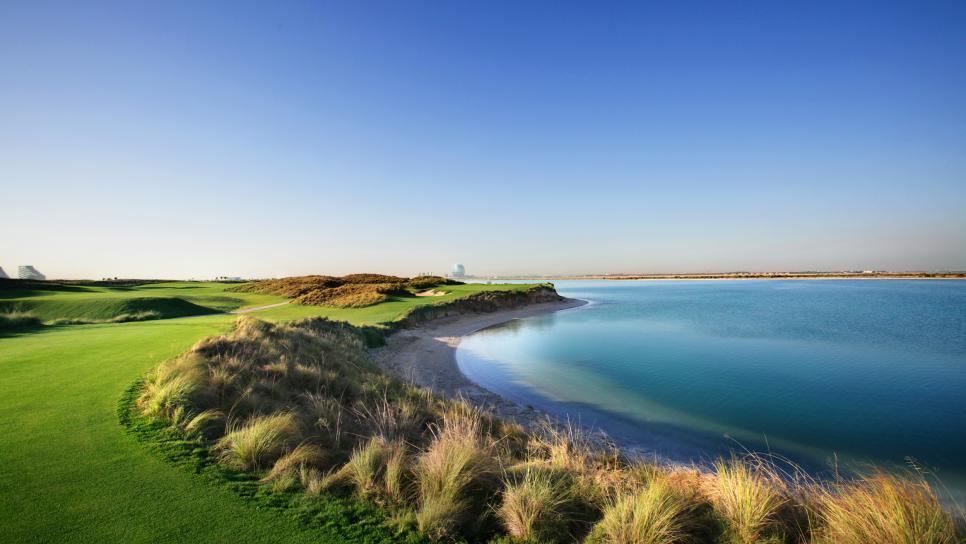
92 . VICTORIA G.C. | Melbourne, Australia | 6,888 yards, par 72
Located kitty-corner across a road from Royal Melbourne, Victoria G.C. is the home course of stars Peter Thomson and Geoff Ogilvy. It was designed originally by a couple of club founders. Alister MacKenzie made bunkering suggestions during a 1926 visit, changes later implemented by Alex Russell. Victoria has smaller greens than at other prominent Melbourne courses, and the bunkers hard against the collars make them play even tighter. Once heavily forested, consulting architect Michael Clayton is slowly removing many trees..
93 . ROYAL LYTHAM & ST. ANNES G.C. | England | 7,118 yards, par 70
Perhaps the least dramatic-looking links in The Open rota, mainly because it's surrounded by houses and a rail line, with the seacoast being hundreds of yards distant and never in sight. Lytham boasts over 200 bunkers, most built a century ago, when the club was heralded as a pioneer of natural bunkering. Its par-3 first hole is unusual, while its finish, six straight par 4s, is a terrific challenge that was, in 2011, the downfall of Adam Scott and a triumph for Ernie Els. Royal Lytham next hosts the 2018 Ricoh Women's British Open.
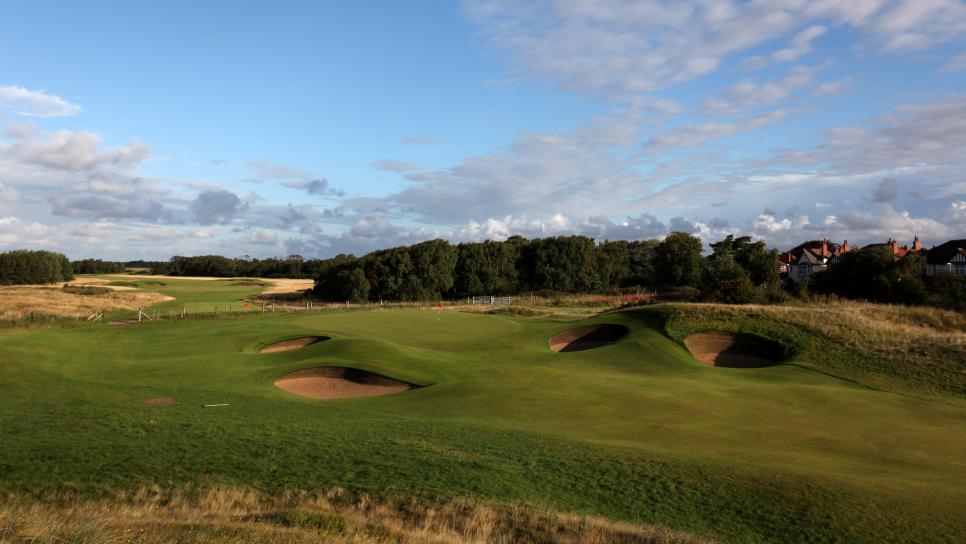
94 . MEDINAH C.C. (No. 3) | Medinah, Ill. | Tom Bendelow (1928) | 7,657 yards, par 72
Medinah No. 3 is Exhibit A for the notion that great golf courses aren't created, but evolve. A major tournament site since 1949, it has undergone a succession of remodelings and has improved with every session. Its par-3 17th is the most prominent example. It was shifted to a new location in 1986, to precede a whole new 18th hole. (The original 17th is now the 13th.) Ten years later, the 17th green was moved away from a lakefront to a spot atop a hill, but after Tiger Woods' first (of two) PGA Championship victories on the course, the green was moved back down to water's edge, where it remains today. For the 2012 Ryder Cup, consulting architect Rees Jones created a totally new par-4 15th, with a pond along both fairway and green to pose risks and rewards. Like a fine wine, Medinah has gotten better with age.
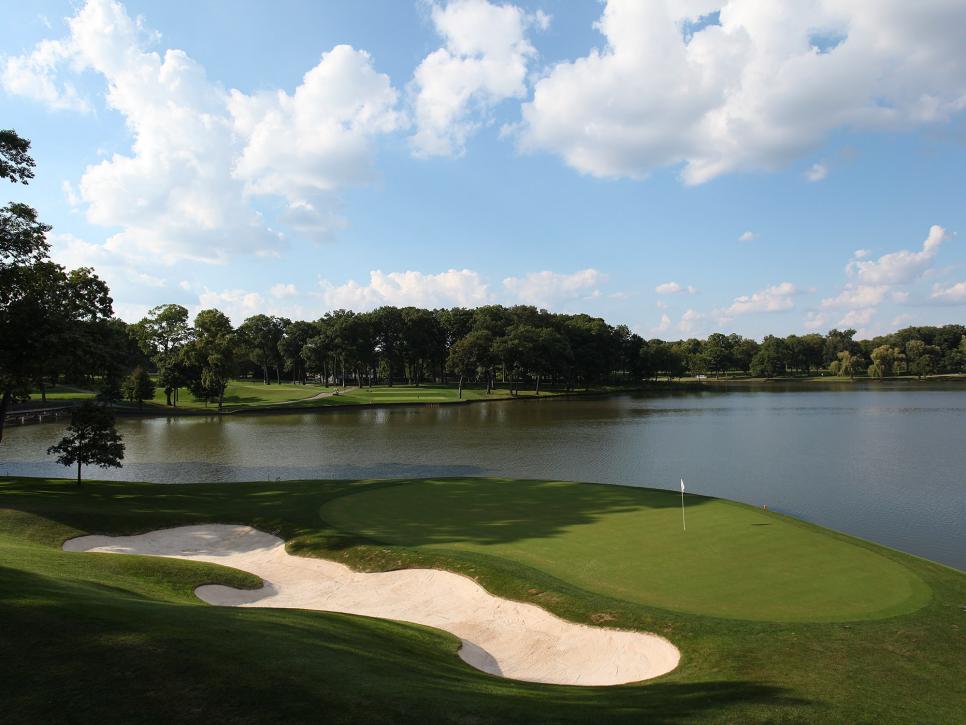
95 . DIAMANTE G.C. (DUNES) | Cabo San Lucas, Mexico | 7,160 yards, par 72
Mexico's first true links, fashioned by Davis Love III and his design team (which included his brother Mark Love and designer Paul Cowley) from a fantastic set of white sand dunes along the Pacific Ocean, huge portions of which are without vegetation and seem like enormous snow drifts. Holes hug the flowing terrain with little artificiality. Two holes on the back nine once played past around a long lagoon, but have been replaced by new 12th and 13th holes on the beach. Now all of the second nine is adjacent to the ocean, amidst the tallest dunes. No other links in the world sports cactus.

Photo by Angus Murray /Sports Illustrated/Getty Images
96 . MISSION HILLS HAIKOU (BLACKSTONE) | Hainan, China | 7,808 yards, par 73
American designers Lee Schmidt and Brian Curley, along with most of their crew, made China their second home (if not their primary one) during much of the past two decades, creating, among other impressive projects, 10 of the 12 courses at Mission Hill Haikou, which is considered to be the largest golf club in the world. The Blackstone Course was built atop black lava, with many holes carved through dense jungle growth. It has spectacular sprawling bunkers and is tightly mown turf everywhere, to help surface drain everything, which gives Blackstone a particular Old School look and playability. The finishing holes around several lakes edged in stacked lava rock was meant to be a theatrical showcase for tournament play. Blackstone was the site of the 2011 Omega Mission Hills World Cup, won by the American team of Matt Kuchar and Gary Woodland.

97 . SPYGLASS HILL G. CSE. | Pebble Beach / Robert Trent Jones (1966) | 6,960 yards, par 72
Given the task of designing a course just up 17 Mile Drive from Pebble Beach and Cypress Point, Robert Trent Jones responded with a combination of Pine Valley and Augusta National. The five opening holes, in Pine Valley-like sand dunes, are an all-too-brief encounter with the Pacific seacoast. The remaining holes are a stern hike through hills covered with majestic Monterey pines (which, sad to say, may someday disappear to pitch canker, but are being replaced in some areas with cypress trees). Add several water hazards that hearken back to the 16th at Augusta (a hole which Trent Jones designed, by the way), and you have what some panelists consider to be Trent's finest work. Others say it's the best course never to have hosted a major event. After all, even Pine Valley and Cypress Point have hosted Walker Cups.

98 . SOUTH CAPE G.C. | Namhae Island, South Korea | 7,313 yards, par 72
Open for five years now, this Kyle Phillips design is slowly gaining attention as visitors from around the world compare its stunning design to everything from Kingsbarns (another Phillips design, which also features ocean views from every tee), to Teeth of the Dog (South Cape has even more holes along the coast) to Cabot Cliffs (there will be a debate as to which has the more dramatic ocean-carry 16th hole) to the granddaddy of ocean courses, Pebble Beach. (If anything, South Cape's tiny downhill par-3 14th to a thumb in the ocean is more treacherous than the short seventh at Pebble Beach.) Look for South Cape to move up the world ranking in future years.

99 . HIRONO G.C. | Hyogo, Japan | 7,169 yards, par 72
This is undoubtedly the finest design of globetrotting C.H. Alison, longtime partner of H.S. Colt. He laid out Hirono in the early 1930s in a hilly pine forest slashed by gulleys, clearing wide corridors and positioning greens on the crests of ridges. What makes Hirono special was Alison's spectacular bunkering, which ranged from diagonal cross bunkers, fearsome carry bunkers and strings of ragged-edged ones. Soon after completion, writers were calling Hirono the Pine Valley of Japan.
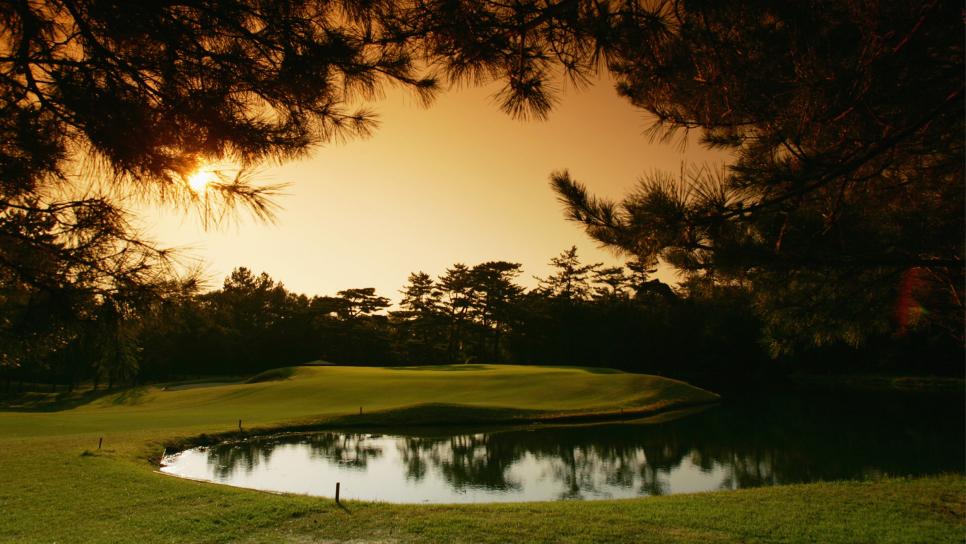
David Alexander/Getty Images
100 . CAPILANO G. & C.C. | West Vancouver, British Columbia, Canada | 6,706 yards, par 72
Capilano is definitely Old School. The Stanley Thompson design is now 80 years old yet mostly untouched despite modern technology. It still sports par 5s well under 500 yards and dramatic green cants too steep for fast speeds. The clubhouse sits atop a true cardiac hill, with most of the course several hundred feet below. From the elevated first tee, the city of Vancouver, five miles south, is visible through a haze of smog. In other directions are peaks of the Coastal Range, particularly Hollyburn Mountain. Fairways are lined with towering Douglas fir, hemlock and cedar, all giving the mistaken impression that corridors are narrow. Thompson's bunkering is spectacular and prolific.
101 . BALLYNEAL G.C. | Holyoke, Colo. | Tom Doak (2006) | 7,147 yards, par 71
If Sand Hills Golf Club stands for the notion that there's nothing more glorious than a round of golf beyond the range of cell phone reception, then Ballyneal (Tom Doak's answer to Sand Hills) proves that isolated golf is even better when Spartan in nature. With no carts and with dry, tan fescue turf on fairways and greens, Ballyneal is even more austere than Sand Hills. It provides absolutely firm and fast conditions, and with many greens perched on hilltops, the effect of wind on putts must be considered.

102 . TPC SAWGRASS (Players Stadium) | Ponte Vedra Beach, Fla. | Pete Dye (1980) | 7,215 yards, par 72
TPC's stadium concept was the idea of then-PGA Tour commissioner Deane Beman. The 1980 design was pure Pete Dye, who set out to test the world's best golfers by mixing demands of precision with target golf. Most greens are ringed by random lumps, bumps and hollows, what Dye calls his "grenade attack architecture." His ultimate target hole is the heart-pounding sink-or-swim island green 17th, which offers no bailout, perhaps unfairly in windy Atlantic coast conditions. The 17th has spawned over a hundred imitation island greens in the past 30 years. To make the layout even more exciting during tournament play, Steve Wenzloff of PGA Tour Design Services recently remodeled several holes, most significantly the 12th, which will now be a drivable par 4. The changes were revealed too late to be considered by panelists for this survey.

103 . CAMARGO CLUB | Indian Hill, Ohio | Seth Raynor & Charles Banks (1927) | 6,659 Yards, par 70
One of Seth Raynor's last designs, it wasn't completed until nearly a year after his death. William Jackson, who later became the club's pro and superintendent, handled the construction and was faithful to Raynor's diagrams with two exceptions: he turned the 16th into a par 4 and the 17th into a par 5. Robert von Hagge added flashy but incongruous bunkering in the early 1980s. They lasted over 20 years, until Tom Doak undertook a restoration in the Raynor style of geometric-shaped bunkers and greens.
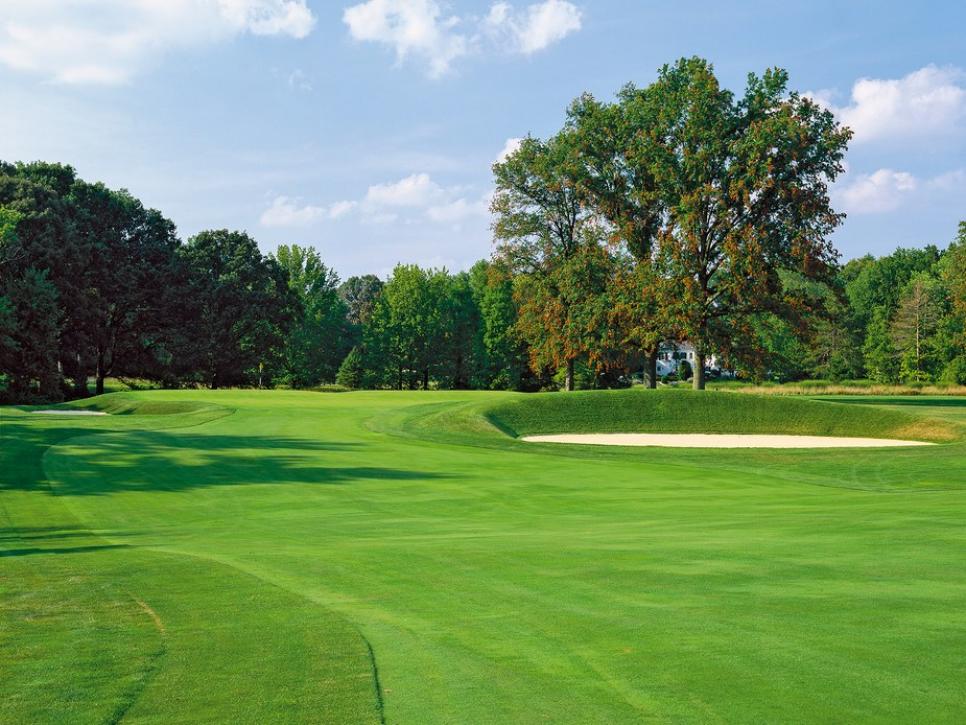
104 . EMIRATES G.C. (MAJLIS) | Dubai, United Arab Emirates | 7,301 yards, par 72
When Emirates G.C. first opened in 1988, it was a literal oasis in the desert, the first all-grass golf course built in the Middle East. Now it sits in the shadows of more than a hundred high rise buildings and thousands of palms and hardwood trees transplanted on the site. Designed by American Karl Litten, who'd previously specialized in residential development courses in Florida, the Majlis Course looks like a Florida transplant, with five lakes coming in play on eight holes. Where he'd normally plot housing lots, Litten maintained as desert. Some of those areas have now become homesites.

David Cannon/Getty Images
105 . KINLOCH G.C. | Manakin-Sabot, Va. | Lester George & Vinny Giles (2001) | 7,203 yards, par 72
Since the only way to successfully establish bent-grass tees, fairways and greens in hot, humid Richmond was to create expansive corridors to allow plenty of sunlight and air to the turf, Kinloch Golf Club has more double fairways posing options and alternate routes than nearly every other course on the 100 Greatest, except perhaps National Golf Links (16th on this ranking). In 2016, George began a long-range master plan of adjustments, including expansion of the alternate fairways on nine and 11, for improved visibility and playability, and removal of thick rough between bunkers and fairway edges. Enhancements will continue in the future.
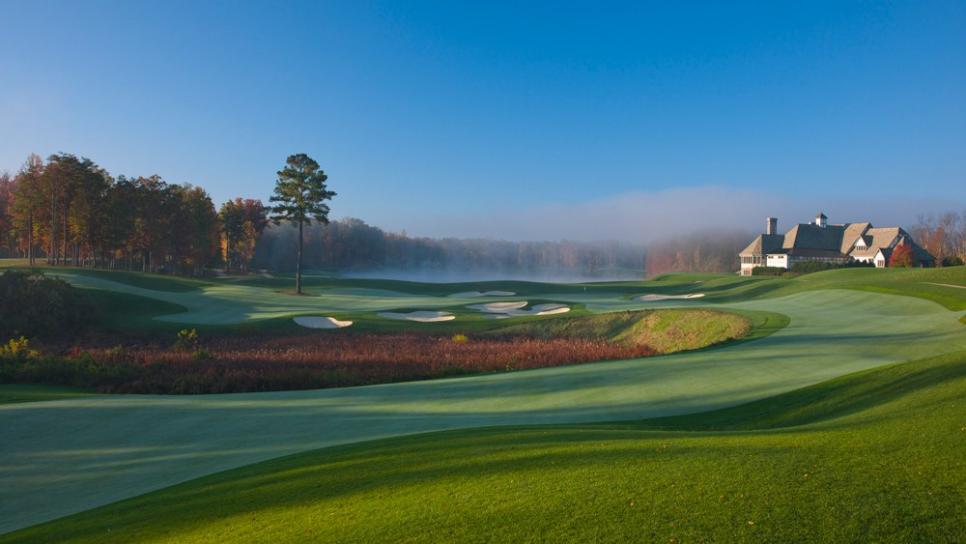
106 . CASTLE STUART G.C. | Inverness, Scotland | 7,009 yards, par 72
Once he completed Kingsbarns (59th in this ranking), owner Mark Parsinen found another ideal venue farther north, on the shores of the Moray Firth. Golf architect Gil Hanse and associate Jim Wagner hand-built Castle Stuart, with Parsinen involved on every hole. Each nine opens with holes framed by shore's edge on one side and a high bluff on the other. Then each nine moves to a mezzanine level where the views are spectacular and several "infinity greens" seem perched on cliffs directly over the sea. Castle Stuart has hosted several Scottish Opens. Parsinen's dream is to host The Open.
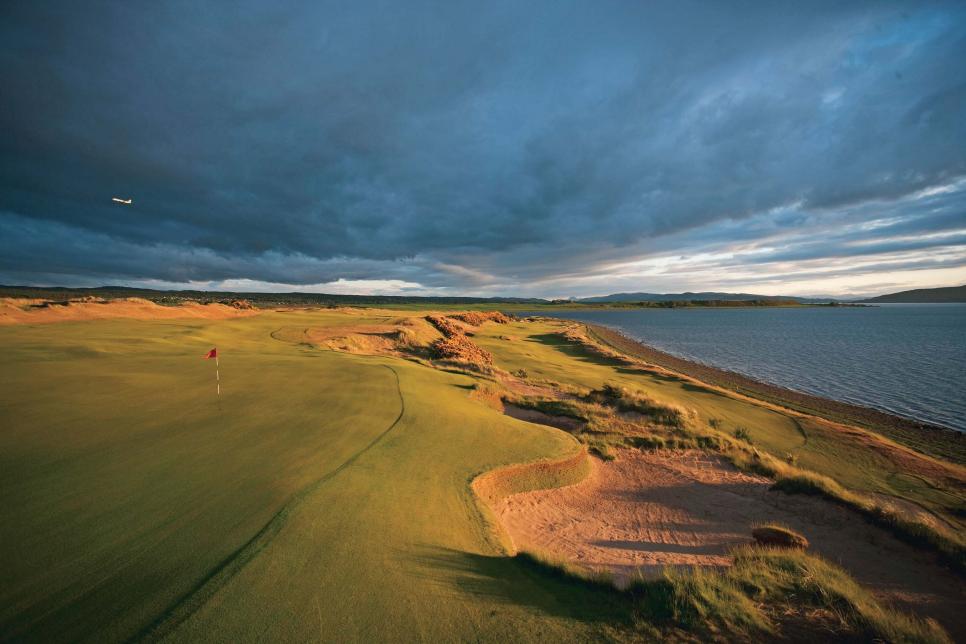
Photo by Stephen Szurlej
107 . MID OCEAN CLUB | Tucker's Town, Bermuda | 6,548 yards, par 71
This was C.B. Macdonald's lone international design, done in the early 1920s with his faithful assistant Seth Raynor, who according to ship records, made most of the trips to the site. Spurred by the 18th Amendment, which established alcohol prohibition in America, Macdonald and his partners bought a bunch of onion and potato fields for the course. Macdonald used his pet template holes mainly on the par 3s – Short, Eden, Biarritz and Redan are all represented – but the par-4 fifth is the standout, with its bite-off-what-you-dare tee shot over Mangrove Lake.
108 . INTERLACHEN C.C. | Edina, Minn. | Willie Watson (1911) | 6,981 yards, par 72
When Bobby Jones won the 1930 U.S. Open at Interlachen (completing the second leg of what would become the game's first Grand Slam), fellow competitor Gene Sarazen insisted the course was tougher than everything but Oakmont. These days, the hilly, tree-lined design with small greens and plenty of bunkers has been the showcase of women's professional golf, hosting the 2002 Solheim Cup, won by the American team, and the 2008 U.S. Women's Open, won by Inbee Park.
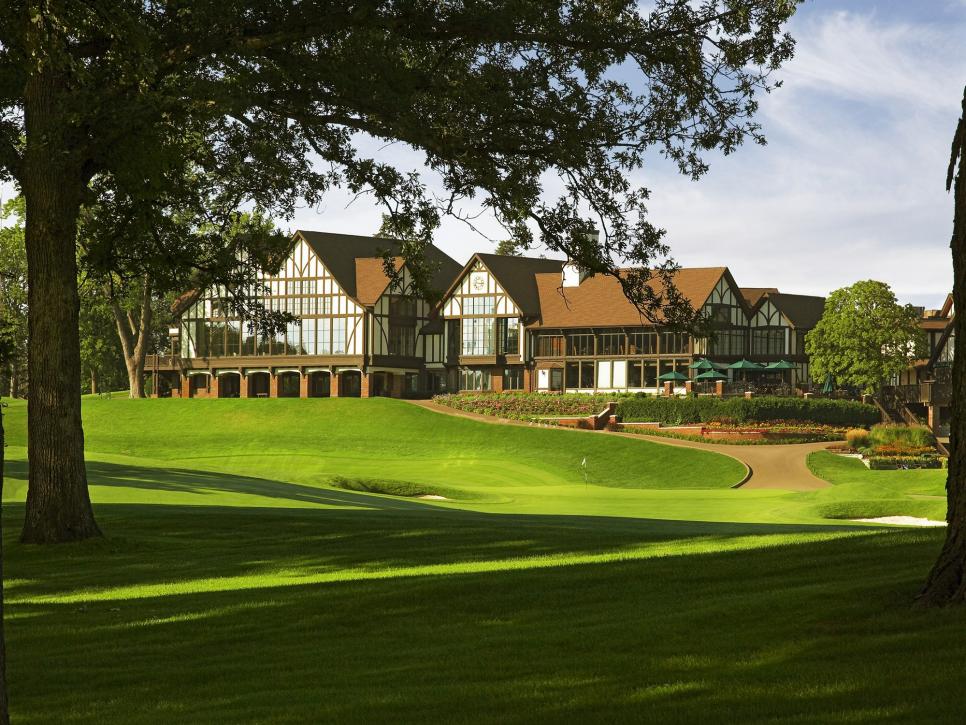
109 . WHISPERING PINES G.C. | Trinity, Texas | Chet Williams (2000) | 7,473 yards, par 72
Corey Robertson, who made a fortune in coal reserves, staked out the Whispering Pines course in the early 1990s, then brought Texas-based golf architect Chet Williams (at the time a design associate of Jack Nicklaus) to help him create strategies through bunkering and green contours. Williams refined the rough-hewn routing cut through east Texas piney woods into a dazzling romp across a gently rolling landscape, culminating in a final six-hole stretch along gator-infested Caney Creek and the headwaters of Lake Livingston.
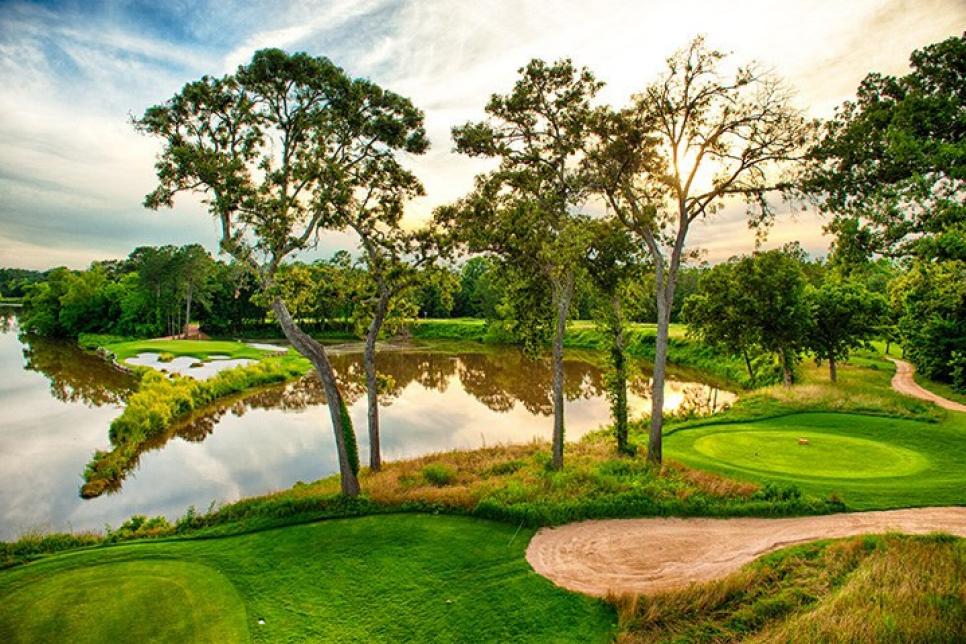
110 . WATERVILLE G. LINKS | Ireland | 7,355 yards, par 72
Waterville has some superb dunes holes, next to the Ballinskellligs Bay, and several laid out in former potato fields. Original owner John Mulcahy and 1947 Masters champion Claude Harmon (Butch's dad) collaborated with Irish golf architect Eddie Hackett on the early 1970s design. A decade ago, Tom Fazio added new par-3 sixth & par-4 seventh holes and altered 13 others, adding new tees, greens and much-needed humps and bumps to the flattish front nine.
111 . CRUDEN BAY G.C. | Scotland | 6,615 yards, par 70
Cruden Bay is yet another marvelous links, stretched along the base of a high bluff with tall dunes to the immediate east blocking views of the North Sea shoreline. Within the course, holes lie among what have been described as "stumpy dunes." They may well be, compared to those at Trump International (124th in this ranking), but the routing is excellent, looping north then south, crisscrossing at the eighth and 16th. There are many blind shots, including consecutive ones to hidden punchbowl greens on the par-4 14th and par-3 15th (pictured below).

Photo by David Cannon/Getty Images
112 . OLD SANDWICH G.C. | Plymouth, Mass. | Bill Coore & Ben Crenshaw (2005) | 6,908 yards, par 71
Old Sandwich Golf Club may be the craftiest Coore-Crenshaw design yet built. Amidst its pines, scrub oaks, gnarly bunkers, chocolate drop mounds, wavy fescue and briar bushes are hints of Baltusrol, National Golf Links, Pine Valley, Pinehurst No 2 and Chicago Golf Club in its cross-bunkering, hazard placement and sandy waste areas. The greens are some of the most rolling of any Coore & Crenshaw design, seeded with a half-dozen bent varieties to give them an old-fashioned mottled appearance. Nobody does old-fashioned better than Coore & Crenshaw.
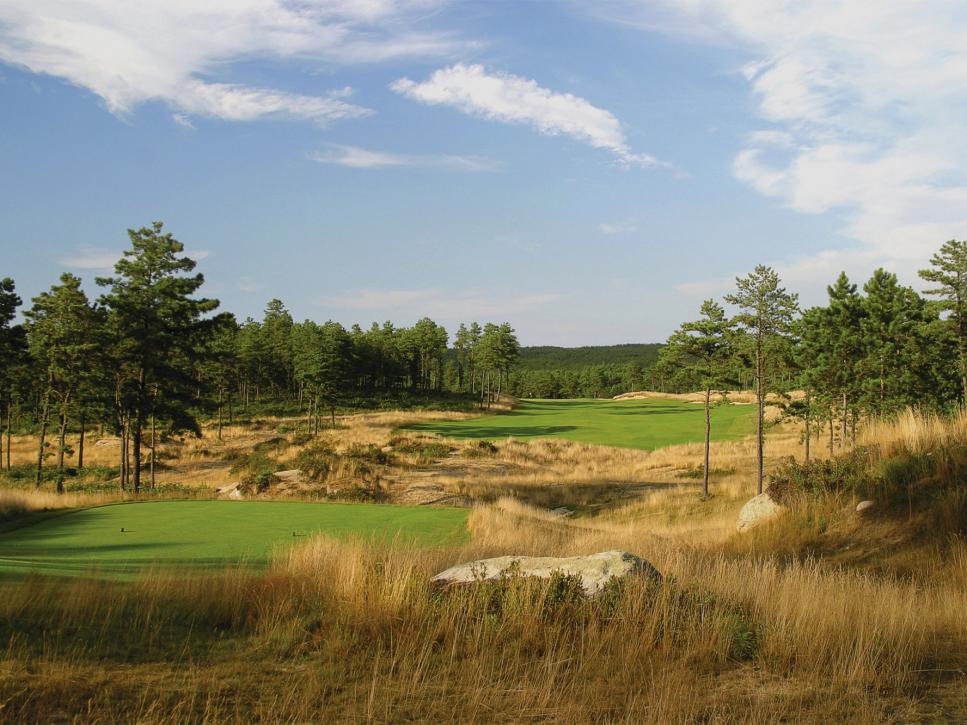
113 . SCIOTO C.C. | Columbus, Ohio | Donald Ross (1916) | 7,140 yards, par 70
When Michael Hurdzan was hired in 2005 to rebuild Scioto's greens to re-establish much of their Donald Ross character, Jack Nicklaus volunteered to assist, since he'd learned the game at Scioto and still remembered the putting surfaces he'd played as a boy. Together they recaptured Scioto's charm, although one green they did not return to a Ross original was the eighth. That green was relocated in 1957 by landscape architect Marion Packard, who created a new island green for the hole. In 2014, while revising the course in preparation for the 2016 U.S. Senior Open, Hurdzan filled in much of the moat on eight, so the par 5 could be played as a long par 4 for championship play.

114 . METROPOLITAN G.C. | Melbourne, Australia | 7,066 yards, par 72
Metropolitan was designed by club members J.B. Mackenzie and C.W. Chapman in 1908 and was revised in 1926 by famed architect Alister MacKenzie, as part of his two-month visit to Australia. But the present design is the work of American architect Dick Wilson, who added eight new holes in the late 1950s. Wilson also revised the remaining holes to reflect his philosophy that golf is meant to be played through the air. Bunkers front nearly every green and pinch nearly every fairway. Metropolitan hosts the PGA Tour's World Cup of Golf in 2018.
115 . PORTMARNOCK G.C. (CHAMPIONSHIP) | Ireland | 7,365 yards, par 72
A true links in rolling ground with soft rather than dramatic dunes, Portmarnock, on a spit of land in the Irish Sea north of Dublin, is known for its routing, which hasn't been altered in over a hundred years and was revolutionary at the time for constantly changing wind direction with every shot. The links is also known for its fairness, as nearly every feature is plainly in view from tee to green. Which makes its maze of bunkers and subtle greens all the more testing.

Photo by David Cannon/Getty Images
116 . BLACK MOUNTAIN G.C. (EAST & NORTH 9S) | Hua Hin, Prachuabkirikhan, Thailand | 7,550 yards, par 72
The first course in Thailand to make Golf Digest's World 100 Greatest, Black Mountain was founded by a group of expatriates from Sweden. Created on land beneath a massive dormant volcano (hence the name), veteran Australian architect Phil Ryan did the original 18, harnessing two streams running through the property to create eight lakes that come into play on 14 holes. Ryan's trademark flowery bunkers in fairways and around greens are so big as to pose testing recovery shots. A third 9, the West, designed by founder Stig Notlov and European tour pro Johan Edfors, opened in 2016.
117 . HAMILTON G. AND C.C. (WEST/SOUTH) | Ancaster, Ontario, Canada | 6,928 yards, par 70
A fascinating H.S. Colt layout, with holes routed in clusters of triangles, traversing the hilly landscape both face-on and diagonally, with meandering creeks winding across fairway landing areas. Tom Clark, who spent 25 years as consulting architect, rebuilt greens and quietly removed many trees to provide playing room and showcase land contours. More recently, Englishman Martin Ebert was brought in to re-establish Colt's bunkering style. Hamilton has hosted the Canadian Open three times since 2003.
118 . OAK TREE NATIONAL | Edmond, Okla. | Pete & Alice Dye (1976) | 7,412 yards, par 71
Originally the men's-only Oak Tree Golf Club, with 18 holes patterned after previous Dye designs (the par-3 eighth, for example, was a close cousin to his 17th at Harbour Town, complete with a basket trap on the left), Oak Tree National has long been considered one of Pete Dye's sternest tests of golf. The hilly layout has numerous water hazards and deep bunkers protecting some very tiny greens, as well as gusting Oklahoma winds and gnarly Bermuda-grass rough. It has been a PGA Tour Champions fixture in recent years, hosting the 2006 Senior PGA Championship and the 2014 Senior U.S. Open.
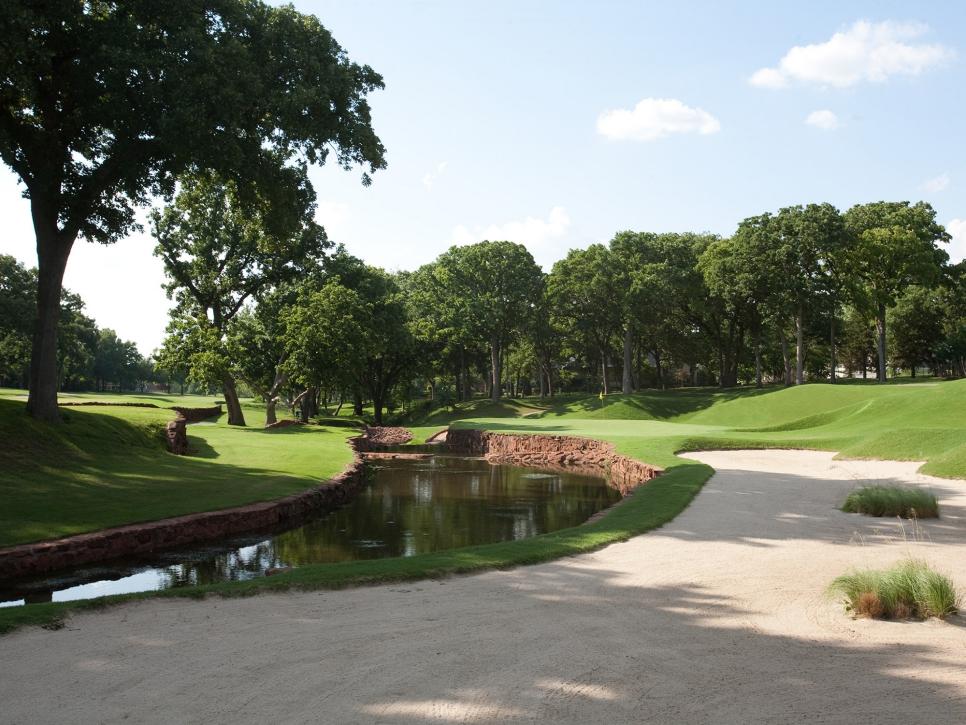
119 . MACHRIHANISH G.C. | Campbelltown, Scotland | 6,462 yards, par 70
To reach Machrihanish, Old Tom Morris needed a train, a steamboat and a long carriage ride. Visitors today have to resort to much the same mode, so remote is Machrihanish, on the southern end of Scotland's Kintyre Peninsula. It's a journey rewarded, from the opening tee shot, which the bold will carry over a beach and Atlantic tide on the left, to the remainder of the links in some of the most rugged dunes known to links golf.
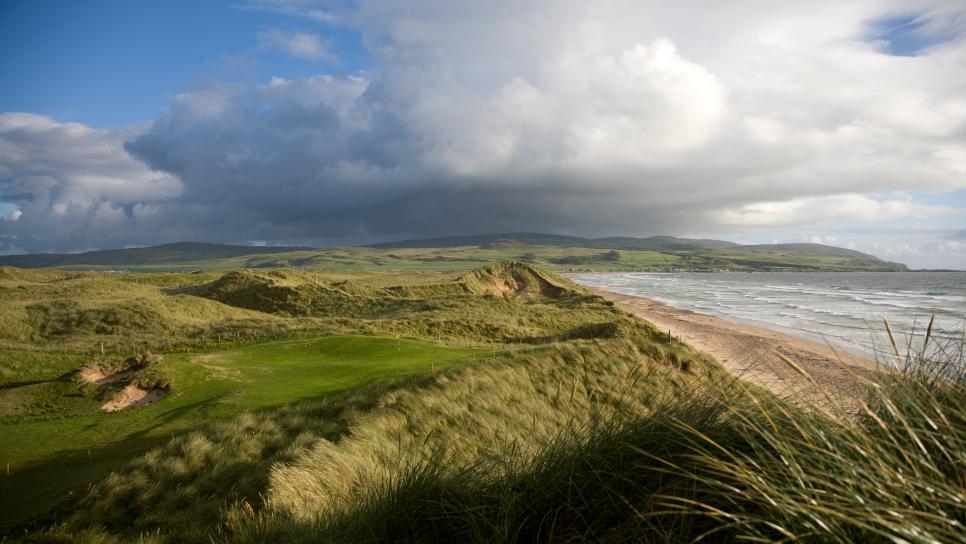
120 . SHESHAN INTERNATIONAL G.C. | Shanghai, China | 7,199 yards, par 72
Sheshan International, at the base of Sheshan Mountain, is considered by some to be the Augusta National of China because of its opulent conditioning. The stylistic design, by Canadian Neil Haworth and his late partner Robin Nelson, incorporates a small forest, a canal, several manmade ponds and a small, deep stone quarry, over which both the drivable par-4 16th and long par-3 17th play. Sheshan hosted the World Golf Championship's HSBC Champions event since 2005. In 2017, the title was won by Justin Rose.
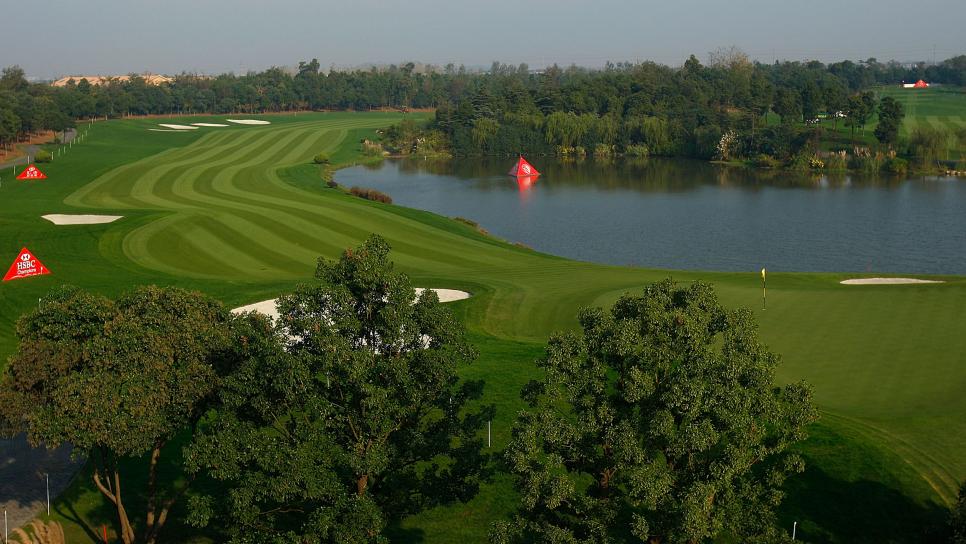
2009 Getty Images
121 . DALLAS NATIONAL G.C. | Dallas | Tom Fazio (2002) | 7,372 yards, par 72
It occupies some of the best golfing terrain in the Dallas Metroplex—rugged hills dotted with cedars—yet Tom Fazio still indulged in considerable shifting of earth when creating Dallas National. The par-3 17th, for instance, is countersunk into an excavated box canyon of rock, while a deep ravine in front of the 18th green was filled in to lessen the difficulty of the approach for average players. There's talk that a new course recently built in the same area of Dallas could have the potential to host a U.S. Open. Dallas National members feel they already have a course worthy of the task.

122 . PUNTA ESPADA G.C. | Cap Cana, Dominican Republic | 7,396 yards, par 72
Jack Nicklaus got his start in golf design working with Pete Dye, and his 10-year-old Punta Espada is a lively version of Dye's 40-year-old Teeth of the Dog course (No. 52 in this ranking) farther down the Dominican coast, from the to the broad waste areas of brilliant white sand usually associated with Pete's work, as well as the low-profile greens and the eight green complexes right on the Caribbean shore. Punta Espada starts and finishes on the Caribbean and returns to it early in the back nine, with the awesome 249-yard, par-3 13th directly over an ocean cove.

2010 Stan Badz/PGA TOUR
123 . PETE DYE G.C. | Bridgeport, W.Va. | Pete Dye (1994) | 7,308 yards, par 72
Like Pikewood National (79th in this ranking), Pete Dye Golf Club is a 100 Greatest course built atop a West Virginia mining deposit, but in this case, it's an active coal mine. (The club's original name was Coal Ridge.) Evidence of that fact is everywhere, from the strip-mine wall along the par-5 eighth and the black cinder bunkers on the par-4 sixth to the abandoned coal train that curls around the outside of the dogleg on the 10th. There's even a coal mine shaft you can walk through to reach the seventh tee. Construction took so long that Dye's style had evolved by the time the full 18 was finally seeded. Early holes sport the railroad-tie motif of Oak Tree National while later holes feature the echo-chamber bunkering of Whistling Straits.
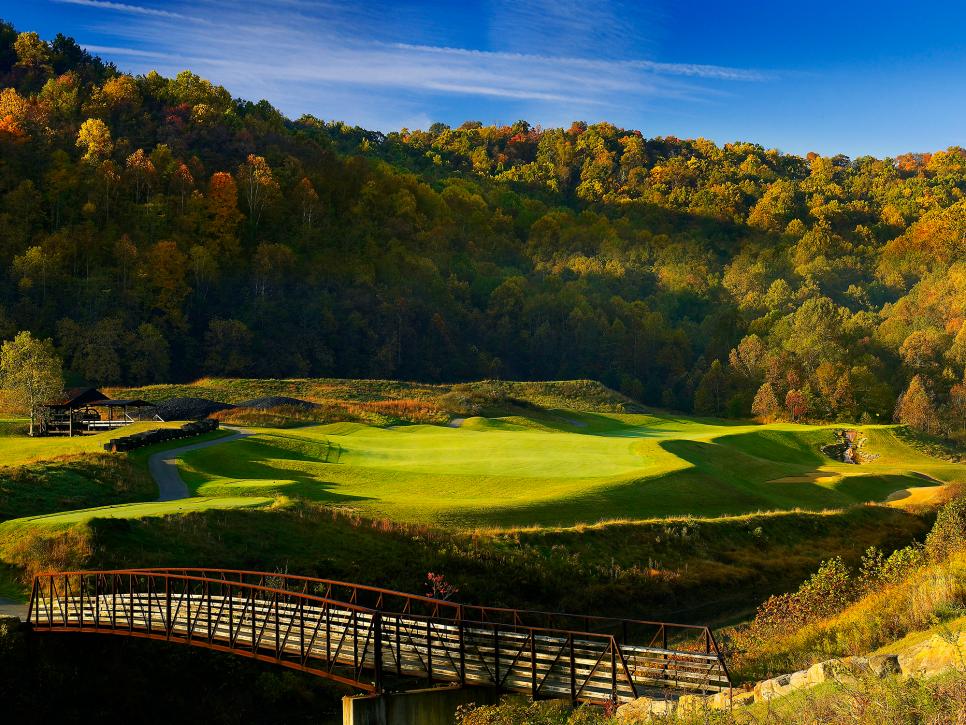
Courtesy of Gary Kellner
124 . TRUMP INTERNATIONAL G. LINKS | Balmedie, Scotland | 7,428 yards, par 72
Just six years old, this Martin Hawtree design is set in as dramatic a set of sand dunes as can be found in golf, better than those at Royal Birkdale and Royal St. George's. Some dunes reach 100 feet above fairways. All are covered in deep marram grasses. Fairways pitch and tumble, often posing downhill lies to uphill targets. Every bunker is at least knee deep, encircled with stacked-sod faces. Greens are perched and edged by deep hollows. Owner Trump Golf Inc. wants an Open; we suspect it'll someday host a Ryder Cup.
125 . LEOPARD CREEK C.C. | Malelane, South Africa | 7,288 yards, par 72
Intended to merge with its Bushvelt environs, what with Kruger National Park and the Crocodile River on the north and west, the Gary Player-designed Leopard Creek is really more akin to a polished, immaculate American layout, with a manmade stream diagonally slashing in front of first and 14th greens, the fifth, 15th, 16th and 18th greens guarded by stone-bulkheaded ponds and the par-5 ninth green on an island. But no course in America has views of giraffes, hippos and crocodiles in the wild.
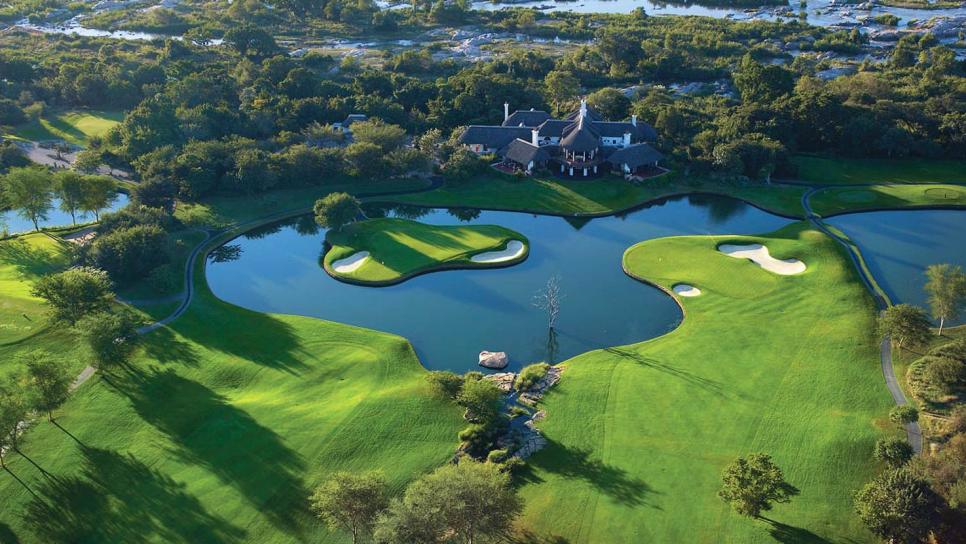
126 . BALTUSROL G.C. (Upper) | Springfield, N.J. / A.W. Tillinghast (1922) | 7,348 yards, par 72
It's believed that when A.W. Tillinghast began constructing the Upper and Lower Courses at Baltusrol in 1919 (replacing Baltusrol's existing 18 holes), it was the first contiguous 36 holes built at the same time in America. Because of the Lower's tremendous major championship record, most consider the slightly shorter Upper to be a secondary course at the club. But between the two, it was the Upper, not the Lower, that hosted the first U.S. Open (and third in the club's history) in 1936, won by Tony Manero. The Lower didn't get its first Open until 1954, won by Ed Furgol. Rees Jones, who also reworked The Lower, re-established Tillinghast features and bunkers on the Upper over a number of years, including a Tillinghast version of a par-3 Redan green.

127 . WINGED FOOT G.C. (East) | Mamaroneck, N.Y. | A.W. Tillinghast (1923) | 6,792 yards, par 72
Winged Foot's two-course complex is the product of A.W. Tillinghast's fertile imagination. Every characteristic of the more famous West Course also exists on the Winged Foot East (which, incredibly, was used as a parking lot during recent U.S. Opens). A few years back, architect Gil Hanse reestablished Tillinghast's bunkering and reclaimed the original sizes and shapes of the greens, bringing "corner-pocket" hole locations back into play. He will soon do a similar restoration to Winged Foot West.
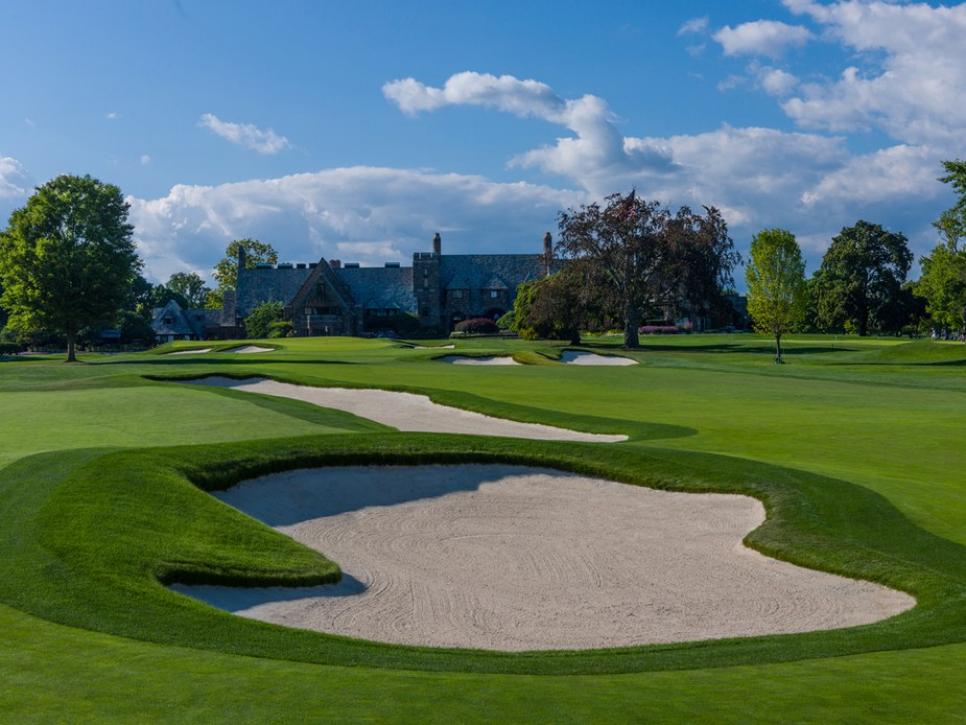
128 . WALTON HEATH G.C. (OLD) | Walton-on-the-Hill, England | 6,865 yards, par 72
Herbert Fowler's earliest design, done in 1904, is an out-and-back routing with rippling fairways, tight turf, cross bunkers, ground-hugging greens and fields of heather, all borrowed from coastal links. One writer has suggested Walton Heath ranks with Pine Valley as the best neophyte design in golf. It opens with a par-3, closes with five stern holes, including the par-5 16th, which is played as a long 4 for tournaments. Donald Steel altered holes and added length early in this century.
129 . CANYATA G.C. | Marshall, Ill. | Bob Lohmann & Mike Benkusky (2004) | 7,266 yards, par 72
Energy-industry CEO Jerry Forsythe grew up in east central Illinois and wanted to convert 300 acres of his childhood memories into a family retreat. After golf architect Bob Lohmann built him an elaborate three-hole golf course on the property, Lohmann's then-associate Mike Benkusky convinced Forsythe to stretch it to nine holes and later into a full 18. Ultimately, two million cubic yards of cornfield were moved to form Canyata's massive fairways and greens, which are edged by waterscaped ponds, artificial creeks and a dazzling array of bunkers. With only a handful of rounds played each year by invited guests, Canyata's manicuring is always nearly flawless.

130 . SOMERSET HILLS C.C. | Bernardsville, N.J. | A.W. Tillinghast (1918) | 6,756 yards, Par 71
Somerset Hills is another marvelous A.W. Tillinghast design, one of the few that has remained virtually unchanged since it opened in 1918. That may make it the most authentic Tillinghast course on the 100 Greatest. It's a charming, laid-back design that works through seemingly undisturbed rolling terrain, past rock outcroppings and around small-but-distinctive water hazards to some outrageous green contours guarded by knobby mounds dubbed dolomites. Like Baltusrol Upper, it has a rare Tillinghast version of a Redan par 3.
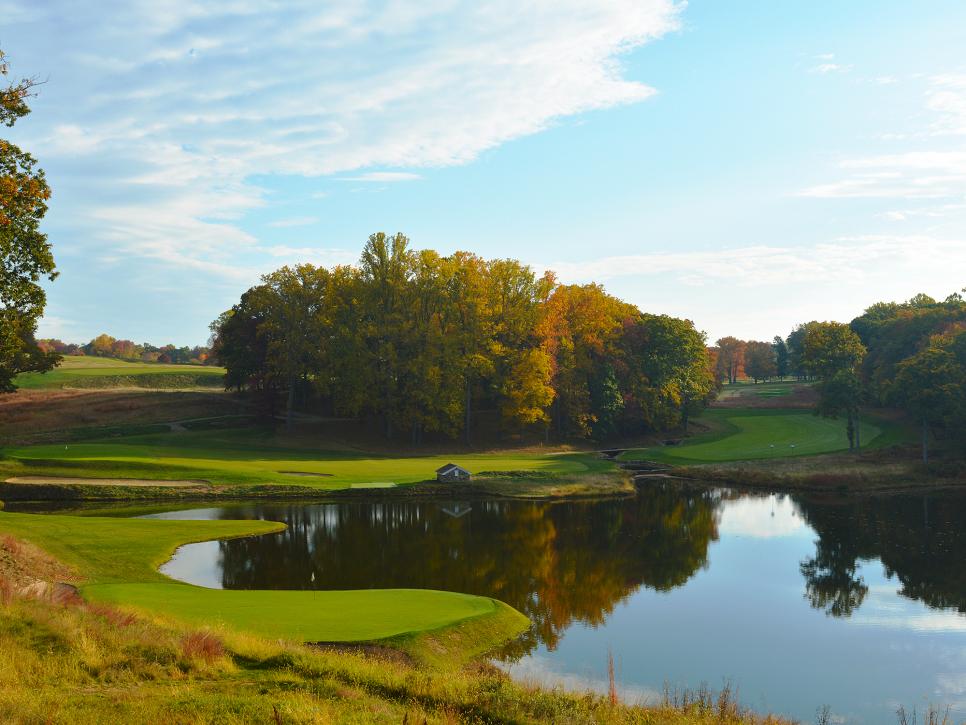
Courtesy of Somerset Hills CC
131 . MONTEREY PENINSULA C.C. (Shore) | Pebble Beach | Mike Strantz (2004) | 6,873 yards, par 72
Mike Strantz was battling cancer while transforming the bland, low-budget Shore Course into a scenic and strategic marvel that rivals next-door neighbor Cypress Point. Strantz reversed direction of the fifth through 15th holes to provide a Pacific Ocean backdrop to most of them. He weaved fairways among trees so players could "dance among the cypress," and added native grasses for a coastal prairie look. The stunning landscape would be Strantz's last work of art. He died six months after completing the redesign. Former PGA Tour player Forrest Fezler, who was Strantz's associate on the project, now serves as the club's consulting architect in order to retain the Strantz vision.

132 . SHOREACRES | Lake Bluff, Ill. | Seth Raynor (1921) | 6,521 yards, par 71
Perhaps the most fascinating topography upon which Seth Raynor created a golf course with his usual collection of suspects, including No. 3 (Leven), No. 6 (Biarritz), No. 7 (Double Plateau), No. 8 (Eden), No. 10 (Road) and No. 14 (Redan) all playing along plateaus and over ravines that feed into Lake Michigan. The stretch of 11, 12 and 13, playing across a ravine, down into it and back out of it, are as unique a stretch of holes as can be found anywhere on a 100 Greatest course.
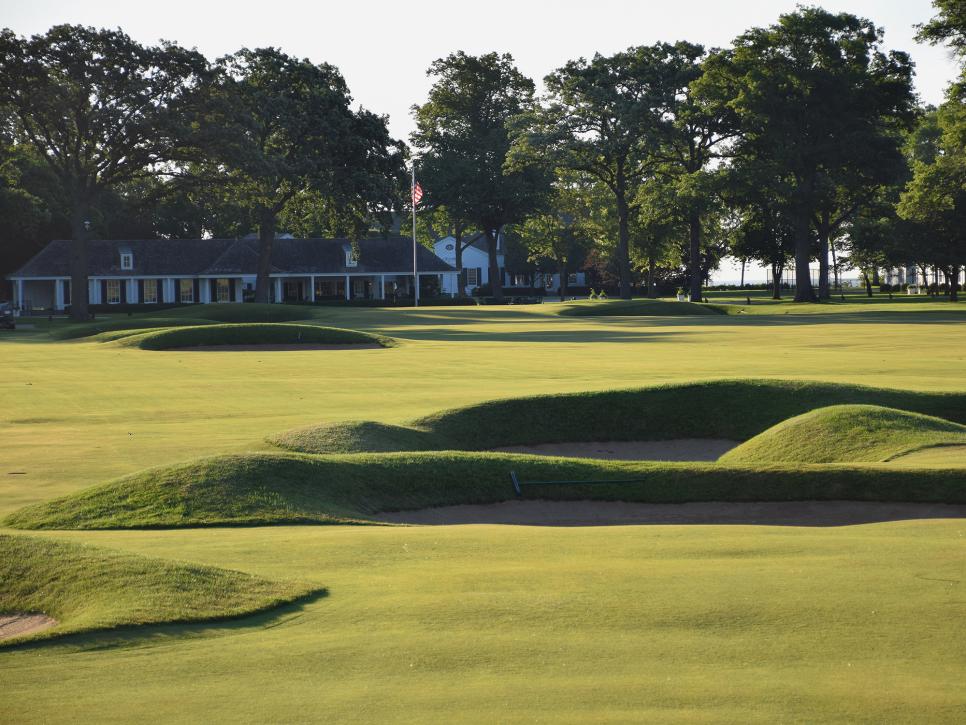
Brian Palmer/Courtesy of Shoreacres
133 . RYE G.C. (OLD) | Deal, England | 6,308 yards, par 68
A great myth is that Rye hasn't changed in a century. In truth, during World War II the Royal Army built pillboxes and buried fuel storage tanks on the existing course. Architect Guy Campbell reclaimed the course in 1946, using a bulldozer to create new holes. To play such seemingly natural holes as the par-3 seventh on Rye's rolling links today, you'd never suspect it. Rye has long been considered the toughest par-68 on earth. This ranking confirms that.
134 . KITTANSETT CLUB | Marion, Mass. | William Flynn & Frederic Hood (1922) | 6,811 yards, par 71
Only recently, with the discovery of some original blueprints, has it been conclusively established that the ocean-side, links-like Kittansett, long thought to be the product of an amateur architect, Frederic Hood, was actually the work of well-known course architect William Flynn, who also designed Shinnecock and Cherry Hills. Credit that revelation to authors Wayne S. Morrison and Thomas E. Paul, who reveal that and much more in their massive 2,260-page biography of Flynn entitled "The Nature Faker: William S. Flynn, Golf Architect." Credit Gil Hanse with restoring the bunkers without the aid of those Flynn plans. Instead, he used old aerial photographs.

LC Lambrecht/Courtesy of The Kittansett Club
135 . ARCADIA BLUFFS G.C. | Arcadia, Mich. | Rick Smith & Warren Henderson (2000) | 7,300 yards, par 72
Can a 100 Greatest course be a sleeper? Arcadia Bluffs has been overshadowed by Pacific Dunes, ever since it finished second to it in the Best New Upscale Public Course race of 2001. And likewise second-fiddle to Crystal Downs, a neighbor every northern Michigan that visitor wants to play, even though it's private and Arcadia is public. And even by Whistling Straits, the imitation links on the opposite side of Lake Michigan that Arcadia Bluffs resembles, although the sand dunes at Arcadia are natural, not manmade. Arcadia Bluffs will gain more exposure if a proposed second 18 designed by Dana Fry is built in the next few years.
T-136 . GANTON G.C. | Yorkshire, England | 6,998 yards, par 71
Not everyone has been enamored with Ganton, the great Harry Vardon's home club. Back in 1949, American Ryder Cupper Jimmy Demaret described the course, still recovering from WWII, as "a sort of Pennsylvania Turnpike with trees." It's matured greatly since then. Situated on a pocket of sand in an otherwise inland landscape of clay and rock, Ganton plays firm and fast with holes hemmed in by blooming gorse. Among the course's difficult hazards include more than 110 vertical-edged bunkers, many deep enough to require wooden steps. Bernard Darwin famously said golfers playing Ganton suffer either sandy or prickly disaster.
T-136 . OLGIATA G.C. (WEST) | Rome, Italy | 7,566 yards, par 71
The lone Italian entry on the World 100 Greatest is a classic inland layout originally designed in 1962 by Englishman C.K. Cotton. Seven years ago, American architect Jim Fazio (brother of Tom) lengthened the course, completely rebunkered it and added water hazards at strategic spots on five holes. Given its new chops, it's a bit surprising that the 2022 Ryder Cup—the first to be played in Italy—wasn't awarded to Olgiata. Instead it's going to Marco Simone Golf Club, another Jim Fazio design.
138 . CABO DEL SOL (OCEAN) | Los Cabos, Mexico | 7,091 yards, par 72
When Jack Nicklaus first saw this Baja Peninsula site, what can best be described as Scottsdale-meets-the-Sea of Cortez, his thought was: "This is my chance to design a Pebble Beach." He took full advantage of that chance, developing an exciting routing that plays from highlands of desert cacti over dry washes and down to the sea on both nines. When the layout opened in 1994, Nicklaus said it had the three finest finishing holes in golf. That might still be true 24 years later, given that the greens at 16, 17 and 18 are all perched atop rocks above the crashing surf of Whale Bay.
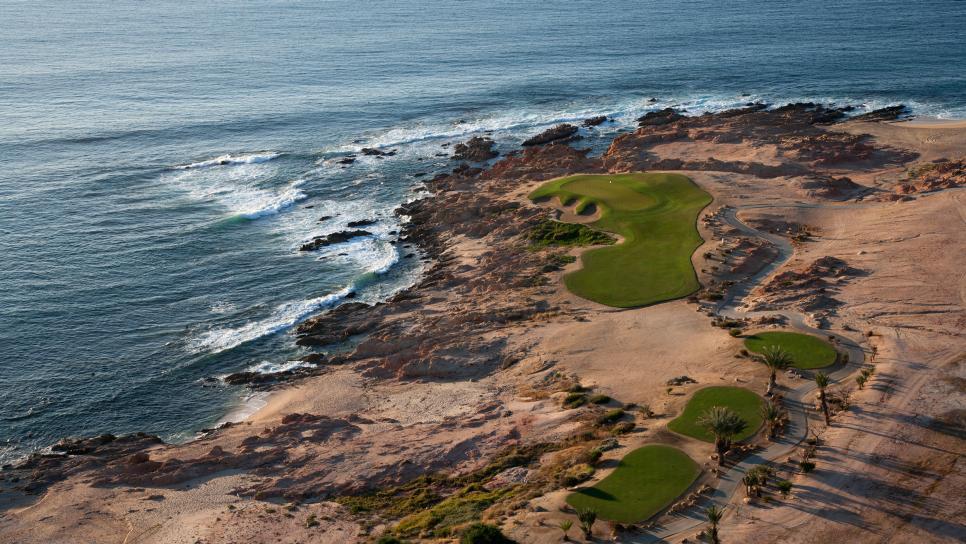
Photo by Stephen Szurlej
139 . SPRING HILL G.C. | Wayzata, Minn. | Tom Fazio (1999) | 7,042 yards, par 72
While Tom Fazio is best known for creating massive landscapes for his designs, Spring Hill required little manipulation of earth. Fazio utilized the existing rolling topography to form what is one of his most natural designs. Holes are isolated from one another by thick forests of evergreens and, in one section of the property, acres of maple trees, which provide a brilliant color display each fall. With several tight fairways, marshland along some edges, many uphill approach shots into elevated greens and subtle movements in the putting surfaces, Spring Hill is also one of Fazio's most challenging designs.
140 . ROYAL ABERDEEN G.C. (BALGOWNIE) | Scotland | 6,910 yards, par 71
One of the least known of Scotland's great links has been even more overshadowed in recent years by its new neighbor to the north, Trump International Golf Links Scotland. Royal Aberdeen's front nine runs north in dramatic dunesland along the shoreline, with the inward nine backtracking inland along softer terrain to the clubhouse. Though the final stretch might be a bit underwhelming visually, its holes are just as testing. The links saw a few touchups by Martin Hawtree prior to the 2011 Walker Cup, which mostly included the addition of bunkers and a new green on the 15th hole.

Photo by David Cannon/Getty Images
141 . BANDON TRAILS | Bandon, Ore. | Bill Coore & Ben Crenshaw (2005) | 6,759 yards, par 71
Bandon Trails is the lowest-ranked of the four Bandon courses on America's 100 Greatest, but that's no flaw. We've long considered it such a compelling layout that it needs no seascape to command one's attention. Bandon Trails starts and finishes in serious sand dunes (the 18th being recently remodeled by Coore) while the remainder rolls through Oregon forest. Bump-and-run is the name of the game but the structure of each hole requires thoughtful bumps and targeted runs. It's most controversial hole is the short par-4 14th with a thumb of a green personally fashioned by Crenshaw.

Stephen Szurlej
142 . MILWAUKEE C.C. | River Hills, Wis. | H.S. Colt & C.H. Alison (1929) | 7,097 yards, par 72
With much of the course hard against the Milwaukee River and several holes subject to flooding (the green of the 12th and the entire 13th are located across the river), one might think Milwaukee Country Club is a flat layout. But many of its holes are surprisingly hilly. Its classic design is still tree-lined, but one of the crucial improvements recently made by consulting architect Tom Doak and his associate Don Placek was to remove some trees to open up views of the river from many upland holes.
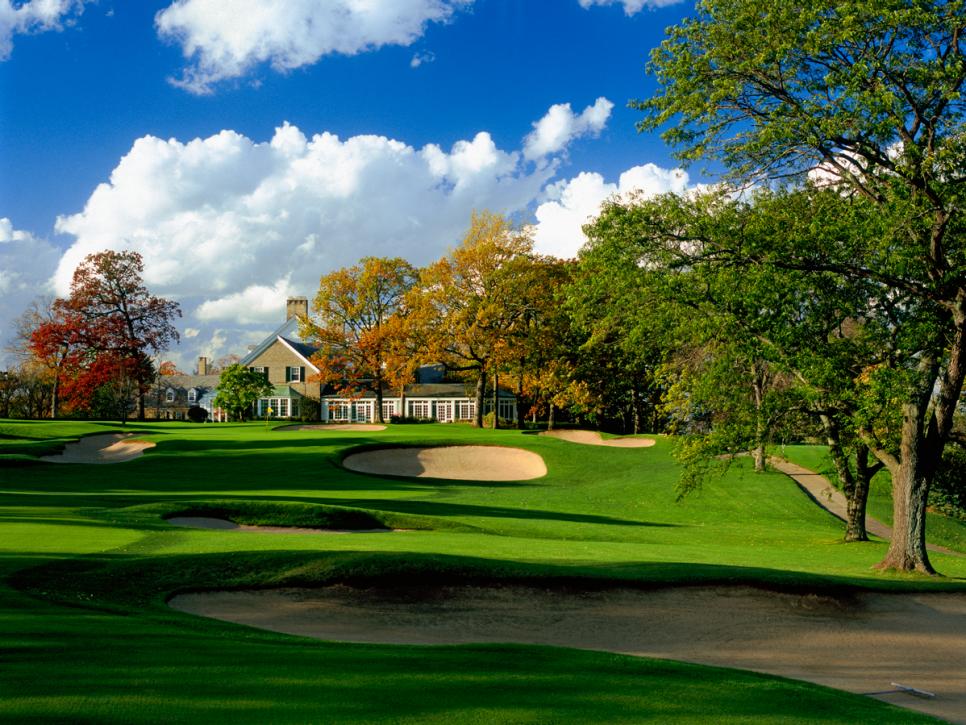
Courtesy of Paul Hundley
143 . ROYAL LIVERPOOL G.C. | Hoylake, England | 6,907 yards, par 72
Hoylake is a layout of stark contrasts—a series of splendid natural holes within coastal sand dunes (holes attributed to a 1930s H.S. Colt remodeling), with a less scenic start and finish inland on dead flat land. Still, the first hole, a stern dogleg-right around an internal out-of-bounds, is considered one of the most testing opening holes in links golf. A dozen years ago, this writer suggested that Royal Liverpool, which hadn't seen an Open since 1967, was past its prime as a championship venue. It has hosted two Opens since then, won in 2006 by Tiger Woods and in 2014 by Rory McIlroy. Hoylake will definitely remain on the Open rota.
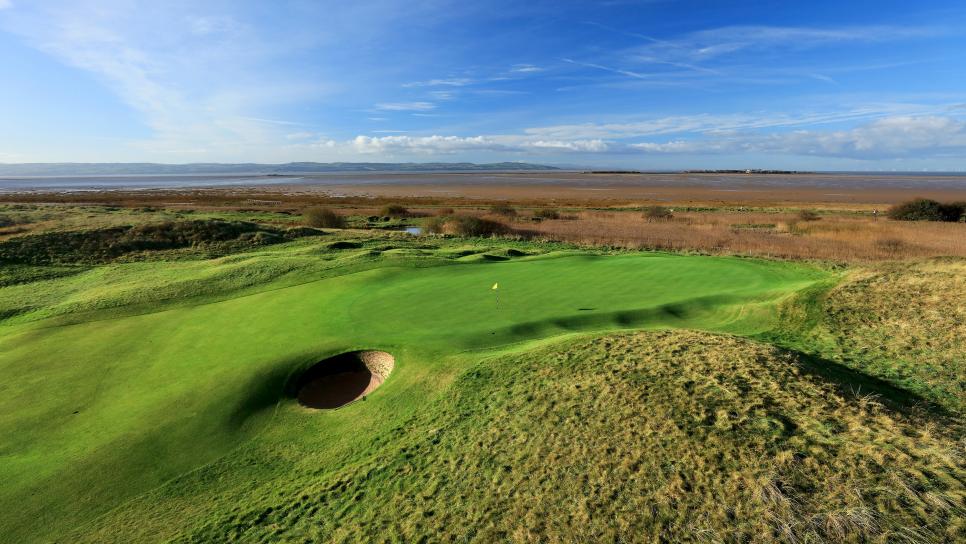
Photo by David Cannon/Getty Images
144 . MAIDSTONE CLUB | East Hampton, N.Y. | Willie Park Jr. & Jack Park (1924) | 6,665 yards, par 72
Not only one of America's earliest links courses, Maidstone is also one of the country's earliest golf residential communities. Legend has it that Bobby Jones insisted Maidstone's final three holes made it one of the great match-play courses in America. If so, that's because the 17th has one of the tightest green sites in America, the green sitting just in front of a major street intersection, with roads right and left less than 12 paces off each collar. As befitting a seaside course, Coore and Crenshaw have restored many sand dunes areas and removed turf in some spots of rough to expose the sand beneath.
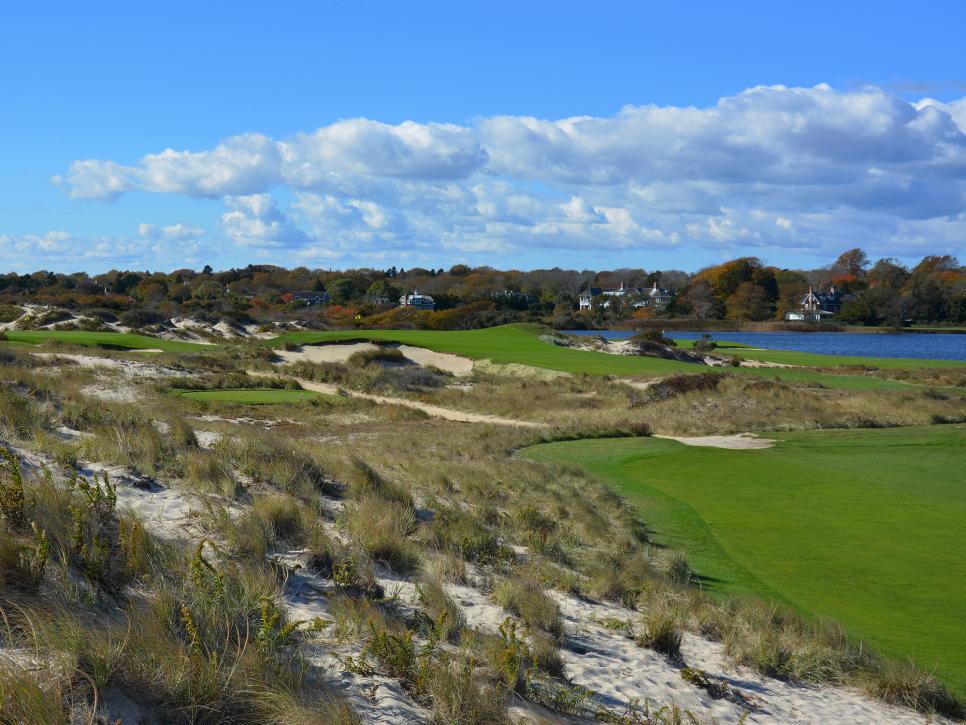
Courtesy of Maidstone Club
145 . SIAM C.C. (OLD) | Pattaya, Thailand | 7,162 yards, par 72
Originally designed by Japanese architect Ichisuke Izumi, Siam Country Club was just the country's second course when it opened in 1970. It was built on what was called the Pattaya desert, and Izumi concocted a special compost to turn sterile sand into soil in order to grow grass. Early on, Siam was known for its dramatically contoured greens and its gentle bunkering. In 2006, Americans Lee Schmidt and Brian Curley remodeled everything, changing parallel holes into curving fairways by adding ponds and relocating greens, while still preserving those legendary Siam undulating putting surfaces.
146 . LOCH LOMOND G.C. | Luss, Scotland | 7,100 yards, par 71
Jay Morrish and Tom Weiskopf were the first American architects to work in Scotland, not on the coast but west of Glasgow on the shore of Loch Lomond. The design is mostly the work of Weiskopf, who lived on site supervising construction while Morrish recovered from a heart attack at home. Opened in 1992, it's a graceful layout, the third, sixth, seventh and 18th holes touching the shoreline, others winding through inland hazards of oaks, sculptured bunkers, streams, marsh and a pond. There are a pair of reachable par 4s, the ninth and the 14th, the latter a favorite of Weiskopf's.

David Cannon
147 . KAWANA HOTEL G. CSE. (FUJI) | Shizuoka, Japan | 6,691 yards, par 72
C.H. Alison's 1936 design for Japan's first golf resort has long been dubbed the "Pebble Beach of Japan," but the layout is far more mountainous. That's evident from the opening hole, which drops down a tumbling fairway framed by twisted pines to a green with Sagami Bay as its backdrop. The sea also backdrops the steep downhill fourth, seventh, 10th, 11th, 14th and 15th holes. Unlike at Hirono (99th on this ranking), Alison's bunkering here is subdued.

Atsushi Tomura
148 . CHERRY HILLS C.C. | Cherry Hills Village, Colo. | William Flynn (1923) | 7,348 yards, par 72
When Cherry Hills opened in the early 1920s, it was a ground-breaking design, with the nation's first par-5 island green and closing back-to-back par 5s, although in championship play the 18th is played as a par 4. In the 1960 U.S. Open, winner Arnold Palmer popularized the idea of a drivable par 4 by going for the first green in every round. Curiously, when Palmer and partner Ed Seay remodeled Cherry Hills in 1976, they lengthened the first hole so no player could duplicate Arnie's feat. Nearly 40 years later, modern equipment has once again made the first hole reachable from the tee.

149 . THE ESTANCIA CLUB | Scottsdale | Tom Fazio (1995) | 7,314 yards, par 72
Our Best New Private Course of 1996 was Tom Fazio's initial entry into the Scottsdale scene. Positioned beneath the north slopes of Pinnacle Peak and routed to provide a variety of uphill and downhill shots and a change of direction on almost every hole, Estancia is an Easterner's version of rock-and-cactus architecture, with wide turf corridors, few desert carries and greens wilder than most. Former Fazio design associate Kevin Sutherland (no relation to the PGA Tour player of the same name) has made slight design adjustments in recent years.

150 . JACK'S POINT G. CSE. | Queenstown, New Zealand | 6,986 yards, par 72
John Darby, a New Zealand land planner and golf architect, routed Jack's Point from a valley clubhouse up onto a plateau and down again to offer sterling views of Lake Wakatipu and the mile-high Remarkables Mountains. Many have likened Jack's Point opening uphill holes to those of Gullane in Scotland. But Darius Oliver of Golf Digest Australia is less enamored, writing: "Darby decided to attack the hills and get his holes as quickly and as close to the [lake] edge as he possibly could. The result is at times an awkward mix of quite spectacular golf with some difficult uphill and downhill slogs." Our ranking would suggest Oliver's is the minority opinion.
151 . PARAPARAUMU BEACH G.C. | New Zealand | 6,603 yards, par 71
A rare authentic sand-based links in New Zealand, James Watt built the course on the Kapiti Coast north of Wellington in two sections, one nine in 1930, the other in 1937. New owners took charge in 1949 and decided to remodel it, hiring Alex Russell, the Australian champion golfer who turned to course design after working with Alister Mackenzie. Russell spent six weeks on the property, reshaping dunes and creating splashy bunkers. Two years later, he returned and altered bunker faces from sand to turf because heavy winds were constantly eroding the steep sand faces. The club has preserved a number of mature trees throughout to act as buffers against wind.
152 . CONGRESSIONAL C.C. (Blue) | Bethesda, Md. | Robert Trent Jones (1962) | 7,278 yards, par 72
Congressional is a Rees Jones redo of a course that was substantially his father's work, long criticized as featuring too many uphill shots. When Rees remodeled it he provided definition. Now golfers stand on a tee and see the entire hole, all the hazards, all the strategies and potential penalties. The greens are gentle enough for member play but can be mowed to 14 on a Stimpmeter for tournaments. Congressional once had a par-3 18th. Rees reversed its direction and made it into the long, strong par-3 10th. The old 17th with a dramatic peninsula green is now the permanent 18th.
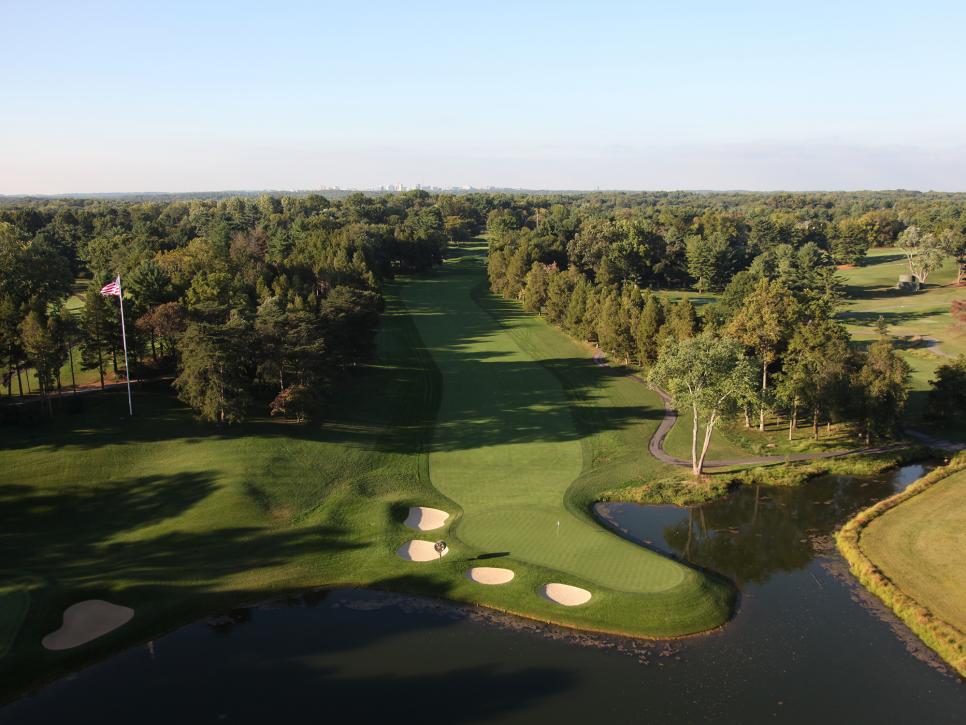
Stephen Szurlej
153 . QUAKER RIDGE G.C. | Scarsdale, N.Y. | A.W. Tillinghast (1918) | 7,008 yards, par 70
Quaker Ridge returned to America's 100 Greatest in 2013 thanks to a revision by Gil Hanse that included removal of many trees and the rebuilding of bunkers. Hanse also expanded several greens back to Tillinghast dimensions but reduced the size of the par-4 17th green, chopping off a left-hand lobe added by Frank Duane in 1964. Quaker's strong suit has long been its powerful par 4s and Hanse strengthened them all, including the par-4 sixth, squeezed between a creek and hillside, and the drive-and-pitch 11th, where the green is girdled by a stream.
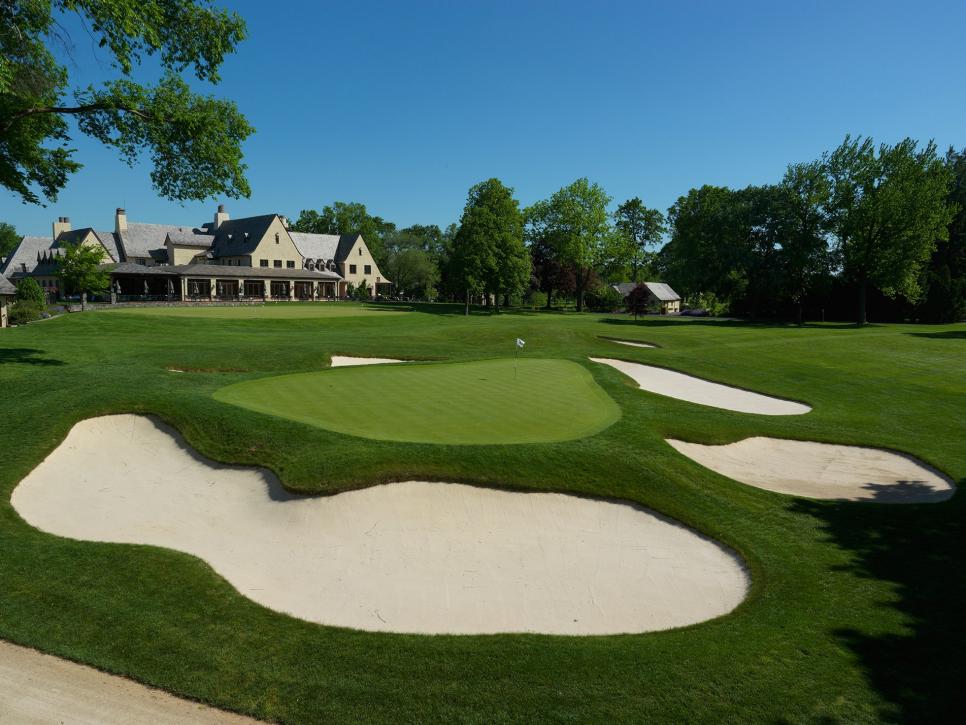
154 . PLAINFIELD C.C. | Edison, N.J. | Donald Ross (1921) | 7,091 yards, par 72
There are a number of lofty architectural names attached to Plainfield, but one name not often mentioned is that of club pro Marty O'Loughlin, who combined a par-4 and par-3 in 1930 to create the present, terrific par-5 12th and also carved holes 13, 14 and 15 from an adjoining forest, a three-hole stretch is still called "The Tunnel," despite the fact that many trees on its interior, as well as elsewhere on the property, have been cut down. Plainfield has hosted two PGA Tour events since 2010 and will host another, the Northern Trust Open, part of the FedEx Playoff Series, in 2020.

155 . TPC KUALA LUMPUR (WEST) | Malaysia | 6,987 yards, par 72
American architects Robin Nelson, Rodney Wright and Neil Haworth designed 36 holes, the West and East courses, for Kuala Lumpur G. & C.C. in 1991 in a tropical garden motif. Over a decade later, Sime Darby Properties obtained the course and arranged a TPC license with the PGA Tour and renamed the facility TPC Kuala Lumpur. Australian architects Ted Parslow and Jason Winter remodeled the West in 2008. Today, flanking bunkers squeeze nearly every par 4 and par 5, and traps front nearly every green, forcing aerial shots into them. Greens lacking bunkers are guarded by water hazards, like the elaborate faux bubbling brook pouring in front of the 17th green. Half the holes have water hazards. TPC Kuala Lumpur has been the site of CIMB Classic on PGA Tour.

156 . ARONIMINK G.C. | Newtown Square, Pa. | Donald Ross (1928) | 7,190 yards, par 70
Aronimink is an object lesson in architectural appreciation. After Donald Ross completed his design in 1928, he proclaimed, "I intended to make this my masterpiece." That didn't keep club members from bringing in William Gordon in the 1950s to eliminate out-of-play fairway bunkers and move other bunkers closer to greens. The course was later revamped by Dick Wilson, George Fazio and Robert Trent Jones. It took seven years for Ron Prichard, a designer specializing in course restoration, to rebuild the course to something close to the original Ross design. Architect Gil Hanse, who resides nearby, revamped the course ahead of the club hosting the 2018 BMW Championship.
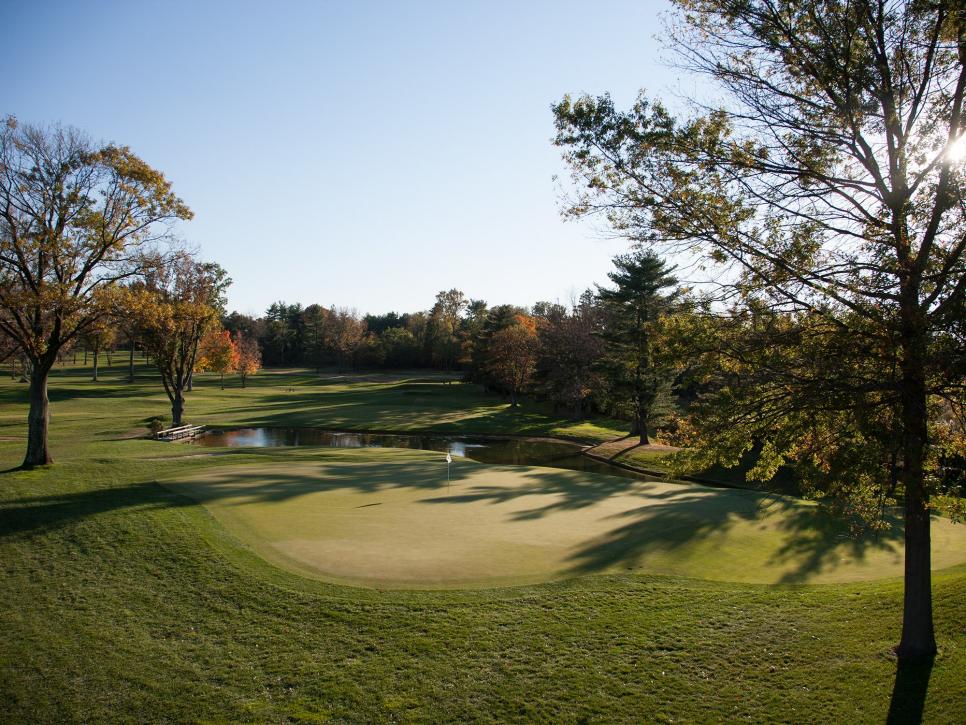
157 . OLYMPIA FIELDS C.C. (North) | Olympia Fields, Ill. | Willie Park Jr. (1922) | 7,190 yards, par 70
To prepare Olympia Fields North for the 1961 PGA Championship (won by Jerry Barber in a playoff over Don January), the club didn't hire a golf architect. Instead, superintendent Warren Bidwell relocated 32 greenside and 13 fairway bunkers and added new tees to lengthen the course by 320 yards. Forty years later, golf architect Mark Mungeam supervised extensive changes before the North hosted the 2003 U.S. Open and made more changes again before Olympia Fields North and newly remodeled South (redone by architect Steve Smyers) co-hosted the 2015 U.S. Amateur. In 2017, Olympia Fields North hosted the KPMG Women's PGA Championship.

158 . SENTOSA G.C. (SERAPONG) | Singapore | 7,420 yards, par 71
It took years to build the Serapong course back in the early 1980s. The site was a mangrove swamp filled with some three million cubic yards of sand dredged from Singapore Harbor. Designer Ron Fream, a globe-trotting American, routed as many holes as he could along the water's edge, resulting in the now-famed "Dragon's Tail," a loop of holes, four through six, with island fairways around a tidal basin. It was recently rebunkered by architect Gene Bates, whose then-associate Andrew Johnston is now the club's director of agronomy. Sentosa has one of the legendary backdrops in the game, the skyline of Singapore.

Getty Images
159 . WOODHALL SPA G.C. (HOTCHKIN) | Lincolnshire, England | 7,080 yards, par 73
This par-73 layout is named for obscure architect S.V. Hotchkin, who purchased the club in the early 1920s and remodeled the course, which consisted of a 1905 nine by Harry Vardon and a 1912 nine by H.S. Colt. Hotchkin tinkered with the lovely, ground-hugging heathland layout until his death in 1953, producing what some call the most ferocious bunkers in Great Britain. Some are hidden from view, others are steep and deep and some are ringed with heather. Recent work includes restoration by Tom Doak.
160 . THE VALLEY CLUB OF MONTECITO | Montecito, Calif. | Alister MacKenzie & Robert Hunter (1929) | 6,750 Yards, par 71
The Valley Club is routed like an hourglass, with a wide variety of holes, including the third, hard against a barranca, the downright mountainous 10th, the gorgeous canyon-carry 14th and broad, serpentine 15th. Fairways are generous but the slant of greens demand certain angles of approach. The restored MacKenzie bunkers resemble jigsaw pieces that, observed architect Jim Urbina, seem to fit one another, left and right. An added bonus is its location, in perhaps the best golfing weather in the nation.
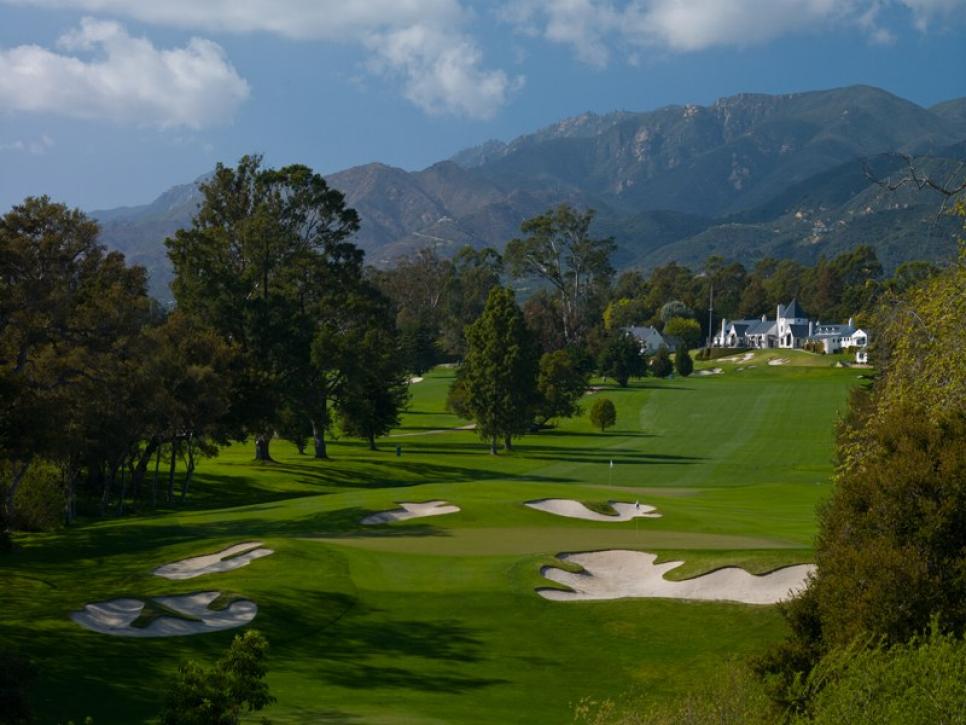
161 . VALHALLA G.C. | Louisville | Jack Nicklaus (1986) | 7,540 yards, par 72
Given a difficult piece of land on which to create Valhalla (half the site was floodplain, with high tension power poles), Jack Nicklaus drew on his training under both Pete Dye and Desmond Muirhead to produce a unique design, with an alternate fairway par 5, a par 4 with an island green and an 18th green shaped like a horseshoe. Valhalla has proven to be a great championship site. It has hosted three thrilling PGA Championships, the latest Rory McIlroy's win in 2014, as well as the 2008 Ryder Cup, a rare U.S. victory.

162 . ANYANG C.C. | Kunpo-shi, Kyonggi-Do, South Korea | 6,951 yards, par 72
Korea's oldest-ranked course was cut from thick tree cover in 1968 by Japanese golf architect Chohei Miyazawa, but it didn't become great until Robert Trent Jones Jr. remodeled the layout in 1996, reshaping greens, rebunkering holes and adding some strategic ponds, particularly on two par 3s, the fourth and 17th. The club's name was changed to Anyang Benest Country Club in 1996; it reverted to its original name in 2013.
163 . BOSTON G.C. | Hingham, Mass. | Gil Hanse (2004) | 7,062 yards, par 71
Boston Golf Club, in the south suburb of Hingham, is a modern-day Pine Valley, massaged by architect Gil Hanse and his team from dramatic coastal topography with gashes of unsullied sand. Fairways tumble across the landscape, posing some blind shots that are embraced, not criticized. One stretch surrounds an old strip mine, with mining spoils incorporated as chocolate drop mounds and one vein serving as a "Hell's Third Acre" hazard. Boston Golf Club, like No. 88 Garden City Golf Club, finishes with a grand par 3.
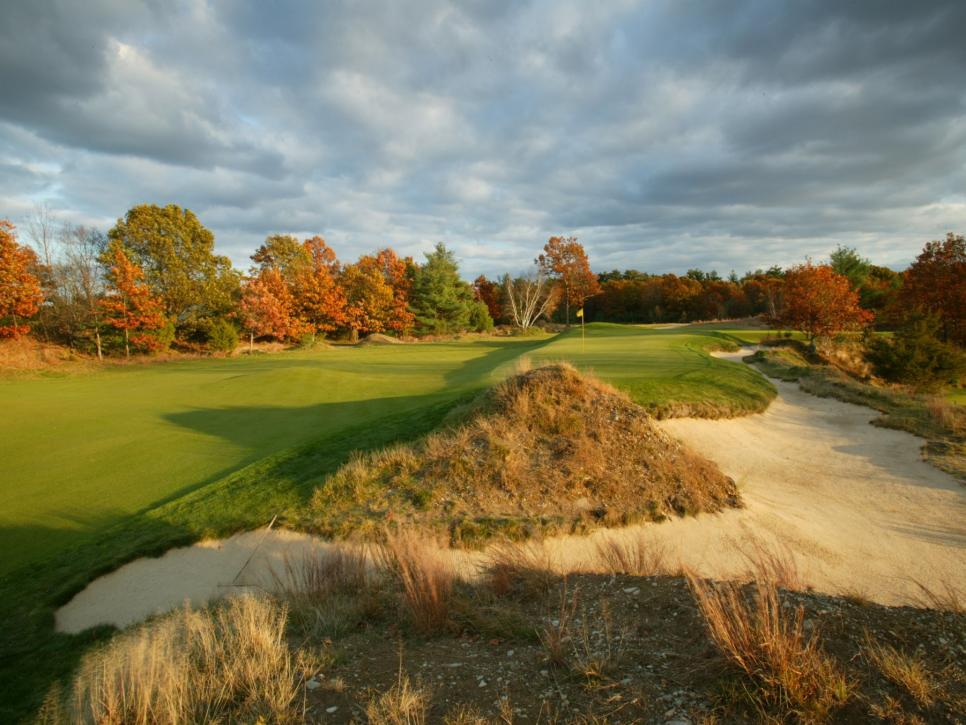
164 . JUMEIRAH G. ESTATES (EARTH) | Dubai, United Arab Emirates | 7,692 yards, par 72
This Greg Norman design is a bit of America transplanted in the Middle East. It's a residential development course with gorgeous white, graceful-though-deep bunkers that look suspiciously like those at Augusta National. A recirculating creek looks like it was appropriated from Muirfield Village. There's even an island green. Site of a World Tour event since 2010, Earth was the first of what was intended to be four full-blown courses at Jumeirah. Only the Norman-designed Fire Course has been completed. The remaining two, Wind and Water, have been shelved for now.

2015 Getty Images
165 . OLD HEAD OF KINSALE | County Cork, Ireland | 7,159 yards, par 72
In the 1980s, the golf potential of this 220-acre swollen thumb of land poking into the Atlantic had many course architects excited. The job went to American Ron Kirby, once a design partner of Gary Player and later a design associate of Jack Nicklaus. He consulted with Irish legends Paddy Merrigan, Eddie Hackett, Joe Carr and Liam Higgins. Kirby lived on the site for two years, determined to find an ideal routing that would maximize the rocky ocean cliffs that encircle the peninsula. It opened in 1996 with nine holes along ledges 300 feet above the surf. Kirby recently added another, relocating the par-3 13th to cling along an ocean slope.
166 . NARUO G.C. | Inagawa, Hyogo, Japan | 6,564 yards, par 70
The most mountainous of the Japanese courses ranked on our World 100 Greatest, Naruo reminds many Americans of courses found on the Monterey Peninsula, with hilly fairways slashed by gulleys that run to the sea lined by dense Monterey-like pines. Originally designed in 1920 by brothers Harry, Bert and Joseph Crane, it was rebunkered by C.H. Alison during his 1930s tour of the country. With that dramatic deep bunkering, Naruo looks both lovely and lethal. Only the flattish greens, many on hilltop locations, seem out of place.
167 . THE QUARRY AT LA QUINTA | La Quinta, Calif. | Tom Fazio (1994) |7,083 yards, par 72
The developers of The Quarry hired Tom Fazio in the early 1990s with instructions that he was to trump his design of Shadow Creek. Fazio was savvy enough to ignore those instructions, because he recognized The Quarry site was much better than what he had in Las Vegas. Thus The Quarry has more variety, starting and ending in the gravel quarry now lavishly landscaped. In between, holes play on high desert overlooking the Palm Springs Valley, with four holes tucked in an isolated notch of the Santa Rosa Mountains.

168 . ROYAL ADELAIDE G.C. | Seaton, South Australia, Australia | 6,557 yards, par 73
Herbert Rymill, chairman of the club's green committee, is credited with designing a new course for the club in sand dunes near Seaton in 1905. Within a year, Rymill collaborated an improvement plan with other members. It took until 1910 to implement his revisions, which included 90 bunkers, many of which were criticized by Alister MacKenzie when he inspected the course in 1926. Rymill offered to supervise any redesign MacKenzie proposed, but instead MacKenzie had his representative, Alex Russell, rebuild the bunkers into their now-famous MacKenzie style. Russell returned in 1951 and supervised more modifications. More recently, Australian Michael Clayton has remodeled several holes.
169 . ST. ANDREWS BEACH G. CSE. | Fingal, Victoria, Australia | 6,642 yards, par 70
This was the first project Tom Doak landed in Australia and his first collaboration with Mike Clayton as well. (They would also team to also create Barnbougle Dunes, No. 18 on this ranking.) Located just an hour south of Melbourne on the Mornington Peninsula, it's not quite in Australia's famed sandbelt, but close enough. The layout sits on mostly former pasture land, with some holes in sand dunes and others in groves of moonah trees. The course, which opened in 2004, is not as visually entertaining as others in Australia. Its character lies in its subtleties of bunkering and green contours surrounded by tightly mown turf. St. Andrews Beach is perhaps the most minimalist of any Doak design. Only four days were spent moving earth for fairways and greens, Doak says.
170 . THE G.C. AT BLACK ROCK | Coeur d’Alene, Idaho | Jim Engh (2003) | 7,130 yards, par 72
Jim Engh's architecture is all about turning fantasies into realities, and Black Rock delivers on that goal like few others, with some bobsled-run fairways where one can putt from landing area downhill to the green, rollicking putting surfaces framed by squiggly bunkers and a par-4 11th pinched by towering rock formations that bring to mind a pinball machine. Unusual and controversial (it won Best New Private in 2003 ahead of Friar's Head and Dallas National), Black Rock is a thrilling round of golf.
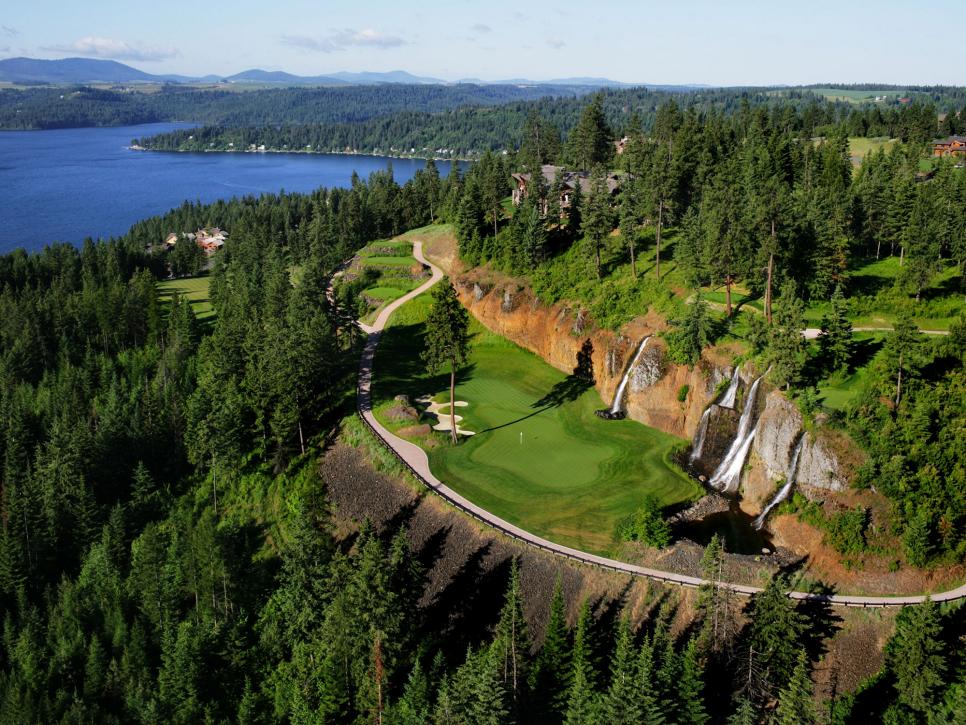
171 . HIGHLANDS LINKS | Ingonish Beach, Nova Scotia, Canada | 6,592 yards, par 72
On the opposite Nova Scotia coast from Cabot Cliffs (17th on this ranking) and Cabot Links (89th on this ranking) is the 80-year-old Highlands Links in Cape Breton, a sterling Stanley Thompson design routed to give golfers the full coastal experience, from ocean beach to river's side and deep forest. Thompson even shaped greenside mounds to mimic certain mountain ridges in the distance. A national park operation, Highlands had long been criticized for spotty maintenance, but after a 2010 flood, serious efforts, directed by Canadian golf architect Ian Andrew, were undertaken to restore its luster and improve its turf quality.
172 . HUDSON NATIONAL G.C. | Croton-on-Hudson, N.Y. | Tom Fazio (1996) | 7,121 yards, par 70
Hudson National rests on a dramatic bluffs high over the Hudson River Valley, a breathtaking location that, back in the 1920s, had been the site of the ill-fated Hessian Hills Country Club. (The fireplace and part of the foundation of its clubhouse still exists near the fourth green.) Fazio paid little attention to the old routing, however, dynamiting over 130,000 cubic feet of rock to fit his design into the rocky terrain. Greens are blazing fast, and the primary rough is wispy fescue.
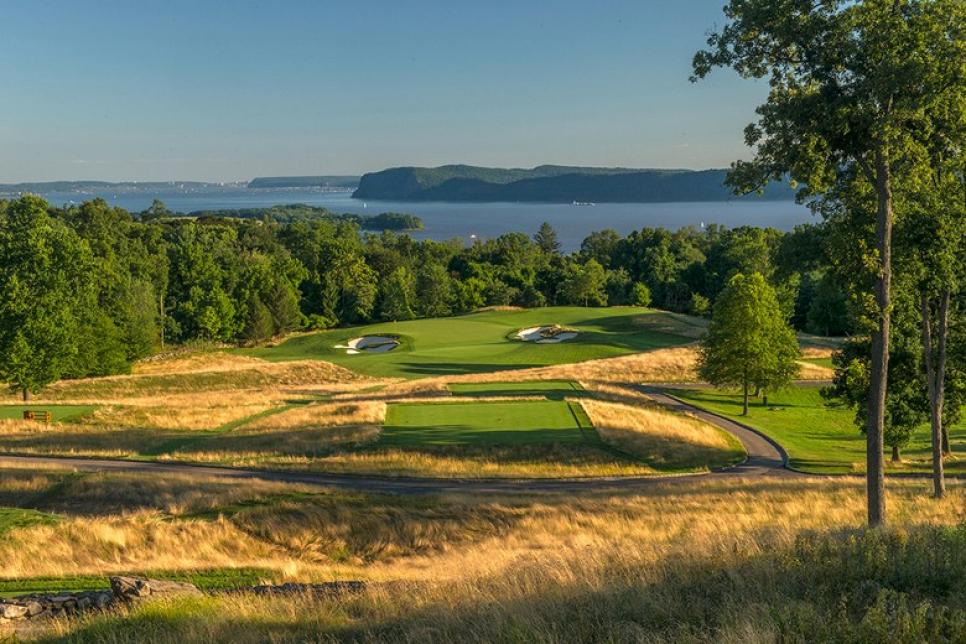
173 . SPRING CITY GOLF AND LAKE RESORT (LAKE) | Kunming, Yunnan Province, China | 7,204 yards, par 72
This Robert Trent Jones Jr. design on the shoreline of Yang Zong Hai Lake (as gorgeous as Lake Tahoe) opened a year after the club's Mountain Course, a Jack Nicklaus design. Holes on the Lake Course are benched along a tumbling slope leading down to the lake. The opening and closing holes sit at the highest location, and a spectacular trio lead down on the water's edge: the par-3 eighth, plunging 100 feet down to a peninsula green, the par-5 ninth with a lake hard against the right edge, and the par-3 10th, over a lake cove to a clifftop green.
.jpg.rend.hgtvcom.966.644.suffix/1573529379087.jpeg)
174 . DOUBLE EAGLE CLUB | Galena, Ohio | Jay Morrish & Tom Weiskopf (1992) | 7,175 yards, par 72
Built by reshaping flat farm fields into gentle hills and valleys, Double Eagle benefits from plenty of elbow room. Some holes have double fairways that pose genuine alternate routes. Greens are benign enough in contours to allow them to be kept lightning fast. A delightfully thoughtful design, it closes with two great water-laden, risk-rewarding holes. The club name does not symbolize a golf term. Original owner John McConnell was a fortune hunter, and the Double Eagle was a rare doubloon discovered in a sunken treasure.
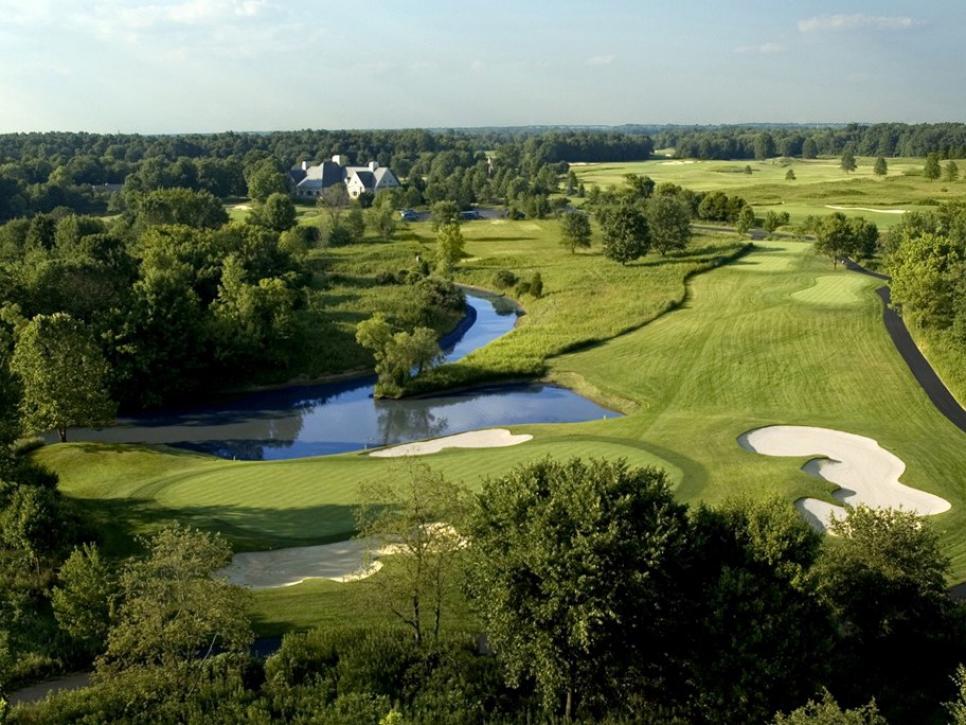
175 . YEAMANS HALL CLUB | Charleston, S.C. | Seth Raynor & Charles Banks (1926) | 6,808 yards, par 70
Though it contained a classic collection of Raynor favorites, including a Road Hole, a Biarritz, a Redan and even a Prize Dogleg based on an entry from a 1914 magazine design contest, Yeamans Hall suffered from benign neglect for 50 years, with bunkers overgrown and greens both shrunk by mowing habits and mushroomed by topdressing. But in the later 1980s, the course superintendent discovered Raynor's original plans in the clubhouse attic. Architect Tom Doak and his then-associate Jim Urbina used the plans to faithfully restore Raynor features. Urbina continues to implement restoration touches.
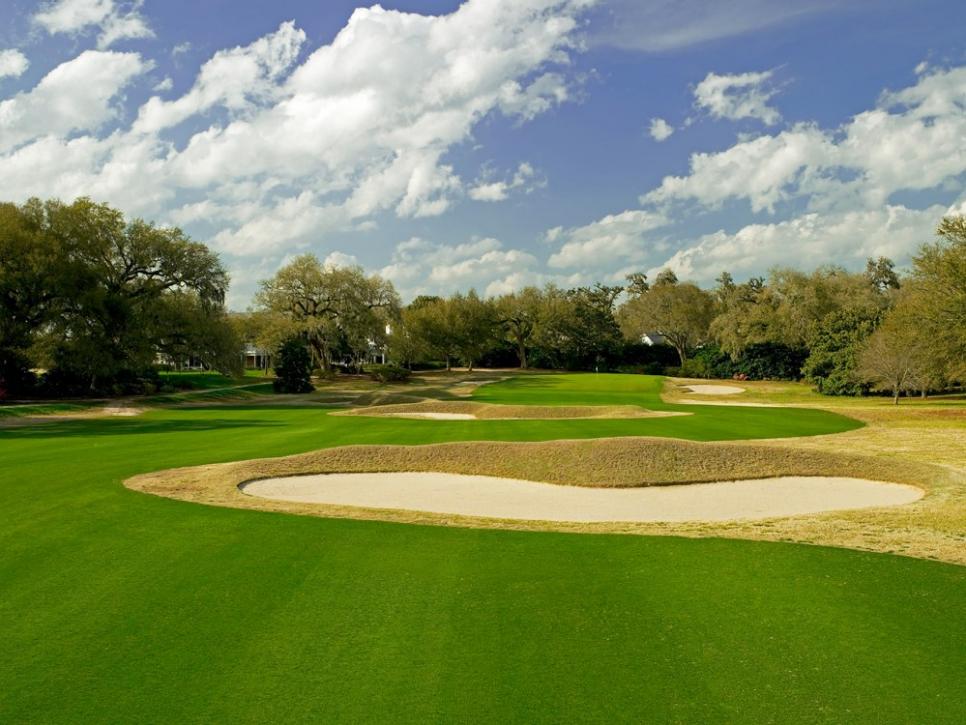
176 . FAIRMONT JASPER PARK LODGE G.C. | Jasper, Alberta, Canada | 6,663 yards, par 71
Jasper Park actually lies farther north than Stanley Thompson's other Alberta masterpiece, Banff Springs, and is a perfect complement to it. The routing has holes lined up with every prominent mountain peak in the distance. Thompson's typical sprawling bunkers are everywhere, some staggered diagonally across lines of play, others on the margins of a hole, poking out from beneath tree lines. Built in 1925 by the hand labor of some 200 men, holes are carved through fir, aspen and silver birch trees, and rocks were piled and covered with earth to create greens like the one on the short par-3 15th, a shot so precarious it's like hitting to the back of a slumbering sea lion.
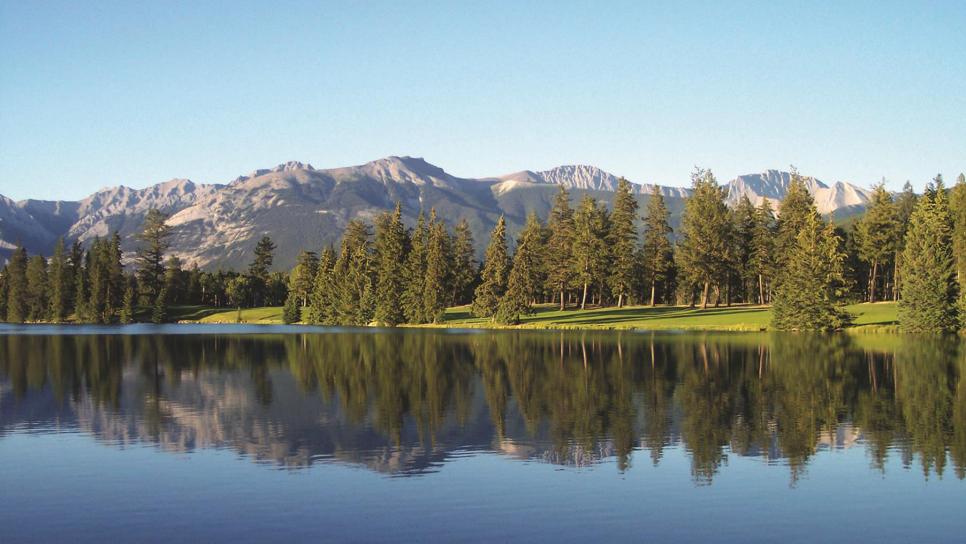
Courtesy of Fairmont Hotels & Resorts
177 . KASUMIGASEKI C.C. (EAST) | Kashata Kawagoe, Saitama, Japan | 7,466 yards, par 71
Kinya Fujita, Japan's pioneer course architect, founded Kasumigaseki in the late 1920s. He'd taken up golf in 1912 while studying at the University of Chicago, became fascinated with course architecture and traveled to Great Britain to learn design techniques from C.H. Alison of the famous firm of Colt and Alison. Fujita died at Kasumigaseki in 1969 at age 80. He was in the midst of planning improvements to the East Course at the time of his death to make it a true championship venue. Nearly 50 years later, Tokyo's bid to host the 2020 Olympics was accepted, with Kasumigaseki assigned as host of the golf events. The club retained Tom Fazio's design company to upgrade the championship East Course.
178 . RICH HARVEST LINKS | Sugar Grove, Ill. | Jerry Rich & Greg Martin (1999) | 7,715 yards, par 72
It began as a six-hole backyard course for computer billionaire Jerry Rich, then expanded into a nine-fairway, 11-green layout that could be played multiple ways, finally evolved into a conventional 18-hole layout strong enough to host the 2009 Solheim Cup. With its polish and landscaping, some call Rich Harvest Links the "Augusta of the Midwest," but even Augusta National doesn't have Rich Harvest's flexibility, where every hole can play differently every day, some even from different angles and par.
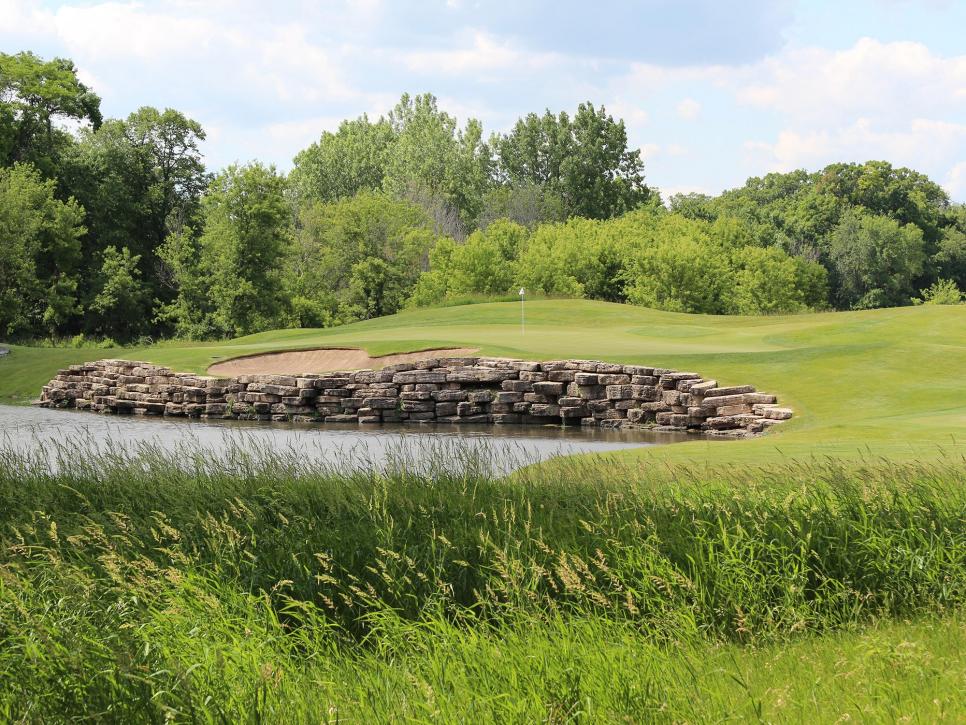
179 . INVERNESS CLUB | Toledo, Ohio | Donald Ross (1919) | 7,323 yards, par 71
Inverness is considered a classic Donald Ross design. In truth, it's one of his best remodeling jobs. Some Ross fans were outraged when the course was radically altered by George and Tom Fazio in preparation for the 1979 U.S. Open. The uncle-nephew duo eliminated four holes (including the famous dogleg par-4 seventh), combined two holes to make the par-5 eighth, and created two modern holes on newly-acquired land. Recently Arthur Hills associate Shawn Smith, after examining old Ross plans, widened several fairway corridors to bring fairway bunkers back into play. Now efforts to reshape features on the Fazio holes to better resemble the Ross style and philosophy are under consideration.

180 . CLUB PUNTA MITA, PUNTA MITA | Riviera Nayarit, Mexico | 7,014 yards, par 72
The Jack Nicklaus-designed Four Seasons Punta Mita is best known for a single hole, the optional par-3 third hole that plays from a tee on a Pacific Ocean beach to a green that sits on a natural rock outcropping some 180 yards offshore. It's a thrilling shot, like hitting to the Tail of a Whale (which is the hole's name), but the green is only used when the tide is low and the green is accessible by a low walkway. The other par 3 is terrific, too, just 13 yards shorter, with the green positioned above the beach and guarded on the right by a stream that pours into the sea. The 17th and 18th are also on the coast, with the 18th green sitting on a promontory with a literal beach bunker on its flank.
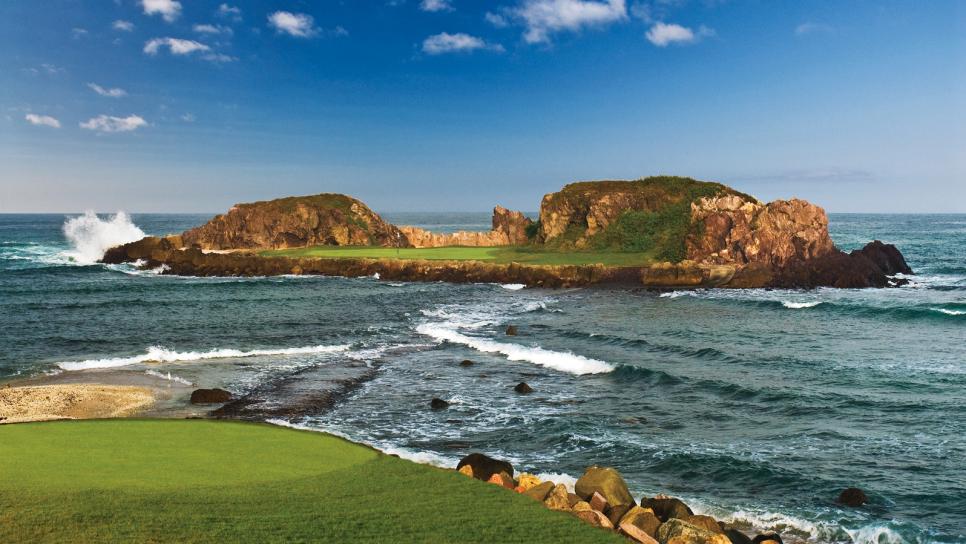
181 . THE EUROPEAN CLUB | Brittas Bay, County Wicklow, Ireland | 7,377 yards, par 71
One of the newest courses to be built on genuine Irish linksland, The European Club is the lifetime accomplishment of Pat Ruddy, a golf writer from the 1960s and a golf architect from 1975 onward. He mortgaged his home to buy the land and spent five years designing and building it. It opened in 1992 and is still a family business today. Hard against the Irish Sea's Arklow Bay, European Club rolls across untamed landscape with pot bunkers lined in railroad ties and two extra par-3 holes. It's not always linkslike: The routing has returning nines, a marsh off the seventh tee, a pond in front of the 18th green and not a single blind shot anywhere. Ruddy says he was once offered to sell it for 22 million pounds and passed. That makes the Irish design priceless.

David Cannon
182 . QUIVIRA G.C. | Cabo San Lucas, Baja Sur, Mexico | 7,139 yards, par 72
To see photos of Quivira's cliffhanging fifth and sixth greens, one would expect this to be a mountainous golf course. But a majority of its holes are on Pacific coastline sand dunes close to sea level or along the flank of a high desert plateau dotted with torote and cardon trees. Still, what earns the attention here is the par-4 fifth, its tee at 278 feet above sea level and its green at the far end of a ribbon fairway 107 feet below. Designer Jack Nicklaus calls this location, "one of the great pieces of property in the world," and he can be forgiven for requiring long cart rides between several holes. Such is the price to link together 18 truly sterling golf holes.
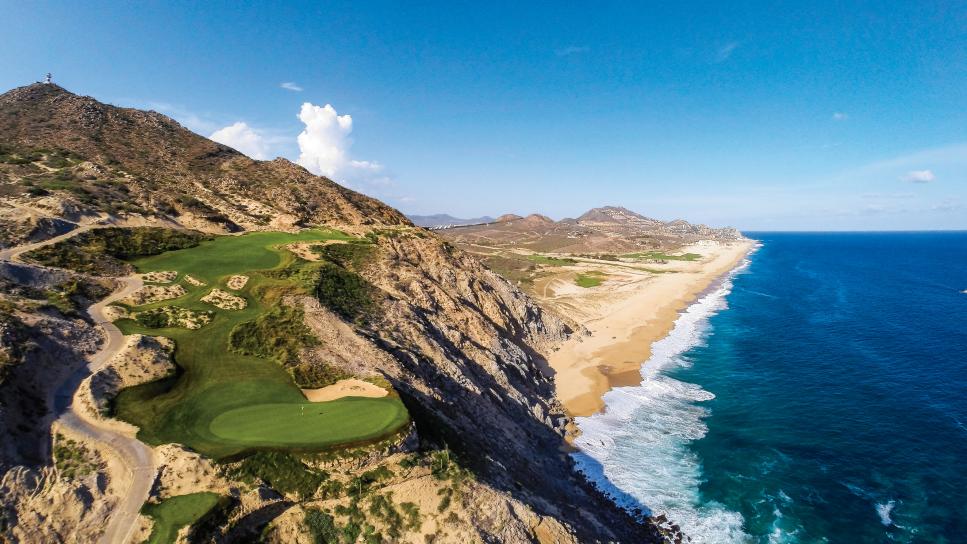
Courtesy of Quivira GC
183 . DIAMOND CREEK G.C. | Banner Elk, N.C. | Tom Fazio (2003) | 7,175 yards, par 70
While architecture purists scoff at the notion of waterfalls on golf courses, there is something magnificent about a cascading water feature done right. Few are as effective than the one behind the par-3 17th green at Diamond Creek. Tom Fazio positioned the green nearly at the base of a sheer granite quarry wall, down which a slender falls drops over 100 feet. Amazingly, the club entrance drive is also at the base of the quarry wall, hidden from view on the 17th as effectively as any Fazio cart path.
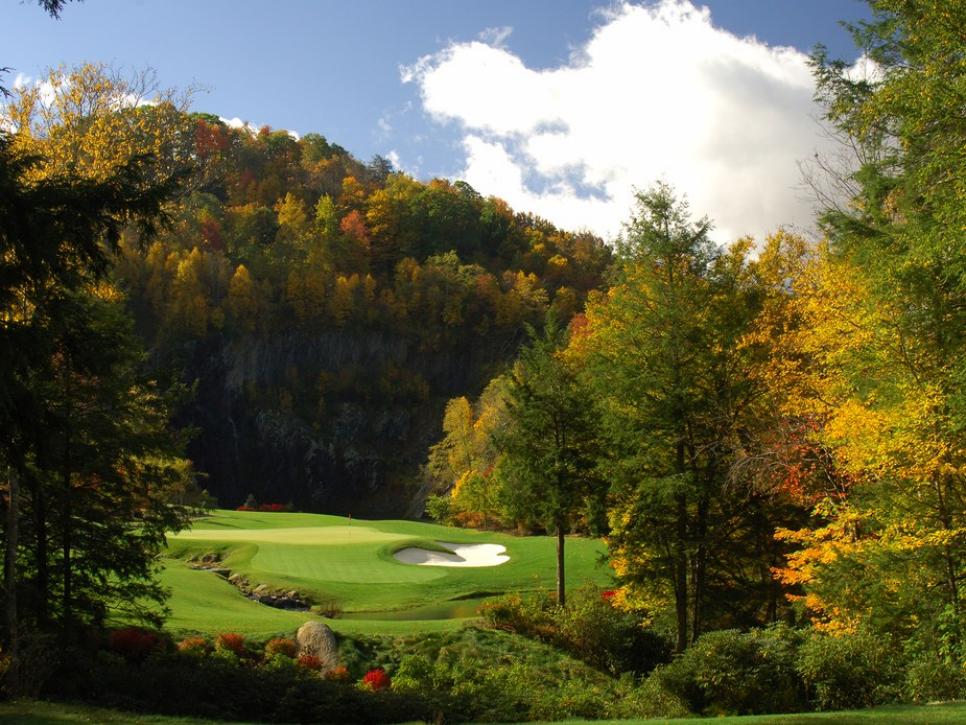
184 . ESSEX COUNTY CLUB | Manchester, Mass. | Donald Ross (1917) | 6,503 yards, par 70
Essex County Club is considered one of Donald Ross's earliest and most intriguing designs. He wasn't the original architect, but he served as its professional from 1909 until 1913 (when his design business became so lucrative he no longer needed the pro job) and lived on site, so he was able to tweak many holes, ultimately doing a substantial remodeling in 1917. Quirky holes are the order of the day, from the flat opening nine with fuzzy chocolate drops covered in tall fescue grasses to the blind shots, both uphill and downhill, on the back nine. The par-3 11th, with its green on a pedestal, and the downhill par-4 18th, shaped like an S around small hills, are special. Club insists its third green, created in 1893 and preserved by Ross in his remodel, is the oldest green in continuous existence in America.
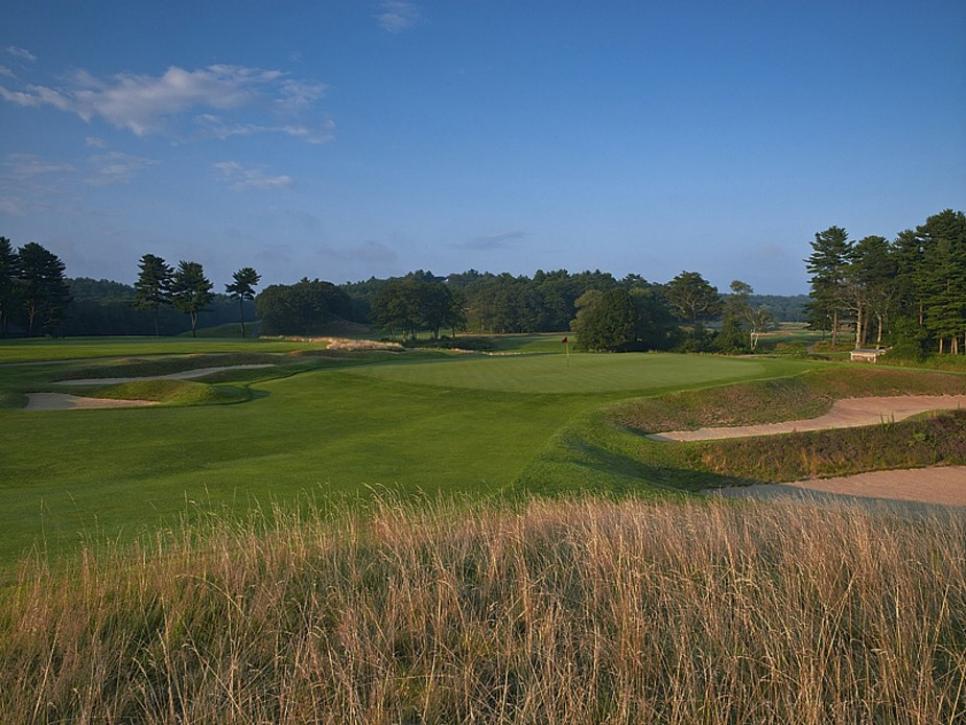
185 . BRG DA NANG G.C. | Da Nang, Vietnam | 7,160 yards, par 72
Built just down the East China Sea coastline from China Beach, where U.S. combat troops first landed in early 1965, Danang is the first design in Vietnam for Greg Norman and is perhaps one of his most minimalist. It's a tropical links, with a sandy base providing firm and fast turf, some bold dunes framing several holes, greens edged by closely mowed banks, and shallow bunkers with ragged edges. The showcase hole is the par-3 16th, which plays toward the sea, the Cham Islands in the distance behind the green. Between that green and the 17th tee is an old French pillbox of stacked stone, another reminder of Vietnam's now-distant military struggles.
186 . PRESTWICK G.C. | Ayrshire, Scotland | 6,908 yards, par 71
We should rejoice in the fact that the World 100 Greatest has room for at least one museum piece of golf architecture—an authentic relic from a time when golfers played cross-country without benefit of crisply mown turf and inviting targets. The third hole demands a forced carry over notorious Cardinal bunker. There's a blind tee shot over a ridge dubbed the Himalayas into par-3 fifth green, a blind approach shot down an escarpment to the 15th green and another blind approach over dunes known as The Alps to reach green on the par-4 17th. Prestwick hosted 24 Open Championships but none since 1925. That doesn't matter. It's an anachronistic design worth preserving.

David Cannon
187 . DURBAN C.C. | KwaZulu-Natal, South Africa | 6,733 yards, par 72
Dating from 1922, Durban Country Club is South Africa's most authentic links layout, despite the fact the many of its dunes, deposited by the nearby Umgeni River, are covered in dense brush and mature trees. Designed by George Waterman and Lawrence Waters, it's always been a formidable tournament site despite its relatively short length, because its undulating fairways offer few flat lies and crosswinds seem constant from the nearby Indian Ocean. In the tradition of the Old Course at St. Andrews, Durban's 18th is a reachable par 4, just 275 yards, with a big knob on left obscuring much view of the green.
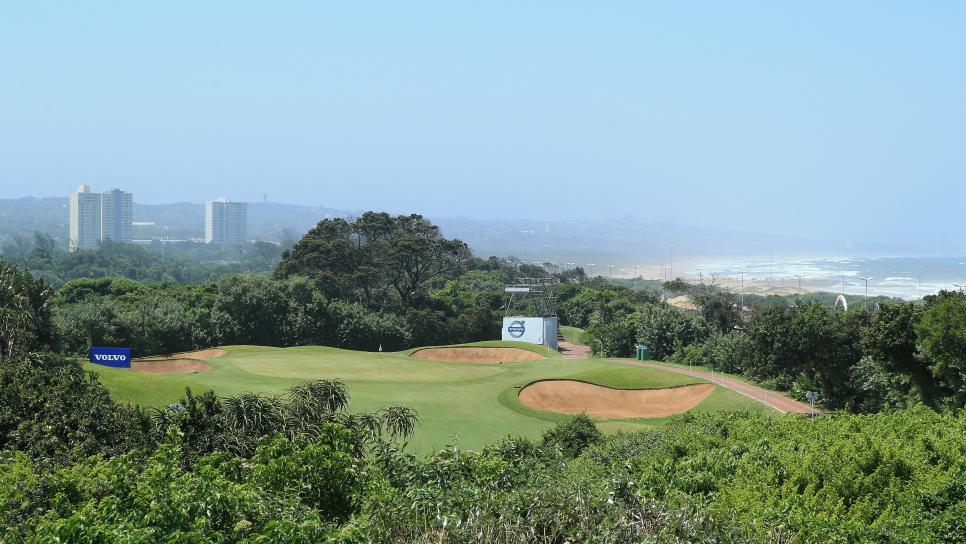
Richard Heathcote
188 . QUERENCIA C.C. | Los Cabos, Baja Sur, Mexico | 7,050 yards, par 72
Located several miles up the road from Cabo del Sol (138th on this ranking), this Tom Fazio design opened in 2000. The routing wanders the rugged high desert plateau on the outward nine, toward the Sea of Cortez, hopscotching a dramatic canyon on the par-3 eighth. After reaching the far point on the par-5 ninth, the course turns for home over similar terrain, via two more outstanding par 3s, the 11th and 14th. Other holes have humpbacked fairway and greens tucked beneath huge rock outcroppings. The one discordant note are royal palms planted in many desert spots near greens. They seem too artificial among native desert plants.

189 . BLACKWOLF RUN (River) | Kohler, Wis. | Pete Dye (1990) | 7,404 yards, par 72
Only Pete Dye could have convinced owner Herb Kohler to rip apart an award-winning course and still come out a winner. Dye coupled the front nine of America's Best New Public Course of 1988 (now holes 1-4 and 14-18) with nine newer holes built within a vast bend of the Sheboygan River to produce the River Course. It possesses some of Dye's most exciting holes, from the triple-option reachable par-4 ninth to the boomerang-shaped par-5 11th to the monster par-4 18th, where Kohler surprised Dye by converting a long waste bunker into a temporary lagoon for tournament events. For major events, like the 2012 U.S. Women's Open, Dye's original 18 was used. But for survey purposes, Golf Digest evaluates the River 18 available for general play.
190 . THE NATIONAL G.C. (MOONAH) | Cape Schanck, Victoria, Australia | 7,192 yards, par 72
Nothing on this Greg Norman design looks manufactured or contrived. Fairways emerge from the rolling topography, greens are positioned at grade and the gnarly bunkering is recessed into the earth, never propped above it. Some tees are positioned atop hills posing carries over gulleys, but bounce and roll in the game here. With generous targets surrounded by vast, dry, domed hills, the Moonah Course seems eerily like one in the African Veldt. One would not be surprised to see a giraffe lope by one of the squat, umbrella-like moonah trees that are scattered along hillsides.
191 . BANFF SPRINGS G. CSE. (STANLEY THOMPSON) | Banff, Alberta, Canada | 6,938 yards, par 71
Where Old Head in Ireland plays along the top of escarpments, Banff in the Canadian Rockies of Alberta lies beneath escarpments, with near-vertical cliffs of Mount Rundle towering 3,000 feet over almost every fairway. The course, another masterful design by Canadian Stanley Thompson, is tucked into the narrow Y-shaped valley formed by the Bow and Spray Rivers. Bunkering at Banff may be the best of Thompson's career. There are 150 of them, often in circular clusters, with ebbs and flows in their shapes that mirror mountain peaks.
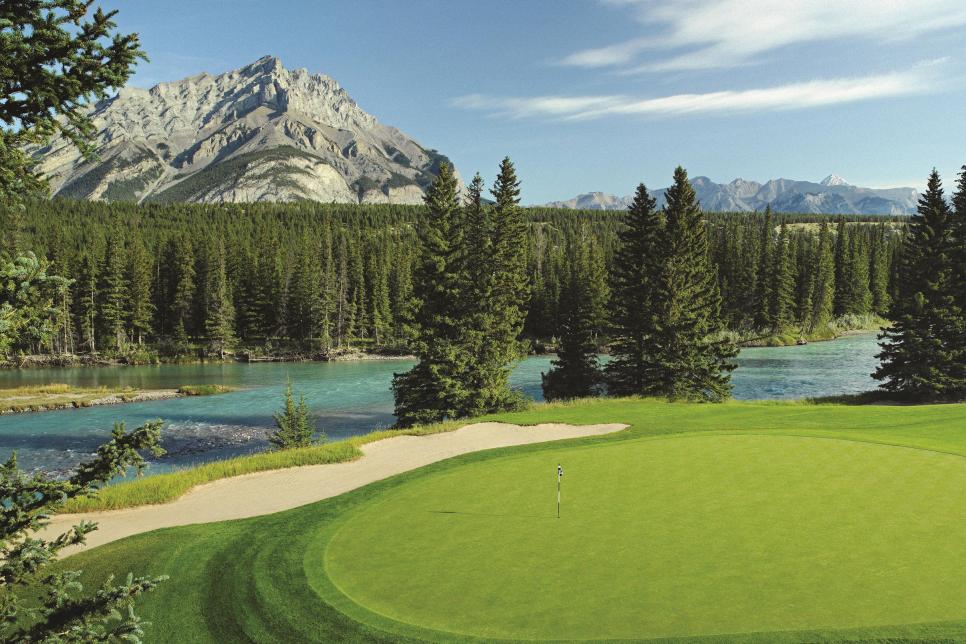
Courtesy: Fairmont Hotels & Resorts
192 . WESTERN GAILES G.C. | Irvine, Ayrshire, Scotland | 7,014 yards, par 71
The last to make the list is perhaps the least-known grand old Scottish links. Western Gailes is located north of Royal Troon, just off the Firth of Clyde, squeezed on the east by active railroad tracks, and thus its north-south routing over and between rolling sand dunes seems far tighter than its neighbors. Holes one through four, all par 4s, head north, then five through 13 march due south along the beach, with fairways mostly aimed southeast or southwest. The closing five play due north and sport some of the most intense bunkering on the 18. The club insists Fred Morris, its first greenkeeper laid out the course, but we say Willie Fernie, who also did Troon, did it.

David Cannon
193 . THE PRESERVE G.C. | Carmel, Calif. | Tom Fazio, J. Michael Poellot & Sandy Tatum (2000) | 7,067 yards, par 72
Located a few miles inland from the glorious foursome of 100 Greatest courses on California's Monterey Peninsula (Pebble Beach, Cypress Point, Spyglass Hill and the Shore Course at Monterey Peninsula CC), The Preserve is dramatically different, the only golf course within a 20,000-acre parcel of gentle hills and mammoth oaks. Fazio moved almost no earth here, so perfect was the routing established by Poellot and Tatum. The greens are subtle, the bunkering low key, the atmosphere one of constant tranquility.
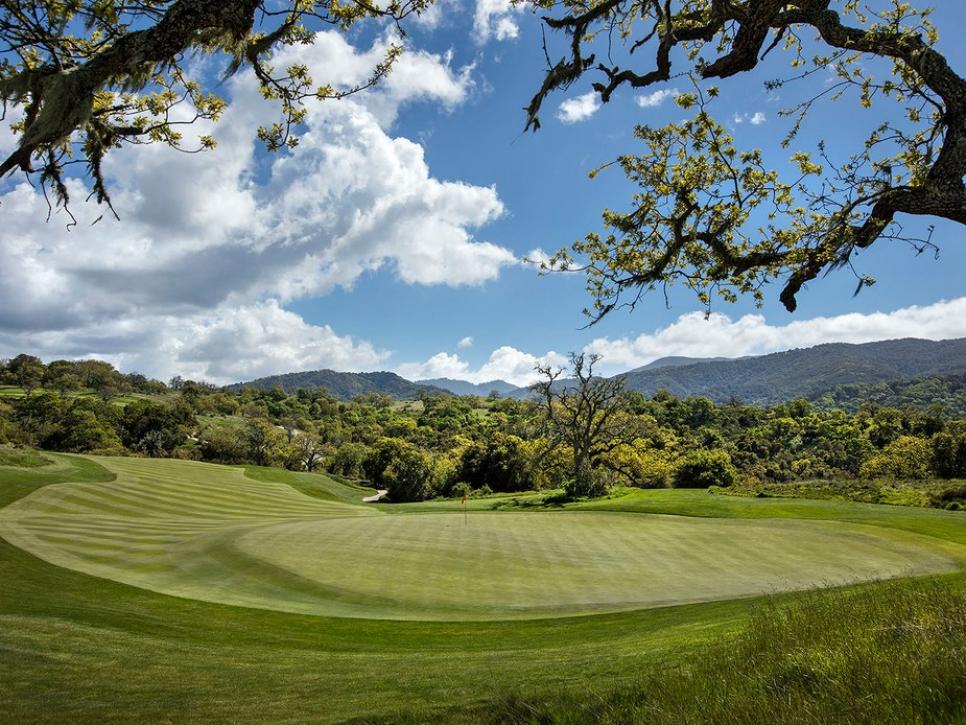
194 . CROOKED STICK G.C. | Carmel, Ind. | Pete Dye (1967) | 7,516 yards, par 72
Pete Dye insists he designed Crooked Stick in two stages. The back nine, finished first, was his ode to Alister Mackenzie, with a couple of boomerang greens like those he'd played on the Mackenzie-designed University of Michigan Golf Course. The front nine, completed two years later, was his tribute to Donald Ross, with pedestal putting surfaces and deceptive bunkers well short of some greens. To both he added wooden bulkheads of railroad ties and telephone poles. Crooked Stick was the first Dye course to host a major championship, the 1991 PGA Championship. It also held the 1993 U.S. Women's Open, the 2005 Solheim Cup, the 2007 U.S. Women's Amateur, the 2009 U.S. Senior Open and two recent BMW Championships on the PGA Tour.

T-195 . THE MEMPHREMAGOG G.C. | Magog, Quebec | 7,498 yards, par 72
Another of the ultra-exclusive clubs in the world, akin to Ellerston (62nd on this ranking), although with 45 members, “Magog” (as it is called locally) is not quite as exclusive. The 2008 design by Thomas McBroom, one of Canada’s best course designers, takes full advantage of a gently rolling forest to frame all 18 holes with massive hardwood trees. McBroom considers the layout to be one of his best, and while it reflects his preference for fingery (some might say overly-busy) bunker shapes, they undoubtedly set up strategies. McBroom, known for his extreme green contours, toned it down considerably at Magog, relying on cants and slants more than humps and bumps.
T-195 . TOKYO G.C. | Sayama City, Japan | 6,915 yards, par 72
One of Japan’s oldest clubs, founded in 1914, now on its third site, adjacent to Kasumigaseki Country Club, whose East Course is ranked No. 177. Toyko’s present design, by Japanese golf architect Komei Ohtani, dates from 1939. In the past decade, it has undergone remodeling by architect Gil Hanse, who unlike other American architects who’ve reworked Japanese courses, chose not to remove one set of the traditional two sets of greens, retaining both the summer and winter turf putting surfaces, rebunkering both greens as well as updating the fairway bunkering.
T-195 . WENTWORTH CLUB (WEST) | Virginia Water, Surrey, England | 7,284 yards, par 72
Long considered one of the classic 1920s designs by England’s great golf architect H.S. Colt, it was remodeled a decade ago by Ernie Els and his associate golf architect Greg Letsche, who were hired to toughen it for European Tour play. The changes were radical, including an artificial stream slashing in front of a new 18th green. Many pros complained about the changes, so in 2016 Els Design was instructed to redesign several holes in cooperation with Jeremy Slessor of European Tour Design and a committee of three veteran tour players, Paul McGinley, Thomas Bjorn and David Jones. The changes are now in place and greeted with acceptance.

Richard Heathcote
198 . LAUREL VALLEY G.C. | Ligonier, Pa. | Dick Wilson (1959) | 7,327 Yards, par 72
We were reminded, after the death of Arnold Palmer in 2016, that Laurel Valley was founded by a group that included Palmer, who lived a few miles from the site. In fact, the group tried to persuade Arnie to quit the PGA Tour and become the club's head professional and manager. Palmer reportedly mulled over the prospect for a time before rejecting it. Imagine how different the PGA Tour would have been had Arnie not become the dashing head of Arnie's Army in the early 1960s. Considered by some to be Dick Wilson's consummate design, Laurel Valley was, due to Arnie's influence, selected as the site of the 1965 PGA Championship just a few years after it opened. Palmer was the odds-on favorite to win, but was so burdened with other duties that he played poorly, tying for 33rd place.
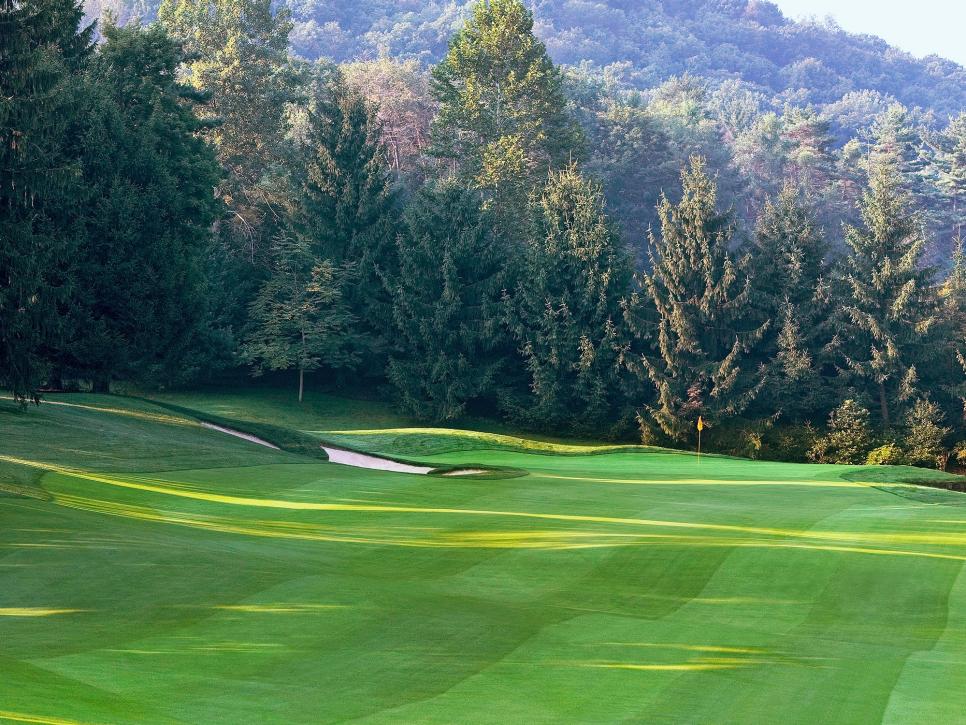
199 . BEACON HALL G.C. | Aurora, Ontario | 7,037 yards, par 72
This was a favorite design of the late Bob Cupp, who routed the front nine in pine-covered glacial terrain and the back nine over and between open moraines and eskers covered in tall meadow grasses, a nine he called a “gentler version of Ireland’s Ballybunion.” Using five par 3s and five par 5s, Cupp provided diversity at every turn, with one green just 4,000 square feet and another nearly three times as large. He made a long approach shot into a moderately sized green with few contours and a short approach shot into a massive green with huge contours. “The major strategy of this course is contour,” he once wrote, “be it a massive slope of a fairway or a subtle angle of a putting surface.”
200 . CALUSA PINES G.C. | Naples, Fla. | Michael Hurdzan & Dana Fry (2001) | 7,203 yards, par 72
Gary Chensoff, a Chicago venture capitalist, survived a rare form of cancer despite long odds, and his recovery strongly influenced how Calusa Pines was designed and built. Chensoff decided to gamble, instructing Hurdzan-Fry to design the most unique course in south Florida despite a dead-flat site. They responded by piling up fill from ponds to form ridge lines up to 58 feet, then planted them with mature oaks, pines and sabal palms. Calusa Pines sports perhaps the firmest, fastest Bermuda fairways and greens in Florida. It has slipped in recent polls, perhaps because its sand bunkers seem tired and in need of rebuilding.
